 |

|
|
 |
2011 JANUARY/JULY |
|
|
 |
 |
Lobos simply can't survive the fierce onslaught of anti-wolf extremists without our help.Your donation will help Defenders: •
Post rewards to help law enforcement capture lawless wolf-killers
and put them behind bars; Please donate now to save something wild and help save struggling lobos. For the Wild Ones, Rodger
Schlickeisen
In
one of its first moves since retaking the reins of wolf management,
Idaho officials last week called in Wildlife
Services -- the federal government's chief wildlife-killing agency
-- to
kill wolves in Federal marksmen took to the skies in Idaho's Lolo wilderness, targeting up to 60 wolves to help artificially boost game populations in the region. Please take action now: speak out against Wildlife Services' aerial gunning of wolves in Idaho. Using
radio collars to track down wolf packs in the area, the airborne
marksmen only managed to kill five wolves. The mission
was quickly abandoned, described as both inefficientand expensive
by the Wildlife Services agents themselves.
Wildlife
Services is a program under the U.S. Department of Agriculture.
Their mission is to "create a balance that allows people
and wildlife to coexist peacefully." But
instead, they have become the federal government's de
facto wildlife hitmen -- heavily relying on killing
wildlife rather than using proven, effective non-lethal methods
of control. Idaho officials claim that wolves are a major cause of ELK declines in certain parts of the state. But
the science says otherwise: In 23 of 29 elk management zones, populations
of these animals are at or above targets.In fact, many of the areas
experiencing declines contain few or no wolves. Take
action now: Together, we can ensure a lasting future for America's wolves. For the Wild Ones,
|
|
A neighbor, Rose, who recalled Jayelin being a "real sweet little kid," said the dogs were kept in a cage. "When you cage an animal and let it out, what do you think it will do? An animal goes wild," Rose said.
Neighbors'
premonitions of doom became reality after 'monster dog' rips apart
little boy "'My
God, they're big, what do you feed them?' " she recalled asking. She would recall eying the biggest of them, the one that would be classified as a mastiff, but was like no other dog she had ever seen. "That thing always has white foam from the mouth, even when it's laying down," she remembered. "I told him, 'You're right, you got monster dogs.'" With size came ferocity that Dread insured with beatings and kicks. He gave Parkinson an unneeded warning. "He told me, 'I don't like anybody touching my dogs,' she recalled. "You couldn't pay me." He
did not want anybody even trying to show his dogs the slightest
kindness.
To
give his dogs monster
practice, Dread hung things on the schoolyard fence
for them to tear apart. Dread seemed delighted when the dogs killed cats, even a pet rabbit. "Those
dogs would kill anything," Parkinson said. "The whole
block was afraid of those dogs." "First time, he came up and punched her," Parkinson recalled. "I told him no. He said, 'My daddy take the dog and go bam!' I said, 'You can't go bam on my dogs. You make nice to the dogs.'" From
then on, Jayelin would gently pet the dogs and show them love. Parkinson
understood that those other monster dogs were a tragedy waiting
to happen, but she still had no premonition of doom as she watched
little loving Jayelin playing outside early Friday evening. "It's not the dog," Parkinson said, "It's the owner."
"He
was trained to kill," Jubeark, a mother of four, was sobbing and hysterical when she returned to the gore-covered apartment after hours of questioning at a Brooklyn police precinct. Later, she absolved her fiancé of any blame.
Jones,
who was working when the fatal attack occurred, brought the Italian-bred
dog home two months ago. The dogs are large, muscular animals
traditionally used to hunt wild boars. The couple was preparing
for both Jubeark's 24th birthday and their June 10 wedding - two
events now linked forever to the horrific killing. Risher and other neighbors said Jones would wear a protective arm guard while training the fierce dogs outside the family's Brownsville apartment. "They
looked mean," Risher said. "Nobody would want to go near
them. They were trained to fight." "It
was a violent dog," said neighbor Anthony Brown, 35, of Machete.
"Dangerous. A big dog. The whole block is scared of that dog." Great-grandfather Jamaal-Uddin said Machete was typically laid-back. "I guess it's just like humans," he said. "It's the quiet ones you have to watch."
Tot
mauled to death by pooch was often alone with killer dog, neighbors
say Neighbors
say Jones, 29, trained his dogs to be killers. Jones has a rap sheet with busts for weapons possession, kidnapping, endangering the welfare of a child and reckless endangerment, records show. Ramos said investigators from the Administration for Children's Services often visited the apartment when the family first moved in two years ago, but the visits tapered off. A spokeswoman for the ACS declined to comment pending the outcome of an investigation.
Ban
The Deed
not The Breed
MOST FEARED
Click √ on icons abobe for additional information
|
|||||||||||||||||||||||||||||||
|
Among the service’s tips for dog owners, besides obedience training and neutering, are these: Take precautions when accepting mail in the presence of your pet, which might interpret the carrier’s actions as a threat. When a carrier comes to your home, keep your dog inside, away from the door, in another room. Dogs that get little attention or handling, or that are tied up for a long time, are especially prone to bite, according to the service.
Alexandra
Horowitz, author of Inside of a Dog Publishers
Weekly
This has real consequences for their well-being. Bradshaw suggests that many of the behavior problems that result in dogs being abandoned or euthanized can be laid at the door of inept training, especially training based on force. What
matters, he says, is how dogs actually learn. Bradshaw provides
a wellgrounded overview of the Canis family’s evolutionary journey.
He also considers dogs’ brainpower, emotional states, sensory
capacities and problems that come with breeding for looks rather than
temperament. Click √ on book cover to order from Amazon.com
Bradshaw says dogs naturally want to please and play with people, especially the people who love them. "[When
a puppy's eyes open it has] a very strong ability to learn about people
and ... this behavior persists throughout life," he says. "And
surprisingly, most dogs, given the choice, will actually prefer human
company to other dog company." Bradshaw
says humans also expect dogs to be companionable when they're needed
and unobtrusive when they're not. City dogs, he says, are expected
to be better-behaved than the average human child and as self-reliant
as adults. But these expectations, he says, create problems for modern
dogs. Click
√
here
Photos:
Ellison was deployed three times to Iraq and Afghanistan with war dogs between 2004 and 2009. Her
favorite perky companion, a German shepherd named Riki, detected
mountains of illegal drugs, including marijuana, hashish and opium,
while on the job. |
|
HAPPY
BIRTHDAY,
Click
here to send your message! Francis
Battista
Well, they're together crossing RAINBOW BRIDGE.
Rhona
Levy photo: ANGEL CHEVRESTT
“Suddenly I’m not at peace anymore,” Rhona Levy of the Bronx said Friday. “You want to be with the people you are closest with, your true loved ones. The only loved ones I have in my life right now are my pets, which I consider my children.” Levy,
61, said she has no backup plan and is hoping the state order will
be reversed. However, Martin says the pet cemetery is a private, for-profit business. And the Division of Cemeteries’ own website says private cemeteries do not fall under its jurisdiction. “It
seems ridiculous we can’t do it,” Martin said Friday.
“As of now, we’ve suspended the human part of it, but
it’s our position that they don’t have the authority to
do this.” He said the service was an accommodation for customers
and never raised significant revenue. “The law is clear,” she said. “There’s no authority for this board to just arbitrarily impose nonprofit corporation law on a privately incorporated for-profit business. … If I have to file a lawsuit, then I’ll file a lawsuit.” “My
uncle wants to be buried beside his wife and what he considered to
be his children and I’m not letting The state position could disrupt Martin’s own plans. He said earlier this year he hoped his ashes would be added to a family plot, including a dog, at Hartsdale. PHOTO
CREDITS
Baby, a 1-year-old pit bull-terrier mix, got the worst of it, taking 10 paintball hits, including three to her face. Birdie (below right), a 3-year-old pit bull-mastiff mix, took five shots.
Wojcik, 32, said he was in the shower when he heard a "tat-tat-tat-tat"
noise. "Then, I heard Baby squeal like a pig and When Wojcik complained about the dogs' injuries, he said, Lacin replied, "Your dog is not dead. What are you worried about?"
Lacin was arraigned yesterday on charges of reckless endangerment,
criminal mischief, weapon possession and injuring and torturing animals.
He was freed without bail. His lawyer, Elizabeth Latimer,
said the charges should be dismissed. Photo
Credits
But then Mr. Prather switched to a more lucrative market.
He and others in the high-end dog training business say prices have
shot up thanks to the growing number of wealthy people around the
world who like the security — and status — provided by
a dog with the right credentials. Moguls and celebrities now
routinely pay $40,000 to $60,000 for a well-bred German shepherd that
is certified as an expert in the sport of Schutzhund,
which means “protection dog.” The price
can go much higher if a dog does well at an international championship,
as Julia did. But $230,000? “It’s
a lot of money,” he said matter-of-factly. “It’s
the speed, the smartness, the quickness — and you would not
believe the roughness that she has inside. She’s like a little
pit bull when she bites. She has that model face, and then opens the
gums up and lets you have it.” Julia’s was a controlled ferocity, which trainers distinguish from the anger manifested by ordinary dogs. When two dogs try to intimidate each other, they stiffen, growl, bare their teeth and stare intently. Protection dogs are trained to continue looking around and protecting their owners, not establish their own dominance. And, when commanded, they are supposed to switch instantly from attack mode to pet mode. “The
dog has to get along with children,” Mr. Prather said.
“The client is often a guy on his second family. He travels
a lot, leaves his wife alone with the kids in a large house —
maybe 30,000 square feet, so big you don’t even know what’s
going on at the other side of the house. He wants peace of mind and
a dog that his wife can handle. We don’t sell tank-stoppers.” Click √ on KRAFTWERK logo for website
If these people need a status security system, they could spend a fraction of that on a well-trained protection dog and have money left over to donate to one of the many worthy rescue groups trying to save abandoned and stray animals from the dire fates that await them on the streets or in kill shelters.
JUDITH ZINN
The
black Lab puppy named Phoenix suffered third-degree
burns over 40% of his body and lost his ears in the horrific attack,
An adult relative of the teen is also being charged with animal neglect for failing to get the dog medical care. Maria Alarcon (right) waited a day before taking Phoenix to a vet, police said. The 43-year-old claimed she did not get the dog help sooner because she couldn't afford it.
Photo of Pit and puppies: KEVIN R. WEXLER
About the Author: Casey Lomonaco graduated with distinction from the Karen Pryor Academy for Animal Training and Behavior. She owns Rewarding Behaviors Dog Training in Binghamton, NY. Keep up with Casey by visiting Dogster's Dog Training Guide. Two worthwhile COOLERS to look into for your Dog in heat
The Health Department estimates there are 500,000 dogs in the city. Among
those she introduces are “Lenny, the world traveler; Scheki,
the three-legged beauty rescued from Israel; Charley, the certified
Delta Dog; Daisy, whose eyes inspired Roberta Flack to stop and sing
to her; Gertrude, a pit bull mix who was “Let Maine have its moose and Florida its manatees! In the heart of Manhattan, it takes a dog to understand the beauty of autumn leaves, the thrill of new-fallen snow and the promise of flowers on a rainy spring day.”
Even as the economy for us humans bogs down again, the pet economy has proved remarkably resilient to a weak housing market, high unemployment and those diminished 401(k)’s. The industry has continued to grow through the recession, albeit at a slower pace, and last year, Americans spent a record $55 billion on their pets, according to the market research firm Packaged Facts, more than the gross domestic product of Belarus.
Wherever the stock market goes — and lately, it has been going
down — this nation seems to be in the thrall of a great bull
market for pets. And high-priced, “human grade” pet food
is only the beginning. “What you can do is make some pies out of it, and leave the cans on the counter after everyone has eaten to freak people out,” Mr. Stockton says.
Canine Caviar Foods says it makes “the
only alkaline-based dog food in America that was specifically designed
to prevent cancer.” The ingredients include canned
beaver, duck and venison tripe for dogs and cats, as well as a variety
of “free-range, grass fed buffalo” treats for dogs. Mr. Terry, however, isn’t about to pop a Snausage into his mouth. The
idea of eating your dog food to prove its wholesomeness didn’t
originate at the Global Pet Expo. Paul Newman sampled his organic
dog food on “The Tonight Show” in 2006. The audience howled. The
gimmick generated a huge spike in sales but came at a price: relentless
ribbing from friends. Global Pet Expo photos: Gary Bogdon for The New York Times
But his neighbor across the hall in Crown Heights said the dog has its own issues with stress. "You know how dogs suffer from separation anxiety?" said Troy Benning, 32. "The dog is always in the apartment barking. He's not with the dog all the time.
No
special equipment needed "Dogs really are nature's personal trainers," Marcus told the Pittsburgh Post-Gazette. "They model fitness behaviors, and behaviors for eating and socializing, too." Dogs
are always eager to go for walks, she said. "Unlike your
human exercise buddies, dogs are not going to beg off"
if the weather is bad.Following our dogs' example Click √ on book cover to order from Amazon.com
Down the block came a major tug. Some large Labrador, whose parents obviously neglected his lunch, was eating through her ham and cheese with tomato and mayo and already barking for seconds on the sponge cake. Only in New York, kids, only in New York.
Now scientists have gotten an important clue, finding a close relative in an unexpected host: dogs. The
discovery, published in Proceedings of the National Academy
of Sciences, “represents a major step forward,”
said Dr. Holmes, who was not involved in the research. The finding
came as a surprise to all the scientists involved. Researchers at
Pfizer were investigating virus outbreaks in dogs
in shelters across the United States. They swabbed the noses of dogs
sick with respiratory diseases and searched for viruses. In some cases
they could not isolate a known virus, so they sent samples to the
Center for Infection and Immunity at Columbia University,
where researchers specialize in finding new viruses. A third possibility — one favored by Dr. Kapoor — is that the virus started in dogs, and then evolved into a liver-infecting disease in humans. “The
evidence we have favors an origin in dogs,” Dr. Kapoor said.
A
miracle dog who was sucked away in a deadly Alabama tornado crawled
back to the ruins of
The owners, who lost nearly everything in the twister that devastated
North Smithfield on April 27, burst into tears upon seeing
their dog, Mason, perched on what was left of their
front porch.
If
you’re interested in the effort to rebuild the statue you can
e-mail Smaldon at Photos: Steve Smaldon
Both animals reach into liquids with the tips of their tongues,
pulling up a long column. Before the liquid drops back down, they
open their mouths and pull it in. Click √ on image above right for video Rodin's
Brew photo: From-TheDoghouse.com/SCOOP & HOWL
Of course, I didn’t, and I wouldn’t.
I care about my career and I have no idea what other stressors Betty
faces in her life. But gosh, it does look good from here. Those dog
walkers really have it made. Their clients are generally sweet and
entirely nonverbal, the best ones only walk a couple of dogs at a
time, and there will never be a shortage of 9-5ers who can’t
take care of their dogs’ daytime Photo credits Top left: Gus with Nina Above
right: Our walker Janine with manfriend Seiko, pooches Gizmo (floor)
and Poochie (lap)and Daddy Bob (avec moi on the apron) at one of our
many summer BarK-b-Q pawties |
|||||||||
You’ve
heard of on-set romances where the stars fall madly in love …
well, such was the case with McGregor and Cosmo. Though
Cosmo was destined to return to his companion, animal trainer
and guardian Mathilde De Cagny (below left), this story
has a happy ending: McGregor finds his own canine soul mate. Watch for Beginners, in theaters June 3. Click √ here
Click √ on image above for information on KOOL COLLAR
*
"Beware
the beast Man, for he is the Devil's pawn. Alone among god's primates,
he kills for sport or lust or greed. Yea, he will murder his brother
to possess his brother's land. Let him not breed in great numbers,
for he will make a desert of his home and yours. Shun him; drive
him back into his jungle lair, for he is the harbinger of death."
One is called Post-Rapture pet care, co-anchor Rebecca Jarvis pointed out. "Yeah,
we've actually seen a number of pet services pop up,"
Kurtz said. "I guess we could call this 'the Rapture stimulus!'
We see this a lot of times with big news events like this." "I think, you know, if you really are worried about this and it helps you sleep at night, at least for the last night ... then taking care of the family dog is priority number one!"
Click
√ for your Dog's Rapture info
“This
is a very sweet dog,” said University of Maryland
Medical Center spokeswoman Karen Warmkessel. “When
I saw him today, he looked great. He was really active, and now
he’s raising money for cancer research.” Dozer even has his own bib number — K9.
|
|
At
Fort Campbell, one of the nation's largest military
bases, Obama met privately yesterday with members of the assault force
that carried out the mission to get bin Laden, thanking each one individually
for their "heroic and selfless service" to the country.
ABOUT
GERRY PROCTOR Click √ on images for Q & A Conversation
The
bonds that grow in battle between the Labs and their Marine handlers
are already the stuff of
“The
first place he went was Colton’s room,” Mrs. Rusk said.
“He sniffed around and jumped up on his bed.” “I think people go weak at the knees for these dogs,” Ms. Frankel said in an interview. “I do, too. But their contribution is significant. "These are serious dogs.” Click √ above for Rebecca Frankel's "WAR DOGS" photo essay PHOTO
CREDITS
Animal
Rights Activists Rally As Newark Woman Accused Of Starving, Dumping
Patrick The Pit Bull, Appears In Court She’s calling for a stiff sentence. Click
√
here Above left - Patrick on April 8, 2011 (credit: The Patrick Miracle/Facebook)
Under current state law, shelters are only allowed to adopt
dogs and cats out to individuals. Rescue groups are typically turned
away and denied access to the shelters. “How we get
around this is we adopt it to the person coming from the rescue group
and this allows shelters to have a great amount of power,” Kellner
said. “There are tens of thousands animals in New York State shelters waiting to be adopted and most are healthy, well-behaved, and just in need of a loving home,” Kellner said. “When a humane organization volunteers to take these animals, they should not be denied.” California
passed a similar law in 1998 which allowed animal rescue
and adoption organizations request possession of an animal prior to
its killing. Last year, Delaware passed a law that seeks to
find sheltered animals homes rather than euthanize them. The bill would not only guarantee rescue groups access to shelters but it would also ensure that the animals receive proper care – including fresh food and water on a daily basis, clean living environments, exercise and veterinary care.
Routine inspections would be mandated under the bill.
Here's a link to the NY State Assembly members and their contacts. Click √ on banner below |
|
America’s
Premier K9 Training Event
Click
√
on any image for Web Page |
Visit the Mutt Census site to find the top breeds detected in mixed breed dogs, feeding and activity details, and much more listed by state. Click √ on logo above.
In
a shelter on Kongning Road in Zhabei district, confiscated dogs
must be adopted within 30 days People who already own more than one dog and registered them before the new law came into effect are allowed to keep their dogs. "For many dog owners who have more than one dog, it is too hard to make the decision to keep one but abandon another," Lai Xiaoyu, the head of the China Small Animal Protection Association Shanghai Branch, told the Global Times. The regulation also includes a code of conduct for dog owners.
And as a bonus, leashed dogs and cats are welcome, so that four-legged friends can join in the fun.
The NYC Pet Show
will take place on Saturday, May 21 and Sunday, May 22, 2011 from
12:00pm -- 5:00pm at the Metropolitan Pavilion, located at 125 W.
18th Street.
Evacuation Planning for Pets: Are You Prepared?
Illustration:
Troy Griggs/The New York Times
Pictured: Frankie the chihauhua — the abused animal was rescued in a raid in Yaphank in June and is now awaitng adoption at a rescue shelter in Farmingville (Photo/Mona Rivera)
It is up to the Border collies to keep their focus off Prospect Park. On
a recent afternoon, Mr. Graziano, vice president of operations
for Goose Busters, and another dog, But when the geese leave Prospect Park, where do they go? “Someplace else,” Ms. Lloyd said. They often head to the nearby Green-Wood Cemetery. Ken Taylor, a cemetery official, said two kites that look like eagles were used there to chase the geese away — and back to Prospect Park. It
remains to be seen whether Cleo, named for her resemblance to Cleopatra,
proves scarier than the kites, but Mr. Graziano appeared confident.
“They’ll leave the park,” he said. But Cleo will be the linchpin in the goose fight. “They see the dog,” Mr. Graziano said. “They don’t want to be anywhere near it.”
I WANNA BE A BIRD-DOG TOO! Samantha
photos: Eric Michael Johnson for The New York Times
Unable to find anyone to take her, workers decided euthanasia was the only option, until a call from Irwin saved Lady Bug’s life. “I
believe that all things happen for a reason,” Hadley said.
“Fate brings animal people together to make a difference.
Lady Bug is one lucky girl.” Algonquin resident and
Animal House Shelter volunteer Lynn Nowinski recently made
a donation to help the dog’s cause.
Saving dogs like
Lady Bug gives animals that have been abused their entire lives
a chance to be loved, Irwin said. To help with Lady Bug’s rehabilitation or inquire about adoption, go to www.animalhouseshelter.com or call 847-961-5541.
|
 |
5 5th ANNIVERSARY |
|
The
training of dogs in Navy Seal teams and other Special Operations units
is shrouded in secrecy. Maj. Wes Ticer, a spokesman
for United States Special Operations Command, said the dogs’
primary functions “are finding explosives and conducting searches
and patrols.”“Dogs are relied upon,” he
continued, “to provide early warning for potential hazards,
many times, saving the lives of the Special Operations Forces with
whom they operate.” Suzanne Belger, president of the American Belgian Malinois Club, said she was hoping the dog was one of her breed “and that it did its job and came home safe.” But Laura Gilbert, corresponding secretary for the German Shepherd Dog Club of America, said she was sure the dog was her breed “because we’re the best!”
|
Happy
Mother's Day!
This Mother’s Day, while honoring our own moms, let’s take a moment to remember dogs like Binah, who are forced to spend their entire lives confined in puppy mills.
|
|
|
If the PMCPA is gutted in Missouri, your state’s puppy mill law might be next. The fate of millions of dogs now hangs on the decision of one man. The ASPCA implores all of our supporters to contact everyone you know in Missouri; ask them to call Governor Nixon to urge him to veto SB 113 (please do not call the governor if you live outside Missouri). You can also help by spreading the word about this injustice—please share this article via Facebook and twitter.
UPDATE
The
agreement, which will nullify Prop B, allows the stacking of cages,
leaves temperature, exercise and veterinary care requirements unenforceable,
allows female dogs to be bred at every heat cycle with no rest between
litters, and places no limit on the number of dogs a breeder may keep.
Most significantly, it does not set specific standards, but defers
to those set by the Missouri Department of Agriculture—which
is free to change or lower these standards at will. You
can help by continuing to spread the word—please share this
article via
RELATED
Yet if some state legislators have their way, horrific but valuable videos like that one will never be made.
But, first, the
story: The root problem is not Espenson or his company, any more than the root problem at Abu Ghraib was Lynndie England. The problem is the system that enables cruelty and a lack not just of law enforcement but actual laws. Because the only federal laws governing animal cruelty apply to slaughterhouses, where animals may spend only minutes before being dispatched. None apply to farms, where animals are protected only by state laws.
The way most animals are handled in the United States right now has to have all of us omnivores wondering the same thing.
|
|
The
law’s purpose is to base protections on science. Now that
politics has been allowed to trump science when it comes to the
gray wolf, which species will be next?
The
wolf has been a subject of litigation ever since it was
reintroduced in the mid-1990s. One of Mr. Salazar’s
For the sake of his own reputation as a conservationist, Mr. Salazar has to hope that Congress’s meddling stops with the wolves.
THE PRIZE
$150 for a Wolf's leg |
|
“Probably the dog,” she said. |
Click
√
on any image for Web Page |
||||||||||||||||||||||
|
Expectant
dog owner Chen waited nervously. Photo of Jazz with officers: WILLIAM MILLER wtkr
• com "The kennels will stay as they are in the black sheds.People can come and visit and it should bring some education to the area and a voice for the dogs," said Monica.
Beware of any site that sells medications without requiring a veterinarian’s prescription. The
F.D.A. also recommends that consumers look for sites accredited as
a Veterinary-Verified Internet Pharmacy Practice Site, part
of a voluntary accreditation program. Dr.
Murray suggested putting away a little each week until savings reach
$2,000 to $3,000.
Thisbe’s
story represents a larger, grim reality that has developed in recent
years: “You step
outside of the city, and it really changes,” said Calla
Felicity, who works at Rocket Dog Rescue,
a Bay Area animal rescue service. But it is not the city’s love of pets, but rather its breeding control that some credit for the vivid difference in animal welfare. For
the past 20 years, the city has had an aggressive policy of spaying
and neutering dogs and cats. Surgery is often underwritten to be free
or low cost, and most rescue services and shelters require the procedure
before a “In
rural and poorer areas it could be a matter of means,” said
Jennifer Scarlett, a veterinarian and co-president of the San Francisco
S.P.C.A., noting that spaying and neutering costs about $300 per animal.
“Some people simply don’t have access and resources.” We had all just started to get to know her, and then she was gone. No one has been
held accountable for what happened to Thisbe and her family, and most
likely never will be. She came
from Fresno. The euthanasia rate there is
47.4, one of the worst in the state.
•
If you have a cat, keep him indoors. This will provide nearly complete
protection against the vegetative pests.
“Organized dog fighting is a brutal form of animal abuse where dogs are exploited and forced to fight as their owners profit from their torture,” says ASPCA Animal Fighting Specialist Terry Mills (right). “We are determined to protect our nation’s animals from this form of cruelty.”
All 41 dogs have been taken to an undisclosed location, where veterinarians
will examine their medical conditions and temperaments.
Experts warn people not to run away if a coyote is sighted, but to make noise and make it leave. Running, they said, makes a human look like prey. Photo: Ezra Shaw/Getty Images
A Google representative said the application was "removed based
on a trademark infringement complaint" but did not immediately
say whether the app would be sold again if those issues were resolved.
But Weber urged Page to ensure that Dog Wars was permanently
muzzled, particularly at a time of increasing violence nationally
against police officers. "We are in fact animal lovers ourselves," the email said. "This is our groundbreaking way to raise money/awareness to aid REAL dogs in need, execute freedom of expression, and serve as a demonstration to the competing platform that will not allow us as developers to release software without prejudgment." Although the application has already been taken down, Kage Games has told some media outlets that it removed Dog Wars to work on updates, which may indicate that the game will be rereleased soon. Click √ below to sign petition |
|
“Dogs are dogs,” she added.
That may be, but that doesn’t mean they’re allowed to
show it, especially not in the oh-so-carefully controlled
and scrutinized upper echelons of society. Making
matters worse, he said, is the fact that owners don’t discipline
the dogs themselves. Instead, they throw money at them, expecting
a specialist to fix the problem. It’s a good thing Mr. Kihn wasn’t asked to bring Hola to his Riverside Drive co-op board before moving in. “We just lied and told them she was medium-size and mellow,” he said.
Others should have it so easy. To get past highly selective co-op
boards, the desperate turn to Elena Gretch, founder of But all of it that, she added, is nothing compared with the scrutiny of a high-strung co-op board. “When you have to charm so many people, it’s really intimidating,” she said. It’s a good thing dogs don’t have to apply to private schools. Click √ on cover to order Bad Dog (A Love Story) from Amazon.com
Click √ on JOURNAL cover for full report
“Gernhardt
said Ava nipped her son last year.”
Dogs
react aggressively to signals of fear and, according to NorthJersey•com,
little Isabella Gernhardt was hiding behind her mother. Isabelle,
who is allergic to canines, stays away from the dog, Isabelle’s
mother Elizabeth Gernhardt, said, adding that her daughter was not
playing with Ava. “She has never played with that dog, she won’t
even pet the dog.”
“TEACH
YOUR CHILDREN WELL!”
The
decision spared Ava’s life, but cost Molly
her beloved companion. “We
didn’t want the dog put down. We wanted it to go somewhere it
could be of use. We just didn’t want it back in the neighborhood,”
said Mike Gernhardt, the injured girl’s father.
The Rienels believe the same person who robbed their house the first time is also the person who stole Pookie. Pookie weighs about 14 pounds. She’s missing two or three of her front teeth. The Rienel family said they won’t press charges against anyone who brings Pookie forward. They just want their dog back.
The politicians said their proposal could help promote the adoption and care of over 12,000 dogs currently in City shelters. Photo
Credits: MORE
“The
reason why it’s the rescue dog is because the rescue dog fits
with New York so perfectly,” Kellner said. “New Yorkers
are scrappy just like rescue dogs, we often both have a bone to pick
and a lot of us are mutts. So, this is a perfect fit.” “It’s time that we throw these dogs a bone.” Photo credit: Stan Brooks/1010 WINS
PINKY
GETS GROOMED Photo: Chester Higgins Jr./The New York Times
Teaching dogs to respect plants is not impossible, even for the most manipulated owners — like those who tell me their pet is the one holding the leash. Oh really? I am quite positive that Miffy, given the option, would actually prefer to pee in the apartment rather than outside of it, yet you have persuaded her not to.
NYTimes illustration, above right: P. C. Vey
ONGOING Police
Continue Search For Family Of Dog Found On LIRR Train GOOD NEWS!
Thankfully,
it appears he had a round-trip ticket: Train Hopping Dog photo credit: Long Island Veterinary Specialists
Keep
your dog hydrated If your dog is not socialized, try enrolling in a dog training class.
Minor League teams often have Dog Day Games as well so check for those too.
Atlanta
Braves - Bark in the Park: May 2 vs. Houston and August 29 vs. Florida Florida
Marlins - Bark at the Park: April 30 vs. Washington |
Cousin
Pugsley has arrived at
Click
√
on image above for MEMORIAL |
|
You
can send your donations via PayPal to Click
√
on Patrick's photo for FOLLOW UP
The
investigation is still ongoing and anyone with information can call
the tip line at Photo: Jennifer Brown/The Star-Ledger ONGOING
Newark
Woman Accused Of Starving, Dumping Pit Bull Pleads Not Guilty
Authorities say Curtis tied the dog to a railing in her Newark apartment building and left the state for more than a week. A janitor later found the emaciated dog in a trash bin. Curtis’
mother was in court Thursday and said her daughter was in Albany,
N.Y., when the dog was believed to have been abused. “He’s walking, which is a big symbol of hope, because he couldn’t walk in the beginning,” Assisstant Prosecutor Cheryl Cucinello said.
Click
√ on images to view |
|
While the language on the Rocky Mountain wolves was a tiny item in budgetary terms, environmental groups said it set an unnerving precedent by letting Congress, rather than a science-based federal agency, remove endangered species protections.
The rider is the first known instance of Congress’ directly
intervening in the list. While Congress overrode the protections
extended to a tiny Tennessee fish called the snail darter about two
decades ago, it did so by authorizing the construction of a dam that
had originally been tabled to protect the fish. In that case, Congress
did not overturn scientists’ findings about the fish’s
viability. The rider also precluded judicial review of this provision. The
wolf issue has great political resonance among the ranchers and hunters
of Montana. The first group is concerned about livestock;
the second about declines in elk and moose herds. Senator
Tester is up for re-election in 2012.
Photo top left: US Fish & Wildlife, via Associated Press
Photos |
We
 |
 |
![]()
|
Please consider donating to the following groups that are in desperate need of funds for supplies and assistance: Japan
Earthquake Animal Rescue and Support World
Vets, www.worldvets.org Animal
Refuge Kansai |
|
|
POLICE  STORIES
STORIES
Sheriff's office K-9 Kane killed in the line of duty Fleeing suspect allegedly stabbed veteran police dog By Bob Albrecht from The Columbian Clark County WA April 2, 2011 Just one year from retirement, a Clark County Sheriff’s Office canine was fatally stabbed shortly after midnight 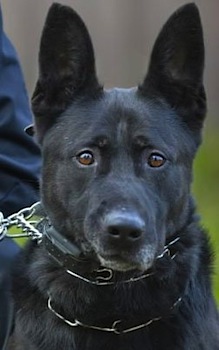 Saturday.
Kane, who worked as a police dog for six years, was
transported to and Saturday.
Kane, who worked as a police dog for six years, was
transported to and 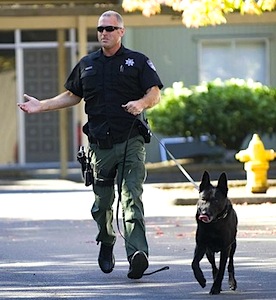 then
pronounced dead at St. Francis Animal Hospital. then
pronounced dead at St. Francis Animal Hospital.Deputies spotted two people driving in a vehicle with stolen license plates in a cul-de-sac near Heritage High School, said Sgt. Scott Schanaker, a sheriff’s spokesman. They followed the vehicle south to the intersection of Northeast 76th Street and 117th Avenue. At one point, the driver allegedly tried to ram a patrol car before both people got out of the stolen vehicle and fled on foot. As the pair ran, Kane tried to detain one of them and was stabbed, according to a news release. A commenter on The Columbian’s website claiming to have heard the incident over a police scanner wrote that Kane had caught somebody and was stabbed. He then grabbed the person a second time and was stabbed again. Another commenter wrote that Kane was stabbed near her house. “(Kane’s) cries will haunt me for a long time,” wrote someone using the username “tj.” Deputies said the suspects in the incident were taken into custody after the Southwest Washington Regional SWAT Team was called to assist deputies, Vancouver police and Washington State Patrol. There were no other injuries reported.  Keegan
H. Graves, 31, of La Center (left) was arrested on suspicion
of harming a police dog, auto theft and attempting to elude a police
officer. Natasa M. Cresap, 22, of Yacolt was arrested
on an outstanding Department of Corrections warrant. Keegan
H. Graves, 31, of La Center (left) was arrested on suspicion
of harming a police dog, auto theft and attempting to elude a police
officer. Natasa M. Cresap, 22, of Yacolt was arrested
on an outstanding Department of Corrections warrant.
Harming a police dog is a Class C felony, according to state statutes. A Class C felony is punishable by up to five years in prison and a $10,000 fine. An
investigation by the regional crimes unit is ongoing.
"We are going to get a motorcycle with a side car. He's expressed interested that he wants to travel around the neighborhood, so I guess that is what we're going to do," said Grandberg.
The new law means people could be sentenced to up to two years in prison and pay fines of up to $5,000 if they intentionally injure or kill a police dog. MPR Photo/Tom Scheck Click √ on any image for Web Page |
||||||||||||
|
Click √ on covers to order from Amazon.com |
|
About the book’s accuracy he said: “I have always assumed that to some degree it’s a work of fiction. Steinbeck was a fiction writer, and here he’s shaping events, massaging them. He probably wasn’t using a tape recorder. But I still feel there’s an authenticity there.” He added, talking about Mr. Steigerwald’s discoveries: “Does this shake my faith in the book? Quite the opposite. I would say hooray for Steinbeck. If you want to get at the spirit of something, sometimes it’s important to use the techniques of a fiction writer. Why has this book stayed in the American imagination, unlike, for example, Michael Harrington’s ‘The Other America,’ which came out at the same time?” In
2010, Bill Barich (below) published “Long
Way Home: On the Trail of Steinbeck’s America,”
an account of his own In some ways, Mr. Barich went on, Steinbeck’s view of America was much darker than he let on in the book. “The die was probably cast long before he hit the road,” he said, “and a lot of what he wrote was colored by the fact that he was so ill. But I still take seriously a lot of what he said about the country. His perceptions were right on the money about the death of localism, the growing homogeneity of America, the trashing of the environment. He was prescient about all that.”
Photo,
top left:
The confusion stems from a variety of sources, one of which no doubt is the perception that there are minimum standards that must be met for dog food to qualify as "senior." Although
professional organizations do stipulate requirements for pups and
adult dog food, the Association of American Feed Control Officials
and the National Research Council have no such requirements
for food marketed for aging or "mature" canines (beyond
what's required for adult dog food). The study authors also advised talking with a veterinarian, noting that every "senior diet" for dogs is different and may or may not be appropriate for a particular dog, depending upon his overall condition and health.
The two remaining dogs, Boss and Buster, are certainly adoptable, she said in a telephone interview. She
accused Animal Care of using the Bronx dogs as draws for fund-raising
— noting the plea on its Web home page for donations to help
“recent victims of the apartment fires in the Bronx”
— without trying fully to save the remaining dogs.
Photo:
Michael Appleton for The New York Times
Redd is currently in a foster home where he's really flourishing. Catch up on the latest in Redd's journey by joining the new Adopt Redd facebook page. Welcome! Photos by Molly Wald
In
2008, Mietje Germonpre, a paleontologist at the Royal Belgian Institute
of Natural Sciences, and
Germonpre told Discovery
News that it's unclear
now whether these much smaller French dogs descended from the European
Paleolithic stock of large dogs, were introduced from elsewhere,
or resulted through selection for a smaller body size. Germonpre
pointed out that larger dogs, more contemporaneous with the earliest
known French dogs, are known from sites in Russia and the Ukraine.
"This suggests that different types of dogs occurred in Europe
at the end of the last Ice Age," she said.
Stills: 1010wins/All for Animals
A documentary about Gene Sharp, “How to Start a Revolution” directed by Ruaridh Arrow, is expected to premiere in spring 2011. Click
√ above for preview
“I’ve always found library books to be therapeutic. But maybe that’s just me.”
“It’s important to secure garbage which is a primary food for them. Bird feeders not only provide a source of food, but they draw off the kind of animals, rodents, and birds and things like that, that the coyotes will feed on. And leaving pet food outdoors is also a bad thing,” Connors said. Police will use pepper pellet guns to scare off coyotes. If that doesn’t work, Connors said they’ll turn to traps. Photo: Ezra Shaw/Getty Images
In
a draconian move, the shelter will no longer accept telephone inquiries
on shelter animals. You read that right. If your dog is lost
and you want to know if someone turned her in? You'll have to send
your request via email, or through the U.S. Postal Service, and wait
for one of the shelter fat cats to get back to you while your dog
barks until she's hoarse in a packed kennel area as her time runs
out. A group of local activists has started a Facebook campaign called Hope for Hempstead Shelter to do exactly that.
But meanwhile, the issue of Ms. Horan needs to be resolved in a way that demonstrates that the town of Hempstead takes animal cruelty seriously.
For the animals' sake, let Town Supervisor Kate Murray know that you stand with them. Follow-up
Many
animals activists brought along their pets as they waved banners demanding
changes in practices and policies at the shelter. The rally, organized
by the group Hope for Hempstead Shelter, was in part
sparked by a Youtube
video released earlier this week. The video, said to be several years
old, shows a shelter official, Patricia
Horan, saying “kill the kitty, kill the kitty,”
before a kitten was euthanized. BACKGROUND
STORIES
In a news release, The Town of Hempstead addressed the Youtube video along with the allegations of abuse and said town officials were “shocked” by it. They also called the video “appalling” and pointed out that the acting shelter director seen in the video was reassigned pending an investigation.
One woman at the rally said that the shelter was prohibiting animal
rescuers from entering and trying to help. “There’s people
in the community that are begging to go in there to help. Even if
it is to walk the dogs,” she said. Photo: Rashed Mian
The most common periodic fever among humans is known as familial Mediterranean fever. It tends to affect people of Mediterranean and Middle Eastern descent, and there is no cure. Photo: Franz-Peter Tschauner/European Pressphoto Agency
|
|
With any luck, Tasker is going off into the next world with a dear, devoted dog who didn’t want to give up his rightful place at his best friend’s side… Photo: MoD/PA Wire
Karl, who has since split from his wife, said: 'I can see the humour in death and burials, it doesn't bother me. 'I don't have any family now - my dog Charlie has been my only companion for 15 years - so I haven't got anyone else to do the funeral for me.' Rossendale Pet
Crematorium has more than 2,500 animals, ranging from small birds
and hamsters to horses, buried in its Crawshawbooth grounds. Manager
Russell Gray said: 'It's a very special and peaceful place, which
is why many people choose it for their pets. In many ways it's much
better kept and loved than a human cemetery.' Photos: Manchester Evening News Syndication
Irish
Terrier
Irish
Wolfhound Kerry
Blue Terrier Soft
Coated Wheaten Terrier Irish
Red & White Setter All photos by Mary Bloom © AKC®
Click √ on image at left to get a free emergency pet alert sticker for your home.
|
|
HAPPY BIRTHDAY, BABY FRIDA ¡¡¡¡¡¡ Photo Credits: CFCoane/From-The-DOGHOUSE.com/SCOOP & HOWL |
“The
big bone of contention was that my mom and my sister thought that
he was too smart to be treated like a dog; they thought he was a person
and should be treated as such — well, spoiled,” said
Danielle, a Florida woman who asked that her last name not
be published to avoid more family pet strife. “The dog remains
to this day, 10 years later, a source of contention and anger.” Such differences often emerge only after a family has adopted a pet, and they can exacerbate the more mundane disagreements about pet care, like how much to spend on vet bills, how often to walk the dog, how the animal should interact with young children. The fallout from such conflicts isn’t hard to find: Most everyone knows of couples who have quarreled over pets, or even divorced, because her spaniel nipped at his Rottweiler. And
there are countless single people out there all but married to some
hairy Frida or Diego — banishing any potential partner who doesn’t
fall quickly, and equally, in love. “Families either figure it out and manage these differences,” Dr. Terrien said, “or they give up the pet — which happens far more often than people think.”
As
Dr. Fine describes one of his first and most inspiring cases, 5-year-old
Diane was brought to him because she recoiled in
fright from strangers, and though she spoke at home, she
refused to speak to anyone else, including her kindergarten teacher.
A trained therapy dog named Puppy eventually broke the back of her
selective mutism. Diane was petting Puppy, smiling and content,
when Dr. Fine gave the dog a signal to walk away. Diane was crestfallen,
and seeing the girl’s distress, Dr. Fine told her that all she
had to do to get the dog back was to say, “Puppy, come.”
Softly, the child said, “Puppy, come, please come, Puppy.”
That incident became the bridge Dr. Fine needed to help the child
overcome her socially disabling problem. In
another case in which a child was told where — and where not
— to touch the therapy animal, the child opened up about being
inappropriately touched, sexually abused, by a family member.
Dr.
Reeves, who owns two Labrador mixes named Cadbury and Bella, said
he was not surprised. “There is exercise that gets done in this
household that wouldn’t get done otherwise,” he said.
“Our dogs demand that you take them out at 10 o’clock
at night, when it’s the last thing you feel like doing. They’re
not going to leave you alone until they get their walk in.” “There is still a lot more dog walking that could be done among dog owners,” Dr. Reeves said.
“They help themselves by helping the dog,” said Dr. Johnson, co-author of the new book “Walk a Hound, Lose a Pound,” to be published in May by Purdue University Press. “If we’re committed to a dog, it enables us to commit to physical activity ourselves.”
“She draws the whole family together,” said Pamela Fields, 52, a government specialist in United States-Japan relations. “Even when we hate each other, we all agree that we love the dog.” Her husband, Michael Richards, also 52 and a media lawyer, explained that the name Bashert comes from the Yiddish word for soul mate or destiny. “We didn’t choose her,” he said. “She chose us.” Their 12-year-old daughter, Alana, said, “When I go to camp, I miss the dog a lot more than I miss my parents,” and their 14-year-old son, Aaron, said, “Life was so boring before we got Bashert.” Yet Bashert wasn’t always adored. The Washington Animal Rescue League had retrieved her from a notoriously abusive puppy mill — the pet industry’s equivalent of a factory farm — where she had spent years encaged as a breeder, a nonstop poodle-making machine. By the time of her adoption, the dog was weak, malnourished, diseased, and caninically illiterate. “She didn’t know how to be a dog,” said Ms. Fields. “We had to teach her how to run, to play, even to bark.”
Stories like Bashert’s encapsulate the complexity and capriciousness
of our longstanding love affair with animals, now our best friends
and soul mates, now our laboratory Play-Doh and featured on our dinner
plates. We love animals, yet we euthanize five million abandoned cats
and dogs each year. We lavish some $48 billion annually on our pets
and another $2 billion on animal protection and conservation causes;
but that index of affection pales like so much well-cooked pork against
the $300 billion we spend on meat and hunting, and the tens of billions
devoted to removing or eradicating animals Yet
how our animal urges express themselves is a strongly cultural and
contingent affair. Many human groups have incorporated animals into
their religious ceremonies, through practices like animal sacrifice
or the donning of animal masks. Others have made extensive folkloric
and metaphoric use of animals, with the cast of characters tuned to
suit local reality and pedagogical need. Whereas
wild animals like wolves will avert their eyes when spotted,
dogs and cats readily return our gaze, and with Click √ on book covers to order from Amazon.com Illustration: Christopher Silas Neal |
|
Regardless of whether you choose a dog or a cat, if you work a lot, Kasanoff has a piece of adoption advice. "Really, really old dogs," he says. "Seriously. Go to the pound and adopt a nine or 10-year-old dog no one else wants."
Goldfarb backs him up.
The shelter is being investigated for alleged abuse by workers. Click √ on image above for video
As for Zoe, she became a celebrity in Austin, Thomas said. She even accompanied him to an award dinner, a black tie event. Waiters brought Zoe her own plate, he said. "Now, she's a little diva," he said. Photo,
top left, courtesy of Temple N. Thomas
Ollie
fits in well with his sea-loving owners — despite disliking
the water. Yes, he can swim. He’d just rather not. When the
couple assessed Ollie’s ability in their son’s pool, he
was able to paddle just fine, but swam right out. Photo: ASTRID STAWIARZ FOR THE NEW YORK POST
Kiko, the family dog, had suddenly become a surgeon. "It
wasn't an aggressive attack. He pretty much just ate the infection,
so he saved my life," Jerry Douthett Jerry Douthett says Kiko, a white terrier with brown ears, is a hero. Now that he knows he is diabetic, he has given up drinking.
Animal Control “determined that the dog was acting true to its nature by removing the wound from the victim as it would in the wild” and the incident was not a violation. The dog was described as non-threatening and will not be put down. The Department of Children and Family Services was also notified to document the incident, but told sheriff’s police they did not plan to investigate. Click
√ on diagram above right for Spina Bifida information
at
According to the ordinance, no pet store “shall display, sell, trade, deliver, barter, lease, rent, auction, give away, transfer, offer for sale or transfer, or otherwise dispose of dogs or cats.”
The ordinance does not apply to animal shelters or rescue organizations.
Pet stores may also still provide space for animals from such organizations
for the purpose of getting them adopted. Buyers
must also receive a "certificate of source" telling where
the dog or cat originated from and if the breeder is licensed by the
United States Department of Agriculture. Those found to have a falsified
certificate of source will pay $2,500 in damages for each instance. More people adopting from shelters should, in turn, help lower the euthanasia rate. Palm Beach County Animal Care & Control, which serves Lake Worth, euthanized 3,686 dogs and 10,176 cats in the year that ended Sept. 30. Any euthanasia rate higher than zero is too high, says Don. A
growing movement • Contact local officials. Explain why a retail pet sale ban should be approved in your area. Ordinances that prohibit the sale of dogs and cats in pet stores will benefit the local economy, shelter dogs and local breeders.
Photos courtesy of Arkyan as seen on Wikimedia Commons and
of Kobe (pictured above right) and Crystal
(pictured above left), available for adoption from Lake Worth, Florida-based
SADSAC, courtesy of Click √ on Kobe and Crystal pics for adoption info
Please note: except for service animals, no dogs are allowed. No spitting either. Photo: Scott James/The Bay Citizen
Photo credit: Police Handout
Photo: PetFinder.com
ED BAILEY/For the Times Herald-Record
Dolphin photo by Ricardo Liberato via Flickr. |
|
If passed, SB 113
would: The ASPCA is asking Missouri citizens to contact their state senators immediately to express their opposition to SB 113 and any effort to weaken or repeal the PMCPA. If you don’t live in Missouri but want to help, please spread the word by sharing this article via Facebook and Twitter.
Instead, I became Splash, the senator’s Portuguese Water Dog. Having
begged my way into an internship with the senator, I spent most of
my time making copies, keeping records and answering phones. But then
on a quiet winter afternoon when there was not much else going on,
my supervisor came to me with an apologetic look on her face. Today would have been Senator Kennedy’s 79th birthday. In December, Splash died, a little more than a year after his master. Reading that sad news, I remembered the “liberal lion” sitting at his desk while Splash slobbered away on a grimy tennis ball in the corner. It was an image that had soothed nervous interns and disarmed even Kennedy’s fiercest critics in Congress. Then I remembered the letters to Splash, and I realized those children felt the same way that I had as a kid in Boston, and still do — that we were all a small part of the Kennedy family.
Photo:
Sen. Kennedy's dog Splash approaches Nicholas Davis, 9, right, while
Kennedy reads to children at the Knight Children's Center in Boston.
The "Pawscar" shines the spotlight on those films who have earned an important distinction: the "No Animals Were Harmed" disclaimer from the American Humane Association.
A crucial part of the industry for over 70 years, the Film & TV Unit dispatches Certified Animal Safety Representatives to the sets of approximately 2,000 productions annually, ranging from student films to the biggest blockbusters that Hollywood offers. So drumroll please, as we present some of this year's "Pawscar" winners:
For the past 10 years, she has been committed to protecting all the animals in the "Harry Potter" series. Fabulosum, Jan! Nearly
80 percent of the animal actors in one of this year's "Pawscar"
winners came from shelters.
Upon learning that the winner was a Deerhound, had Klimavicius considered serving his guest venison? “That’s a good question,” he said with a laugh. “A very good question. Well, you see the tradition is filet mignon on a silver platter.” Winning
Best in Show at Westminster is a little like being named Miss America
— the victory kicks off a one-year reign in which the dog is
often whisked from one celebrity appearance to the next. Hickory appears
to be headed down a similar path. Lloyd and the dog’s owners,
who live in Flint Hill, Va., have said they plan to breed her this
year, and although Lloyd said they would like to participate in some
events, Hickory has what might be called a John Madden limitation:
she does not fly.
For
Want of Loving Home It’s
silly to fret about rare dog breeds becoming extinct because of the
lack of popularity while tens of thousands of dogs — mutts and
purebreds alike — sit in animal shelters, waiting for homes.
Breeders’ attempts to save certain breeds doom homeless dogs
by producing puppies who fill homes that could have gone to dogs in
shelters. Dogs don’t care what they look like, what breed they
are, or what their papers say. They just want a loving home. The
writer is a staff writer for the Foundation to Support Animal Protection,
known as the PETA Foundation. Fake
Dogs on Parade? T.
L. Armstrong |
|
Calm canines are helping kids with autism learn to communicate, soothing soldiers with post-traumatic stress disorder, and acting as de-facto therapists for stressed-out New Yorkers who are coping with everything from grief to panic attacks. Typically,
clients who seek out Alldredge’s services already have their
dogs as pets. Once their therapists state, in writing, that their
dog is providing a service beyond simple companionship, Alldredge
assesses the dog’s temperament, then goes through rigorous obedience
training to ensure that the dog can stay serence in all circumstances.
The process can take months, and costs a minimum of $600. “When I have tantrums around the dog, it affects him. And it hurts me to see it hurt him. It helps me see what I do. He’s brought something to my life that I never thought I could have. I’m not cured, but it helps!” Alldredge says that she has one elderly client who has such severe agoraphobia, she’s only able to leave her house with her terrier in tow. Another suffered debilitating panic attacks while traveling, but with the company of her trusty pup, she’s all but cured. To hear Alldredge explain it, the service she’s helping dogs perform is little more than a logical evolutionary step in a very long history. “Dogs have always been bred to be companions to humans,” she explains. “Our needs have changed now, and the roles they play are changing accordingly. We don’t need them to help us find our food anymore. We need them to help us calm down.”
Long
Island Mom And Daughter Plead Guilty To Animal Neglect
File / Photo: David McNew/Newsmakers
"I honestly didn't think this day would ever come," Pette said of being able to bring her dog to a casino.
Baci was resting comfortably on the bed in Pette's room on the 18th
floor of the New Orleans Tower. When he arrived, the room included
organic dog treats, food and water bowls and disposable waste bags
courtesy of Showboat.
Parisian
luxury hotel for dogs gets tails wagging Clifford, Floyd and their friends declined to comment directly to Reuters, but their wagging tails indicated their agreement.
|
||||||||||
“Every day I’m all that much happier about getting her,” he says. Photos by Molly Wald
Pictured:
Trooper at Angell Animal Medical Center with owners Rachel and Gina
Kennedy with rescuer Lt. Vincent Dimino of the BFD
Tamasin
Ramsay, a 44-year-old United Nations employee who bought
the apartment in September for $750,000, said Elbow had been part
of its appeal. “I’m a big animal lover,” Ms. Ramsay
said. “And her presence created a sense of love and family,
a sense of belonging. The apartment was beautiful, but what got
my attention was the very cute dog that was always bounding around. Before
making a final decision, Ms. Ramsay took her parents and a close
friend to check out the apartment, specifically requesting that
Elbow be present during the visit. And Ms. Ramsay, who acquired
some pieces of furniture from the previous owner, still thinks of
Elbow fondly. “I think about her every time I look at the
chewed arms on the couch.” It wasn’t an easy apartment to sell, Ms. Settembrini recalled: “It was dated and it was dark. There was nothing exciting about the place except Brandy. As far as I’m concerned, Brandy sold that apartment.” Photos:Benjamin
Norman for The New York Times
Only
weeks later did many discover that their new president was, in fact,
a dog.
The news broke in the association's newsletter with Lee's promise
to "govern with an even paw." The dog's
photo "At first,
people would say to me, 'This is crazy!' " said Helen
Winter, a director emeritus of the board who is in her
80s and is a major force behind the neighborhood watch, the welcoming
committee and the annual block party. "And I'd say, 'It is
crazy. Isn't that fun?' It's one of those things that breaks the
monotony." Out of sheer frustration, Crawford decided to put up his dog. "This
isn't a power trip," said Crawford, who now serves as vice
president under his pooch. "We wanted to send a message to
the neighborhood that they needed to get involved and get engaged.
That they can't count on the same people to do this year in and
year out." Over time,
the neighbors have come to accept their new leader. So has the ploy worked? Are people getting more involved? Crawford said it's too early to tell. Browder, whose
father ran the association when she was a girl and whose husband
also served as president, said she might be willing. "If we
elected a dog, I'm thinking, okay, maybe I better do my duty,"
she said. Added Frederickson: "We're hoping for a Homo sapiens." Photo top left: Prototype Wheaten Terrier/NOT Ms. Beatha Lee
The Pit was followed by the Rottweiler, Shih Tzu, Chihuahua and Standard Poodle.
The aggression by little dogs can sometimes be blamed on the way
fashionable New Yorkers choose to cart them around while going shopping
or running errands.
Weiner
and Mandelbaum, who both went to the University Of Chicago,
started the business in 2009 to produce healthy food choices for
pets. The food is currently sold throughout New York City and the mid-Hudson Valley. “This is not about the shock value of eating dog food,” Wiener said in a press release. “We want to stand behind our claims by demonstrating the integrity of our products.”
The dog (whose face enjoys prime placement on Dobrin's Facebook page) is said to now being groomed for a proper K-9 unit position with the sheriff's office. |
|
Hickory the Scottish deerhound is a country dog who prefers to spend her days on a 50-acre farm in Flint Hill, Va., chasing rabbits and deer. But the big city treated her well Tuesday night when she won Best in Show at the 135th annual Westminster Kennel Club Dog Show, becoming the first Scottish Deerhound to win the top prize.
“She
went in there tonight and she showed like she’s never shown
before,” her handler, Angela Lloyd,
said. “She was “All dogs are easy to love,” said Lloyd, 31, a professional handler who won the junior competition at Westminster in 1998. “But sometimes you find one where everything clicks. She is certainly one of those dogs.” Hickory,
whose official name is
Grand Champion Foxcliffe Hickory Wind, has had a
distinguished career in five years, having taken home more than
a dozen other best in shows and earning the title of top-ranked
Scottish deerhound for the previous three years. She is
owned by Sally Sweatt of Minneapolis and her breeders, Cecilia and
Robert Dove, on whose farm she lives when she is not on the show
circuit.
Hickory
photos:
Barton Silverman/The New York Times |
|
Pensabene made much the same point. “It makes me crazy, because how many Irish water spaniels do we have?” she said. “They always go for the flashy, and Labradors are just a good, reliable, sturdy dog.”
As the 135th Westminster Kennel Club Dog Show gets
under way Monday, the humble homely Mexican Xolo will be making a cameo
as the latest addition to the American Kennel Club’s list of 170
recognized purebreds.
“I
don’t think they were really messed with by man until late in
their history,” said Kathy Lawson (right), a
longtime breeder and handler of Xolos who raises them in the high Mojave
near Hesperia, Calif. You don’t want anything as fickle as fashion to alter an animal that managed well enough without winning any popularity contests for the last 3,000 years.
Diego Rivera did include a number of Itzcuintles in his mural series at the palace,
as he did in other works like the lithograph "Boy With a Taco".
Diego referred to his wife Kahlo's Xolo Xolotl* as the best art critic. After peeing on one of his canvases, Rivera chased the Dog with a machete but, upon catching him and hearing him whimper, he picked it up gently and said: "Lord Xolotl, Emperor of Xibalba, Lord of Darkness*, you're the best art critic there is."
Sena’s Westminster poster is available for $35 at the
show or online at westminsterkennelclub.org. For
more information on Sena’s custom artwork, visit amber-sena.com.
"Throughout
the history of Western art, the human body has been the touchstone
While
in transport and recovery, Duke thought often about his friend Rufus
-- Rufus, who helped save him, who blocked that suicide bomber
from ever getting through the door, who now had gaping wounds, mainly
to his back, and who might not make it. Rufus has never received
a medal for his valor, but he's a war hero. He's Duke's best friend. Back
then, the Department of War, realizing that canines
could be a unique asset in the field, had only 50 Army dogs, in Alaska
-- and those were sled dogs. So the department asked civilians, already
doing so much for the war effort, to donate their dogs to the military
(an unthinkable act today). About 30,000 canines were enlisted, and
of those, about 10,000 were used in combat -- ferrying secret messages,
carrying ammunition, sniffing out explosives. At the end of the war,
the survivors were returned to their owners. In defiance of military orders, soldiers are adopting wild strays -- both nations are overrun with canines, which are regarded as working animals at best -- and treating them as dogs are treated in the States, as companions. Many of these animals are weak and malnourished, wild and feral, having never been domesticated, and there's always a risk they're carrying disease -- the military's top concern, along with inadvertently giving away location. But that somehow is rarely considered. It would seem these soldiers are saving the dogs. Veterans of these wars, however, say it's the dogs who are saving them. "It
was the kind of thing where I didn't want to get involved with the dog,
but the dog involved himself with me," said "Coming
home and feeding the dogs -- it's better than a CARE package
or a phone call," said Kopelman. "It gives you something to
look forward to, to care about something other than yourself -- and
also, what could be more reminiscent of home than having a dog around?"
Meanwhile, little is being done by the military to work with what does, at least anecdotally, seem to work: Dogs on base, and those dogs relocated to the United States to be with returning soldiers. Kopelman
got his dog out of Iraq with the help of military contractors, who smuggled
Lava into the States on a flight with their own military dogs. "I
don't know how they did it," he said. "This little 5-month-old
stray in with $30,000 dogs. He didn't look like any of them."
IN
MEMORIAM
Click
√
on Target's image for his story Joe Aiello and Stormy photo: JOSH D. WEISS |
|||||||||||||||||||||||||||||
NY
town offers $250 for every pit bull adopted
Ms. Shields said this was not the only situation where the city punishes
victims: owners of buildings vandalized by graffiti also face fines
if they fail to clean their properties. “It has been Kafkaesque,” Ms. Archer said. “All
knowledge, the totality of all questions and all answers is contained
in the Dog.”
UPDATE
Photo: CHAD RACHMAN/NEW YORK POST
Hiker
Found Dead In Rockland Lake State Park
The biscuit giver was not injured.
Top right photograph by: Arlen Redekop
The dogs are described
as: Photos of dogs similar to the ones stolen from a Long Island pet store “In
every case where people use animals to make money and when there are
financial difficulties
Photo credit: CBS 2
Click √ on image on right for original story Fire
photo: Keivom for News
"We asked her, don't you want to know about your puppy? But she said no. She just wanted her money back," Ojoyeyi said. "It's just weird to mail an animal like that in a package all covered up. We don't know what she was thinking about."Stacy Champion photo: AP/Star Tribune/Jerry Holt |
According
to a release from Outdoor Adventures Whistler, an
employee of a company called Howling Dogs was compensated
for post-traumatic stress after shooting 100 dogs in April 2010. The release says: "OAW was aware of the relocation and euthanization of dogs at Howling Dogs in April 2010, but it was our expectation that it was done in a proper, legal and humane manner." The
man who was compensated hasn't been identified. Outdoor Adventures
Whistler said he is no longer managing Howling Dogs. A new manager
has been hired. Outdoors Adventures Whistler told CBC news the incident is tragic and regrettable, and a new policy has been put in place to ensure all dogs are euthanized at a veterinarian's office. The company also said it has implemented a neutering program for all male dogs to mitigate unwanted pregnancies in the pack. UPDATES
Outdoor Adventures at Whistler.
The dogs were owned by Howling Dogs Tours Whistler, a company controlled by Outdoor Adventures. Ms. Moriarty said that her inspectors had investigated other complaints about Howling Dogs’ treatment of its animals over the past few years. In the period leading up to the Olympics, she added, the company expanded its operations, moving to Whistler from a smaller town.
Exactly what prompted the killings in April is not clear from the report.
The
man who shot the dogs remains an employee,
Click √ on image below for CTV video/AP report Alaskan
Racing Huskies
Click √ on image above for more on this story |
|
For more information on the Beagle Freedom Project visit the organization's website, or watch their YouTube video. And for more information about animal testing, visit the PETA website. Click √ below for sites and VIDEO
Throughout history, some of the most interesting, vibrant, magnetic personalities were dog lovers. And Jack LaLanne was no exception. It
makes perfect sense that this handsome guy who embodied total well-being
– in the photo at right, he’s a young man of 60! –
would embrace dogs as a natural part of a healthy, well-rounded lifestyle.
“A dog’s life – boy, you never had it so good,” LaLanne tells his audience, as “Hap” happily cuddles up against his best friend’s impressive chest. “You ought to see what this dog eats: six pounds of raw meat a day. Four pounds of ground beef and 2 pounds of fresh liver. And he takes minerals, vitamins, some cod liver oil, bone meal, and egg yolk.” There
you have it: Jack LaLanne was ahead of so many modern trends, including
nutritional supplementation for dogs and the raw food diet. Most important,
he respected his dog’s intelligence – and had a healthy
sense of humor about occasional destructive tendencies. More than anything,
I’ll bet that live-and-let-live attitude did much to keep LaLanne
so remarkably youthful all his life. >>> Follow Julia Szabo >>>
|
|
A
groomer by trade, Moore believes the socialization that naturally occurs
during dog parties is good for the pets and their Photos: R. Coane/SCOOP & HOWL/From-The-DOGHOUSE
Jordan,
a K-9 in Salem, was shot in the chest Wednesday during a standoff
at a duplex on East Broadway. The Salem County K-9 Association is looking for donations to pay for Jordan's care.
Sunbeam file photo: Jordan and Robinson
Brooklyn photo: Petfinder
Layla photo: Shelter Pet Alliance
Photo: ALAMY
Farmington Patch, a local news website, reports that LaPlume is seeking donations to help with Cocoa's medical bills.
Canine
Combat Member Killed in Military Training Exercise Copyright 2011 Desert Television LLC
Photo: GREGORY P. MANGO Click √ on images for original story
Photos above: TIMOTHY A. CLARY/AFP/Getty Images for AKC
Never, under any circumstances, leave small children unattended with any dog.
Illustration: Lisa Hanawalt
Mug shots of Waldo Soroa (l.) and Matrix Andaluz (r.): Marion County Sheriff |
| WOLF
MOON
Since the lunar month is roughly 29.5 days long on the average, the full Moon dates shift from year to year.
CELEBRATE! |
|
Photo:
Keivom/News
GET
A LIFE...,
if you can find one.
Photo of Lily and Kathleen Dooley: Suzy Allman for The New York Times
“When
you open a bag or can or box of pet food, you know that every kibble
or food in the can is going to be formulated to meet the nutritional
needs of the animals according to the feeding directions on the bag,”
she said. With dogs, veganism may be a fairly new occurrence. But the care and attention of animal lovers like Ms. St. John have been going on for ages.
Click
√ on purveyors's images for access Orion,
Ms Laino, meatballs and greens and vegie photos:
Juliane
Kaminski, a member of the research team that tested Rico, was
well aware of the Clever Hans effect. So she arranged for the dog to
be given instructions in one room and to select toys from another, making
it impossible for the experimenter to give Rico unwitting cues.
Dr. Kaminski works at the Max Planck Institute for
Evolutionary Anthropology in Leipzig, Germany. A Nova episode on animal intelligence, in which Chaser stars, will be broadcast on Feb. 9. Dr. Horowitz agreed: “It is not necessarily Chaser or Rico who is exceptional; it is the attention that is lavished on them,” she said. Photos:
Cass Sapir/Nova Science Now, Google Images and others
Photo
of Chaser: Wofford College Submitted
by
Hal Herzog, a professor of psychology at Western Carolina University, is the author of “Some We Love, Some We Hate, Some We Eat: Why It’s So Hard To Think Straight About Animals.”
RELATED
• To
the Editor: • To
the Editor: • To
the Editor:
The
case of the dog owner the Nazis wanted to prosecute for training his
canine to mock the Führer was revealed at the same time Germans
learned their intelligence service knew where Adolph Eichmann,
architect of the Holocaust, was hiding as early as 1952, eight
years before the Israelis captured him. Archival photo, Tor Borg with Jackie: Tamra Group Image Bank, via Associated Press |
|
PHOTO: VICTOR ALCORN
Photo: Alice Whitelaw/Working Dogs for Conservation
Rye
Residents On Alert for Coyote Sightings Photo: Ezra Shaw/Getty Images
|
|
Examples of Tim Pawlenty’s Fun-Loving
Side: I was really ooking forward to this part since he has
taken to referring to her at public events as “my red-hot smokin’
wife.” However, in the book she turns out to be a hard-working
district judge who can always supply an appropriate Bible passage in
times of crisis. Gail Collins photo: Earl Wilson/The New York Times
Onsite
Photos: Terry Sheridan
Photo: TAMARA BECKWITH
"You're
not even going to pet him?" my father asked. Welsh Terrier pictured NOT Griffin
• • • By
TODD VENEZIA • • •
By
DAVID K. LI
Photos: Sean Adams / WCBS 880 |
|
Top to bottom: Ashley Speranza, Leslie Hughes, Grace Forester, Karen Biehl Photos: NYC MEDIA
"There
is honor in being a Dog." ~ Aristotle
Photo: NBCChicago.com
RECOVERED NOTE / WABC 7: A man found walking the dogs is charged with burglary.
Anyone with information is asked to call the Mount Vernon Police Department at (914) 665-2500, Mount Vernon Animal Shelter at (914) 665-2444 or volunteers at 914-841-1001.
Look
around your home. Do you see lots of electrical cords lying around?
Little knickknacks that little paws can accidentally choke on? What
about rubber bands, paper clips, or other small desk debris that ends
up on the floor the day before you clean? You will need to pet proof
your home, especially if you are welcoming a puppy or kitten into the
fold, says Sarah Hatfield (right), a behavior
specialist By creating a safe, nurturing environment for your pet, you and your family will give its new four-legged member the best welcome of all.
Studious
and perceptive, Maf has rare access to Marilyn. He’s with her
in the quiet hours before bed. He’s there in limousines, at parties,
during trysts. He even follows her into her psychoanalytic sessions,
where she avoids probing the issue of her absentee father with her problematic
shrink. Furthermore, Maf explains that “unlike humans, we can
hear what people are saying to themselves.” One would imagine,
then, that Maf’s memoirs would reveal Marilyn’s elusive
heart for the first time. Robin Romm is the author, most recently, of the memoir “The Mercy Papers.” Photo: Google Image Click √ on book cover to order from Amazon
|
|
ROBERT
COANE 2011 © All rights reserved |

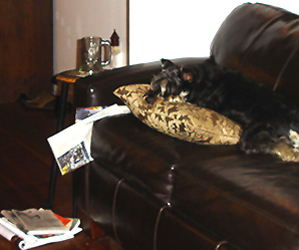


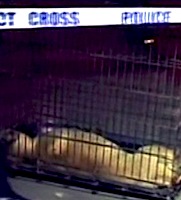









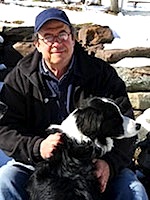
 Cousin
Pugsley has arrived at Rainbow
Bridge
Cousin
Pugsley has arrived at Rainbow
Bridge



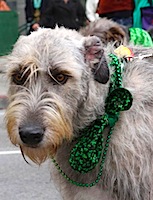
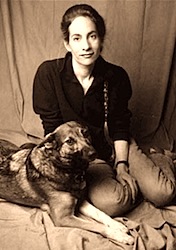






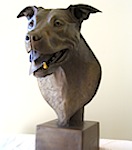
 Extremists
and Wild Fires Threaten Lobos Wolves in Arizona
Extremists
and Wild Fires Threaten Lobos Wolves in Arizona There
are only about 50 left in the wild, but anti-wolf extremists are
targeting exceptionally rare Southwest wolves -- even as
these native animals struggle to regain a foothold in the wilderness
of Arizona and New Mexico.
There
are only about 50 left in the wild, but anti-wolf extremists are
targeting exceptionally rare Southwest wolves -- even as
these native animals struggle to regain a foothold in the wilderness
of Arizona and New Mexico. 
 Canis
Lupus than with something more deep-seated. Gray Wolves
were exterminated long ago in most Western states, a campaign
of blood lust, terror and bounty kills.”
Canis
Lupus than with something more deep-seated. Gray Wolves
were exterminated long ago in most Western states, a campaign
of blood lust, terror and bounty kills.” the
central part of the state.
the
central part of the state.



 two
terrified brothers watched helplessly, cops and witnesses said.
Neighbors rushed to the Pacific St. home in Brownsville
about 9:15 p.m. Friday after hearing the mother's desperate cries
for help when the dog latched onto the boy's throat, witnesses said.
two
terrified brothers watched helplessly, cops and witnesses said.
Neighbors rushed to the Pacific St. home in Brownsville
about 9:15 p.m. Friday after hearing the mother's desperate cries
for help when the dog latched onto the boy's throat, witnesses said.
 Jayelin
Graham (right) was rushed to Brookdale University
Hospital, where he died. Police said his two brothers,
ages 2 and 5, were inside the room with Jayelin when the powerful
Cane Corso (left) attacked. The Italian-bred
dogs are large, muscular animals once used to hunt wild boars. A
neighbor said the killer dog had recently eaten the family's pet
rabbit.
Jayelin
Graham (right) was rushed to Brookdale University
Hospital, where he died. Police said his two brothers,
ages 2 and 5, were inside the room with Jayelin when the powerful
Cane Corso (left) attacked. The Italian-bred
dogs are large, muscular animals once used to hunt wild boars. A
neighbor said the killer dog had recently eaten the family's pet
rabbit. "People were scared of those dogs," said Kenny
Rishar, 50, the super of the building. "The dogs belong
to the husband, who is seldom here. This was a tragedy waiting to
happen."
"People were scared of those dogs," said Kenny
Rishar, 50, the super of the building. "The dogs belong
to the husband, who is seldom here. This was a tragedy waiting to
happen." MICHAEL
DALY
MICHAEL
DALY If
I had not heard the story, I might have thought that one of the
kids had gone wild on the floor with brown fingerpaint.
But I knew it was blood and that these frenetic smears marked where
the big mastiff killed a little boy who had been happily playing
outside just hours before. I also knew that this was a horror that
people on Pacific St. had been predicting since
a man they nicknamed "Dread" arrived
on the block with three of the scariest dogs in Brooklyn.
If
I had not heard the story, I might have thought that one of the
kids had gone wild on the floor with brown fingerpaint.
But I knew it was blood and that these frenetic smears marked where
the big mastiff killed a little boy who had been happily playing
outside just hours before. I also knew that this was a horror that
people on Pacific St. had been predicting since
a man they nicknamed "Dread" arrived
on the block with three of the scariest dogs in Brooklyn. watched
from beneath a bed was trained to kill by the dead child's stepdad,
neighbors said Saturday.
watched
from beneath a bed was trained to kill by the dead child's stepdad,
neighbors said Saturday.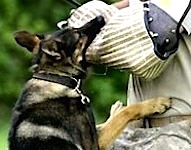 Neighbors
described the family's seedy first-floor home as a small zoo with
the Cane Corso, two other dogs, two birds and fish. Cops
removed two dogs from the apartment early Saturday.
Neighbors
described the family's seedy first-floor home as a small zoo with
the Cane Corso, two other dogs, two birds and fish. Cops
removed two dogs from the apartment early Saturday.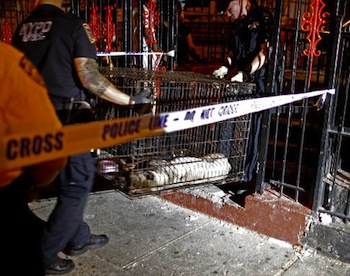 Some
recalled the dogs foaming at the mouth as Jones worked the dogs
into a street-clearing frenzy.
Some
recalled the dogs foaming at the mouth as Jones worked the dogs
into a street-clearing frenzy.

 alone with the killer dog, neighbors said Sunday. "He
had no chance," said neighbor Sabrina Ramos.
"I don't know how someone would leave a child that
small with a dog that big."
alone with the killer dog, neighbors said Sunday. "He
had no chance," said neighbor Sabrina Ramos.
"I don't know how someone would leave a child that
small with a dog that big."
 dogs,
Canis Pugnax, or Molossus, a breed now extinct.
dogs,
Canis Pugnax, or Molossus, a breed now extinct.









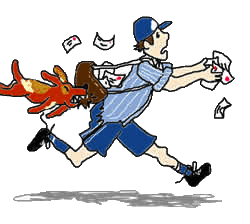 Q.
A recent circular I got from the post office
said that May 15 to 21 was National
Dog Bite Prevention Week. How likely are New York
City dogs to chomp on letter carriers?
Q.
A recent circular I got from the post office
said that May 15 to 21 was National
Dog Bite Prevention Week. How likely are New York
City dogs to chomp on letter carriers?

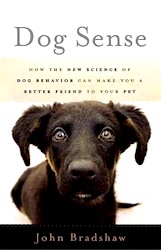
 nor
furry humans and that dog owners have certain responsibilities to
make sure their dogs are psychologically healthy.
nor
furry humans and that dog owners have certain responsibilities to
make sure their dogs are psychologically healthy.


 custody
Thursday to the Tinton Falls hospital and its staff members who had
been caring for a 1-year-old pit bull that was found starving in a
Newark trash chute in March.
custody
Thursday to the Tinton Falls hospital and its staff members who had
been caring for a 1-year-old pit bull that was found starving in a
Newark trash chute in March. 
 According
to a Facebook post from NJ SPCA, “Judge
Joseph C. Cassini (left) of Superior Court of NJ in Essex rendered
the verdict that Patrick is a victim and evidence, so he stays with
GSVS pending criminal charges of Kisha Curtis (right).”
According
to a Facebook post from NJ SPCA, “Judge
Joseph C. Cassini (left) of Superior Court of NJ in Essex rendered
the verdict that Patrick is a victim and evidence, so he stays with
GSVS pending criminal charges of Kisha Curtis (right).”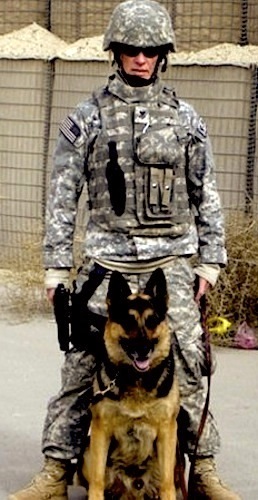 "We handlers have the most sophisticated pieces of military machinery
ever made," said Petty Officer 1st Class Kathleen Ellison, 48,
of Grahamsville, NY, a military-dog handler stationed at the US Naval
Station in Rota, Spain.
"We handlers have the most sophisticated pieces of military machinery
ever made," said Petty Officer 1st Class Kathleen Ellison, 48,
of Grahamsville, NY, a military-dog handler stationed at the US Naval
Station in Rota, Spain.

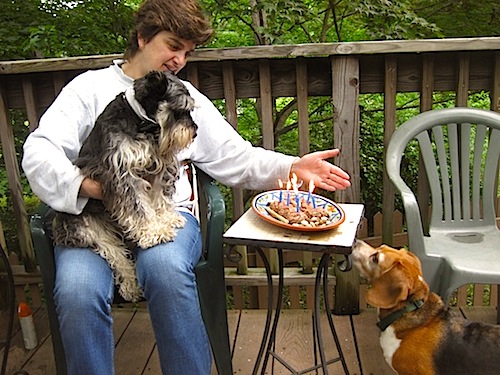


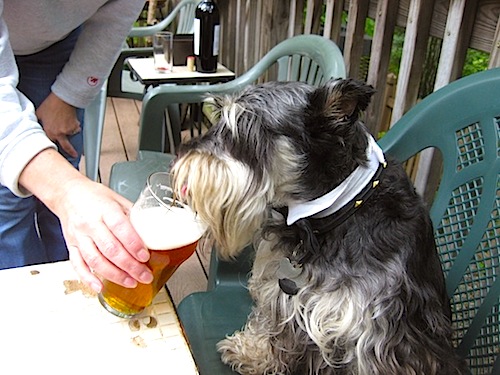
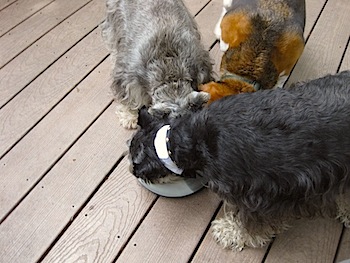



 New
York assemblyman Micah Kellner (left) and Senator Joseph Robach (right)
have introduced the Companion Animal Access and Rescue Act (CAARA),
which will guarantee shelter access to qualified rescue groups and
empower them to claim animals who are scheduled to be destroyed at
shelters.
New
York assemblyman Micah Kellner (left) and Senator Joseph Robach (right)
have introduced the Companion Animal Access and Rescue Act (CAARA),
which will guarantee shelter access to qualified rescue groups and
empower them to claim animals who are scheduled to be destroyed at
shelters. Working
together we can create a time of No More Homeless Pets in New York!
Working
together we can create a time of No More Homeless Pets in New York!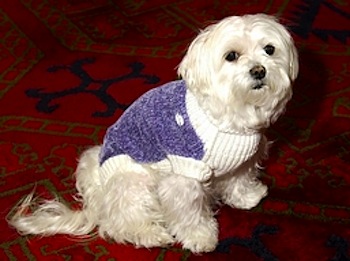 estate
mogul, has died at the age of 12. That's 84 in dog years.
estate
mogul, has died at the age of 12. That's 84 in dog years. Connecticut
mansion Dunnellen Hall, and Helmsley's duplex penthouse with swimming
pool at the Park Lane Hotel on Central Park South.
Connecticut
mansion Dunnellen Hall, and Helmsley's duplex penthouse with swimming
pool at the Park Lane Hotel on Central Park South. in
a pet cemetery has been thwarted by state bureaucrats.
in
a pet cemetery has been thwarted by state bureaucrats. Met
broadcaster Ralph Kiner's dog, and perhaps 700 of their devoted owners.
The pet cemetery has allowed people to be buried there for
decades, as long as they were cremated and their pets beat them to
the grave.
Met
broadcaster Ralph Kiner's dog, and perhaps 700 of their devoted owners.
The pet cemetery has allowed people to be buried there for
decades, as long as they were cremated and their pets beat them to
the grave. beloved
cats, dogs and parakeets.
beloved
cats, dogs and parakeets.
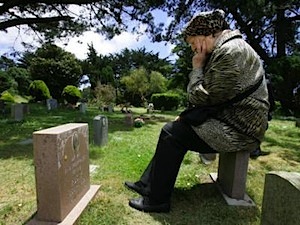 Hartsdale
has an estimated 700 humans interred with about 75,000 animals.
It has added 10 or 12 in each of the past few years, compared with
three to five before, Ed Martin Jr. (left), the cemetery’s
president and director, said in February. The International
Association of Pet Cemeteries and Crematories has also noted a recent
increase nationwide.
Hartsdale
has an estimated 700 humans interred with about 75,000 animals.
It has added 10 or 12 in each of the past few years, compared with
three to five before, Ed Martin Jr. (left), the cemetery’s
president and director, said in February. The International
Association of Pet Cemeteries and Crematories has also noted a recent
increase nationwide. anyone
stand in the way,” she added. “His love for those dogs
was just as real and just as strong as any parent’s for any
child.”
anyone
stand in the way,” she added. “His love for those dogs
was just as real and just as strong as any parent’s for any
child.”
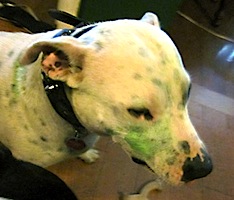
 opened
fire on the pooches with a paintball gun.
opened
fire on the pooches with a paintball gun.
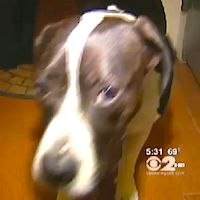 scream,"
he said. "I come out in a towel, and my dogs are covered in paint."
scream,"
he said. "I come out in a towel, and my dogs are covered in paint." that
combines exalted pedigree, child-friendly cuddliness
and arm-lacerating ferocity.
that
combines exalted pedigree, child-friendly cuddliness
and arm-lacerating ferocity.
 outside
Minneapolis. “She’s won awards. She looks at you, she’s
got the most beautiful face.”
outside
Minneapolis. “She’s won awards. She looks at you, she’s
got the most beautiful face.” 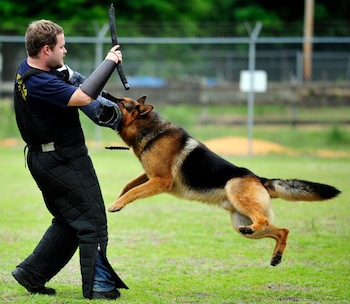 when
an intruder emerged near the tennis court of his estate, all it took
was one command, “Packen!” (the bite command from
the German word for “seize”), to send Julia racing
across the lawn.
when
an intruder emerged near the tennis court of his estate, all it took
was one command, “Packen!” (the bite command from
the German word for “seize”), to send Julia racing
across the lawn. Mexico),
the Middle East, Asia and other places, said Mr. Prather and Wayne
Curry (left), the owner of Kraftwerk K9 in Rochester, Wash.
Mexico),
the Middle East, Asia and other places, said Mr. Prather and Wayne
Curry (left), the owner of Kraftwerk K9 in Rochester, Wash.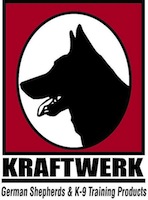
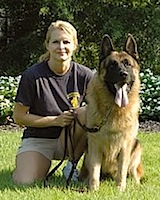 training
and are put to the test of family living. Before her sale, Julia lived
for four months in the home of November Holley, the company’s
vice president and head trainer.
training
and are put to the test of family living. Before her sale, Julia lived
for four months in the home of November Holley, the company’s
vice president and head trainer. Julia
also proved her mettle as a babysitter, Ms. Holley added. “If
my daughter Kailee was outside in the woods, I’d say, ‘Julia,
where’s Kailee?’, and she’d go out and find her.
She was like a person.”
Julia
also proved her mettle as a babysitter, Ms. Holley added. “If
my daughter Kailee was outside in the woods, I’d say, ‘Julia,
where’s Kailee?’, and she’d go out and find her.
She was like a person.”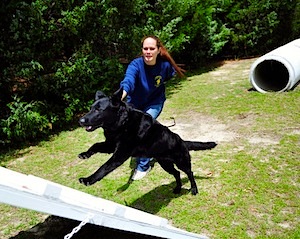
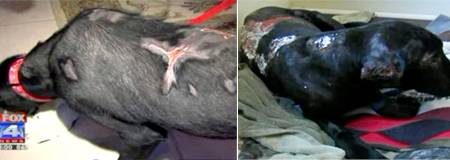 cops
said.
cops
said. according
to Fox 8 News in Kansas City.
according
to Fox 8 News in Kansas City.
 if
not for the initiative of several residents.
if
not for the initiative of several residents.

 Keeping
pets safe
during the summer is easiest if you know what the risks are and how
to manage them for your dog's safety.
Keeping
pets safe
during the summer is easiest if you know what the risks are and how
to manage them for your dog's safety.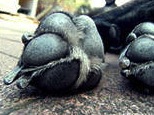
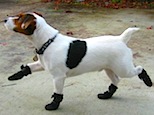 To
avoid scorched paws, walk your dog very early in the morning or in
the late evening when the streets have cooled off. If you
must walk your dog during the day, dog booties can protect his feet.
Always put your hand down on the asphalt for about thirty seconds
- if you must pull your hand away because the street is too hot, it
is too hot for your dog to walk on without hurting his paws. If you
don't want your hand on the street for thirty seconds, your dog probably
does not want his paws on it for thirty or more minutes of walking.
To
avoid scorched paws, walk your dog very early in the morning or in
the late evening when the streets have cooled off. If you
must walk your dog during the day, dog booties can protect his feet.
Always put your hand down on the asphalt for about thirty seconds
- if you must pull your hand away because the street is too hot, it
is too hot for your dog to walk on without hurting his paws. If you
don't want your hand on the street for thirty seconds, your dog probably
does not want his paws on it for thirty or more minutes of walking.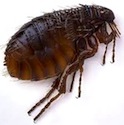
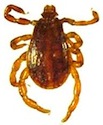 best
and at worst may be life threatening or cause self-mutilating behaviors.
Feeding your dog a high quality diet, without preservatives or chemicals
will build his immune system, making him generally more resistant
to parasite infestation. There are a wide variety of preventatives
on the market, including chemical spot-on treatments, repellent shampoos,
essential oils, and flea/tick collars; talk to your vet to see what
she recommends for your dog. Cleaning your house frequently and keeping
your dog well groomed will also reduce the risk of parasite infestation.
best
and at worst may be life threatening or cause self-mutilating behaviors.
Feeding your dog a high quality diet, without preservatives or chemicals
will build his immune system, making him generally more resistant
to parasite infestation. There are a wide variety of preventatives
on the market, including chemical spot-on treatments, repellent shampoos,
essential oils, and flea/tick collars; talk to your vet to see what
she recommends for your dog. Cleaning your house frequently and keeping
your dog well groomed will also reduce the risk of parasite infestation. restricting
your pet's exercise during the hottest hours of the day (early morning
or late evening are the best times for exercise during the summer),
by making sure he is well hydrated, providing cool places for him
to relax, providing opportunities to swim, cooling mats, and by never
leaving your dog unattended in the car during summer heat.
restricting
your pet's exercise during the hottest hours of the day (early morning
or late evening are the best times for exercise during the summer),
by making sure he is well hydrated, providing cool places for him
to relax, providing opportunities to swim, cooling mats, and by never
leaving your dog unattended in the car during summer heat.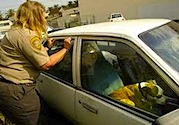 heat
can build quickly in a car in the summer, turning it into an oven.
If it's 95 degrees at noon and you leave your windows cracked, the
temperature in your car may still rise as high as 113 degrees.
This is a recipe for disaster for your dog. If you must leave your
dog in the car for any period of time, the air conditioning should
stay on. Leaving a dog to die in a hot car is not just a health risk
for your dog, but may be cause for animal cruelty charges in some
area. The solution? Don't leave your dog in a hot car.
heat
can build quickly in a car in the summer, turning it into an oven.
If it's 95 degrees at noon and you leave your windows cracked, the
temperature in your car may still rise as high as 113 degrees.
This is a recipe for disaster for your dog. If you must leave your
dog in the car for any period of time, the air conditioning should
stay on. Leaving a dog to die in a hot car is not just a health risk
for your dog, but may be cause for animal cruelty charges in some
area. The solution? Don't leave your dog in a hot car.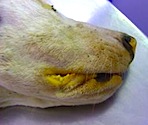 ingestion
of flesh) or indirect contact (through water sources, food, etc.)
with an infected animal. Stagnant waters are a common source of leptospirosis
bacteria. Lepto can cause permanent health problems or death if not
treated quickly. Symptoms include fever, vomiting, trembling/shaking,
lethargy, anorexia,
ingestion
of flesh) or indirect contact (through water sources, food, etc.)
with an infected animal. Stagnant waters are a common source of leptospirosis
bacteria. Lepto can cause permanent health problems or death if not
treated quickly. Symptoms include fever, vomiting, trembling/shaking,
lethargy, anorexia, 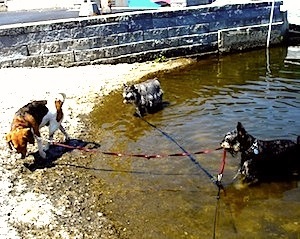 tenderness
of joints and muscles, and increased water intake. If you suspect
your dog has lepto, get him to a vet right away, an emergency vet
if need be. There are vaccines for lepto but they do not prevent all
strains and can cause significant adverse reactions. Talk to your
vet about
tenderness
of joints and muscles, and increased water intake. If you suspect
your dog has lepto, get him to a vet right away, an emergency vet
if need be. There are vaccines for lepto but they do not prevent all
strains and can cause significant adverse reactions. Talk to your
vet about 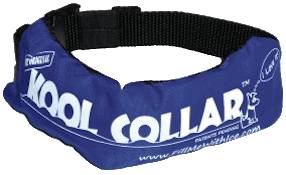

 It
was quite a terrifying morning for a little puppy named Rosie. Apparently,
she decided to go for a sky-high adventure on her dog-sitter’s
roof. Getting to her precarious perch was the easy part, but firefighters
had the tough job of saving her life, reports CBS 2’s
Hazel Sanchez.
It
was quite a terrifying morning for a little puppy named Rosie. Apparently,
she decided to go for a sky-high adventure on her dog-sitter’s
roof. Getting to her precarious perch was the easy part, but firefighters
had the tough job of saving her life, reports CBS 2’s
Hazel Sanchez.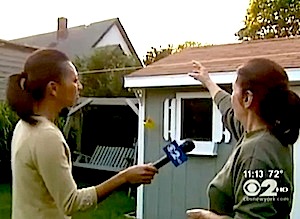
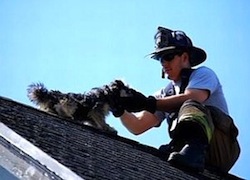 “Who
would expect that you would see a dog on a roof?”
“Who
would expect that you would see a dog on a roof?”
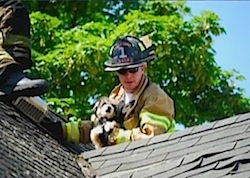

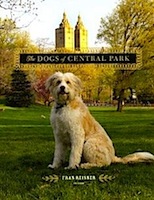
 rescued
by Bernadette Peters.”
rescued
by Bernadette Peters.” •
Pan-seared duck with brown rice and blueberry compote.
•
Pan-seared duck with brown rice and blueberry compote.
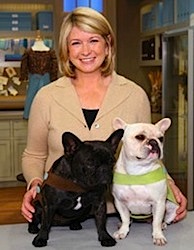
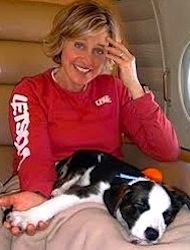 “I’m
still very bullish on natural and organic,” says David
Lummis, senior pet market analyst for Packaged Facts, noting
that such products account for about 7 percent of pet food sales.
“There is still a lot of growth there.” In addition, he
notes that expected demand for luxury pet products is strong
enough to lure companies and even celebrities into the business. Among
them: Martha Stewart, Ellen DeGeneres, Fisher-Price and General Nutrition
Center, which now offers health supplements for pets.
“I’m
still very bullish on natural and organic,” says David
Lummis, senior pet market analyst for Packaged Facts, noting
that such products account for about 7 percent of pet food sales.
“There is still a lot of growth there.” In addition, he
notes that expected demand for luxury pet products is strong
enough to lure companies and even celebrities into the business. Among
them: Martha Stewart, Ellen DeGeneres, Fisher-Price and General Nutrition
Center, which now offers health supplements for pets. “We
actually saw that there was a gap in the market for beverages for
dogs,” says Bonnie Senior, a manager at the company.
Then there is Jenn Mohr, who says she combined her love of
dogs and love of candles to create Sniff Pet Candles. Made
of “100 percent organic natural ingredients,” the aromatherapy
candles have names like “Day in the Hamptons” and “Field
of Dreams” and “promote your dog’s optimum health
and well-being,” her company says. Ms. Mohr even designed
a candle to address the flatulence of Rufus, her Rhodesian ridgeback.
Made with floral ylang-ylang, white tea, myrtle and fennel, the “Fart
& Away” candle “won’t completely stop them,”
Ms. Mohr says. “But it will help.” The price: $28.
“We
actually saw that there was a gap in the market for beverages for
dogs,” says Bonnie Senior, a manager at the company.
Then there is Jenn Mohr, who says she combined her love of
dogs and love of candles to create Sniff Pet Candles. Made
of “100 percent organic natural ingredients,” the aromatherapy
candles have names like “Day in the Hamptons” and “Field
of Dreams” and “promote your dog’s optimum health
and well-being,” her company says. Ms. Mohr even designed
a candle to address the flatulence of Rufus, her Rhodesian ridgeback.
Made with floral ylang-ylang, white tea, myrtle and fennel, the “Fart
& Away” candle “won’t completely stop them,”
Ms. Mohr says. “But it will help.” The price: $28.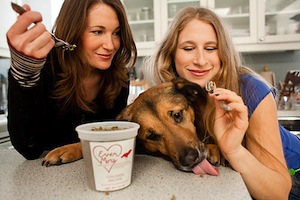
 brown
mush made from beef hearts and chicken livers, among other things.
“My business partner really enjoys the taste,” Ms. Mandelbaum
says. “For me, it was a little bit more an acquired taste.”
brown
mush made from beef hearts and chicken livers, among other things.
“My business partner really enjoys the taste,” Ms. Mandelbaum
says. “For me, it was a little bit more an acquired taste.” A
handicapped Brooklyn man's bark is
worse than his sight.
A
handicapped Brooklyn man's bark is
worse than his sight.
 according
to a study led by Michigan State University, published
recently in the Journal of Physical Activity and Health.
according
to a study led by Michigan State University, published
recently in the Journal of Physical Activity and Health.
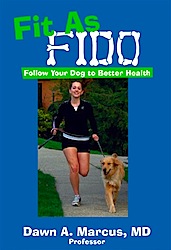
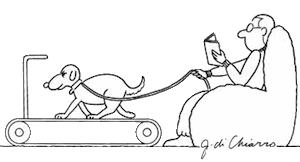 dogs,
she said. Most dog owners feed their pets healthy food, and see to
it that they don't overeat.
dogs,
she said. Most dog owners feed their pets healthy food, and see to
it that they don't overeat.
 Manolos
clicking, onto the street she strutted -- plastic bag of edibles dangling
from her hand.
Manolos
clicking, onto the street she strutted -- plastic bag of edibles dangling
from her hand. 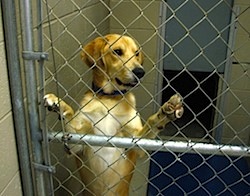
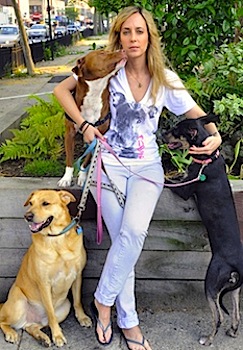 "There's
no doubt that animals are being labeled as being sick or dangerous
so they can be killed more quickly," said Emily Tanen (right),
a former paid staffer at ACC's shelter at 326 E. 110th St. "Dogs
come in healthy, and within a few days, they're dead. As soon as they
start coughing, we're allowed to kill them and say it's 'disease euth.'
"
"There's
no doubt that animals are being labeled as being sick or dangerous
so they can be killed more quickly," said Emily Tanen (right),
a former paid staffer at ACC's shelter at 326 E. 110th St. "Dogs
come in healthy, and within a few days, they're dead. As soon as they
start coughing, we're allowed to kill them and say it's 'disease euth.'
" Julie
Bank (left), executive director of ACC, which also runs shelters
in Brooklyn and Staten Island, dismissed criticisms about
the shelter's euthanasia practices as baseless, noting the
organization rescues about 40,000 animals annually. "Last year,
over 17,000 animals got out of our building alive," she said.
"So the thought that we are not proactively trying to get the
animals adopted is not accurate."
Julie
Bank (left), executive director of ACC, which also runs shelters
in Brooklyn and Staten Island, dismissed criticisms about
the shelter's euthanasia practices as baseless, noting the
organization rescues about 40,000 animals annually. "Last year,
over 17,000 animals got out of our building alive," she said.
"So the thought that we are not proactively trying to get the
animals adopted is not accurate."
 with
the virus. Some of them will suffer cirrhosis, liver cancer and even
death. Celebrities like Steven Tyler (left) of Aerosmith and
“American Idol” have spoken publicly of their
infections. But mysteries still shroud the disease.
with
the virus. Some of them will suffer cirrhosis, liver cancer and even
death. Celebrities like Steven Tyler (left) of Aerosmith and
“American Idol” have spoken publicly of their
infections. But mysteries still shroud the disease. something
of a holy grail in studies of viral evolution,” said Eddie
Holmes (right), a virologist at Penn State University.
something
of a holy grail in studies of viral evolution,” said Eddie
Holmes (right), a virologist at Penn State University. revealed
it was closely related to the hepatitis C virus (HCV for short). “I
was not expecting anything like HCV,” Dr. Kapoor said. Like
many other researchers, he assumed that it had evolved from a primate
virus, because chimpanzees can be experimentally infected with hepatitis
C.
revealed
it was closely related to the hepatitis C virus (HCV for short). “I
was not expecting anything like HCV,” Dr. Kapoor said. Like
many other researchers, he assumed that it had evolved from a primate
virus, because chimpanzees can be experimentally infected with hepatitis
C.
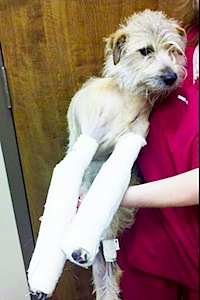
 his
owners' home with two badly broken legs nearly three weeks later,
wagging his tail with joy at the sight of his shocked family.
his
owners' home with two badly broken legs nearly three weeks later,
wagging his tail with joy at the sight of his shocked family.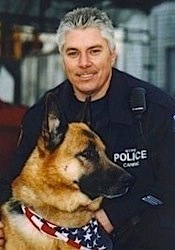
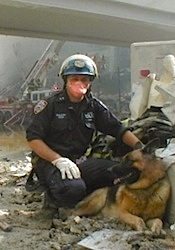 rescue
dogs. The cement statue in Lindenhurst is modeled
after Hansen, a German
shepherd who spent 150 days searching through the rubble of Ground
Zero.
rescue
dogs. The cement statue in Lindenhurst is modeled
after Hansen, a German
shepherd who spent 150 days searching through the rubble of Ground
Zero.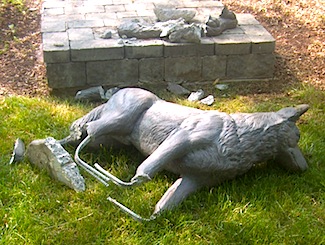
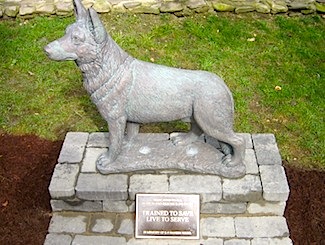
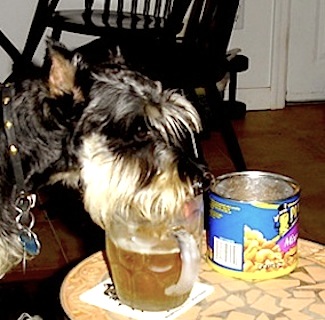
 describe
the elegant way in which cats lap up liquid with the tip of
the tongue, seemingly defying gravity. Dogs, on the other hand, form
a cup with the tongue and scoop up liquid, the researchers said, spilling
quite a bit of it.
describe
the elegant way in which cats lap up liquid with the tip of
the tongue, seemingly defying gravity. Dogs, on the other hand, form
a cup with the tongue and scoop up liquid, the researchers said, spilling
quite a bit of it.
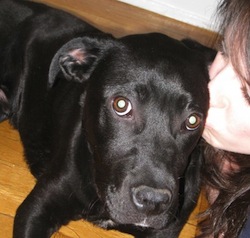 home.
home. needs
around here. Often, mine just brings Gus to the dog run so he can
get more exercise, which means she doesn’t even have to walk
much if she doesn’t want to. She’s a pro-walker! None
of them work a very wide radius, so it’s not like they even
have to contend with schlepping around the city. Plus, they have almost
no overhead outside of durable footwear and sunblock.
needs
around here. Often, mine just brings Gus to the dog run so he can
get more exercise, which means she doesn’t even have to walk
much if she doesn’t want to. She’s a pro-walker! None
of them work a very wide radius, so it’s not like they even
have to contend with schlepping around the city. Plus, they have almost
no overhead outside of durable footwear and sunblock. 
 McGregor stars as Oliver, who navigates not only his father’s
final years (Hal, played by Christopher Plummer) but also a burgeoning
love affair (with the effervescent Mélanie Laurent) in the
company of his father’s Jack
McGregor stars as Oliver, who navigates not only his father’s
final years (Hal, played by Christopher Plummer) but also a burgeoning
love affair (with the effervescent Mélanie Laurent) in the
company of his father’s Jack charming
Cosmo.
charming
Cosmo.  Bark:
Ewan, we understand that after you finished filming Beginners, you
got a dog. Was that something you’d been planning, or did
the role create the desire for one?
Bark:
Ewan, we understand that after you finished filming Beginners, you
got a dog. Was that something you’d been planning, or did
the role create the desire for one? Mike
Mills: I just remembered something that happened
when we first met. You sent me an email saying, “Maybe we
should rescue a Jack Russell, and I could keep him!” And I
thought to myself, “I love this man!”
Mike
Mills: I just remembered something that happened
when we first met. You sent me an email saying, “Maybe we
should rescue a Jack Russell, and I could keep him!” And I
thought to myself, “I love this man!” Santa
Monica. The first face I saw was Sid’s.
Santa
Monica. The first face I saw was Sid’s.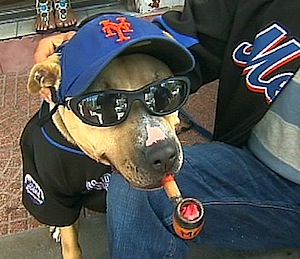
 her
Mets gear. But all it takes is a quick change and she transforms
into the famous panhandling pooch scores of baseball fans know,
love and pay.
her
Mets gear. But all it takes is a quick change and she transforms
into the famous panhandling pooch scores of baseball fans know,
love and pay.


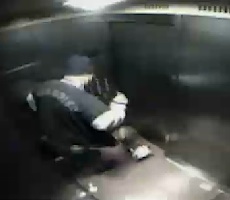

 "The
Early Show on Saturday Morning," Rod Kurtz, executive editor
of AOL Small Business, said many businesses are racing
to get your money before The End.
"The
Early Show on Saturday Morning," Rod Kurtz, executive editor
of AOL Small Business, said many businesses are racing
to get your money before The End. For people who are concerned about leaving behind their beloved
pets, Kurtz says these businesses charge a fee to care for their
non-Raptured animals. "A lot of these people running
these companies are actually atheists who will be around if the
Rapture does strike, and they've offered to, across the country,
take care of your pets when you're gone. And people are, you know,
buying into it.
For people who are concerned about leaving behind their beloved
pets, Kurtz says these businesses charge a fee to care for their
non-Raptured animals. "A lot of these people running
these companies are actually atheists who will be around if the
Rapture does strike, and they've offered to, across the country,
take care of your pets when you're gone. And people are, you know,
buying into it.



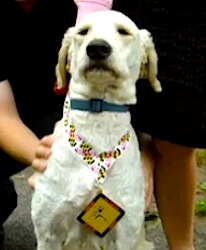
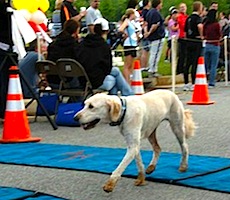 The
owners of Dozer, a 3-year-old Goldendoodle from Fulton,
Maryland, didn’t know the answer to that question
on Sunday. Unbeknownst to them, Dozer escaped his invisible
fence and joined the 2,000-plus runners competing in the Maryland
Half Marathon, which benefits the University of Maryland’s
Greenebaum Cancer Center.
The
owners of Dozer, a 3-year-old Goldendoodle from Fulton,
Maryland, didn’t know the answer to that question
on Sunday. Unbeknownst to them, Dozer escaped his invisible
fence and joined the 2,000-plus runners competing in the Maryland
Half Marathon, which benefits the University of Maryland’s
Greenebaum Cancer Center.
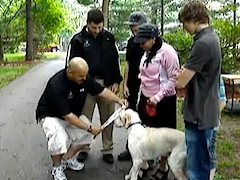
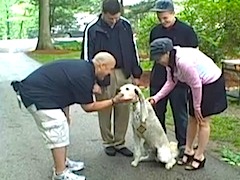


 his
back yard.
his
back yard.
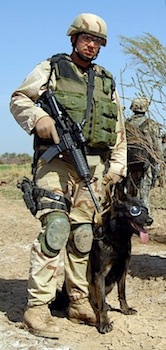

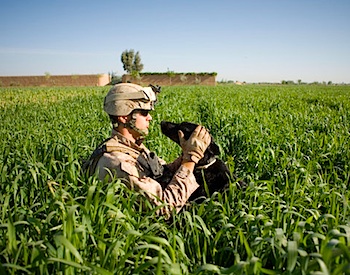 killed
a lethal threat: a local dog that made the mistake of attacking the
Marines’ Labrador Retriever.
killed
a lethal threat: a local dog that made the mistake of attacking the
Marines’ Labrador Retriever.  American
troops may be starting to come home this summer, but more dogs are
going in. In 2007, the Marines began a pilot program in Afghanistan
with nine bomb-sniffing dogs, a number that has grown to 350 and is
expected to reach nearly 650 by the end of the year. Over
all, there are some 2,700 dogs on active duty in the American military.
A decade ago, before the Sept. 11 attacks, there were 1,800.
American
troops may be starting to come home this summer, but more dogs are
going in. In 2007, the Marines began a pilot program in Afghanistan
with nine bomb-sniffing dogs, a number that has grown to 350 and is
expected to reach nearly 650 by the end of the year. Over
all, there are some 2,700 dogs on active duty in the American military.
A decade ago, before the Sept. 11 attacks, there were 1,800.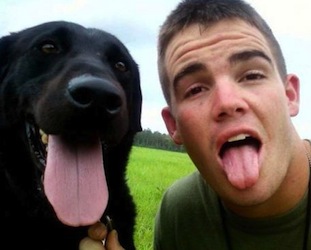
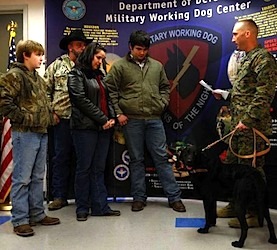 heart-tugging
war stories. But few have had the emotional impact of that of Pfc.
Colton W. Rusk, a 20-year-old Marine machine gunner and dog handler
who was killed in December by sniper fire in Sangin, one of the most
deadly areas in Helmand. During his deployment, Private Rusk sent
his parents a steady flow of pictures and news about his beloved bomb
dog, Eli, a black Lab. When Private Rusk was shot, Marine officers
told his parents, Eli crawled on top of their son to try to protect
him.
heart-tugging
war stories. But few have had the emotional impact of that of Pfc.
Colton W. Rusk, a 20-year-old Marine machine gunner and dog handler
who was killed in December by sniper fire in Sangin, one of the most
deadly areas in Helmand. During his deployment, Private Rusk sent
his parents a steady flow of pictures and news about his beloved bomb
dog, Eli, a black Lab. When Private Rusk was shot, Marine officers
told his parents, Eli crawled on top of their son to try to protect
him.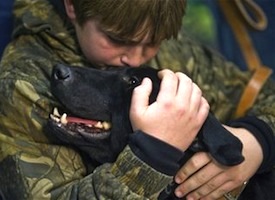 The
3-year-old Eli, the first name of the survivors listed in Private
Rusk’s obituary, was retired early from the military and adopted
in February by Private Rusk’s parents, Darrell and Kathy Rusk.
“He’s a big comfort to us,” Kathy Rusk said in a
telephone interview from her home in Orange Grove, Tex. After the
dog’s retirement ceremony in February at Lackland Air Force
Base, an event that generated enormous news coverage in Texas, the
Rusks brought Eli for the first time into their home (right: Eli with
Colton's 12-year-old brother Brady Rusk).
The
3-year-old Eli, the first name of the survivors listed in Private
Rusk’s obituary, was retired early from the military and adopted
in February by Private Rusk’s parents, Darrell and Kathy Rusk.
“He’s a big comfort to us,” Kathy Rusk said in a
telephone interview from her home in Orange Grove, Tex. After the
dog’s retirement ceremony in February at Lackland Air Force
Base, an event that generated enormous news coverage in Texas, the
Rusks brought Eli for the first time into their home (right: Eli with
Colton's 12-year-old brother Brady Rusk). To
an American public weary of nearly 10 years of war, dogs are a way
to relate, as the celebrity status of the still-unknown commando dog
proved. (President Obama is one of the few
Americans to have met the dog, in a closed-door session with the Seal
team last week.)
To
an American public weary of nearly 10 years of war, dogs are a way
to relate, as the celebrity status of the still-unknown commando dog
proved. (President Obama is one of the few
Americans to have met the dog, in a closed-door session with the Seal
team last week.)
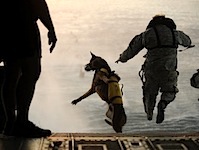

 Kisha
Curtis (left) pleaded not guilty in late March to animal
abuse charges. A judge could schedule future court dates
and a possible trial.
Kisha
Curtis (left) pleaded not guilty in late March to animal
abuse charges. A judge could schedule future court dates
and a possible trial.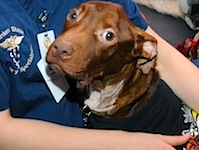
 On
Friday, about 40 people demonstrated outside the Newark courthouse
to show their support for Patrick.
On
Friday, about 40 people demonstrated outside the Newark courthouse
to show their support for Patrick.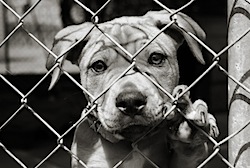 shelters
across New York from being euthanized.
shelters
across New York from being euthanized.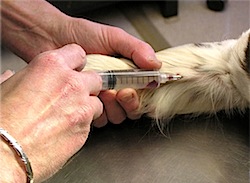 The
Companion Animal Access and Rescue Act would let these groups
adopt animals that are scheduled to be euthanized from shelters, humane
societies or pounds.
The
Companion Animal Access and Rescue Act would let these groups
adopt animals that are scheduled to be euthanized from shelters, humane
societies or pounds. NEW
YOUR STATE RESIDENTS!
NEW
YOUR STATE RESIDENTS!

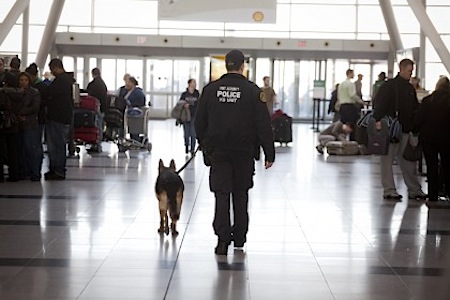

 about
the unsatisfactory transaction and, of course, was promptly
arrested.
about
the unsatisfactory transaction and, of course, was promptly
arrested.
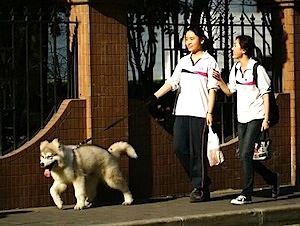 vigor,
putting in place such measures as limiting each household
to a single canine companion.
vigor,
putting in place such measures as limiting each household
to a single canine companion.
 or
face "group handling," the new regulation said. The police
have never clarified the meaning of "group
handling," but local animal welfare groups claim
the authorities kill any dogs that have not found new homes in 30
days.
or
face "group handling," the new regulation said. The police
have never clarified the meaning of "group
handling," but local animal welfare groups claim
the authorities kill any dogs that have not found new homes in 30
days. Owners
are not allowed to bring dogs, except seeing eye dogs,
into public venues including office buildings, schools, hospitals,
museums, libraries, restaurants, shopping malls, hotels and public
transport.
Owners
are not allowed to bring dogs, except seeing eye dogs,
into public venues including office buildings, schools, hospitals,
museums, libraries, restaurants, shopping malls, hotels and public
transport. 
 Sunday,
May 22, this year's event features appearances by Victoria
Stilwell and the heroes of Rescue Ink
-- as well as seminars and panel discussions with pet health and
lifestyle experts, and over 75 exhibitors demonstrating the latest
in pet gear.
Sunday,
May 22, this year's event features appearances by Victoria
Stilwell and the heroes of Rescue Ink
-- as well as seminars and panel discussions with pet health and
lifestyle experts, and over 75 exhibitors demonstrating the latest
in pet gear.
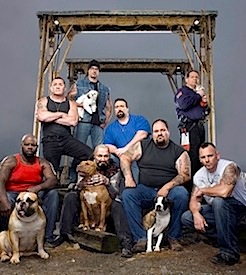 To
add to the glamour of the occasion, the NYC Pet Show will welcome
such pet-lebrities as Victoria Stilwell, from Animal Planet's
hit television series "It's Me or the Dog!"
and the heroes of animal rights organization Rescue Ink.
To
add to the glamour of the occasion, the NYC Pet Show will welcome
such pet-lebrities as Victoria Stilwell, from Animal Planet's
hit television series "It's Me or the Dog!"
and the heroes of animal rights organization Rescue Ink.
 A
dog that wasn’t quite housebroken
may have indirectly been responsible for a
A
dog that wasn’t quite housebroken
may have indirectly been responsible for a 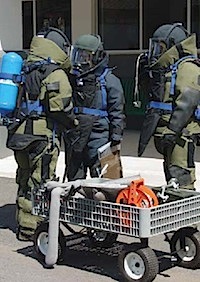 bomb
scare at a Long Island courthouse.
bomb
scare at a Long Island courthouse. But then a retired police officer saw the bag and alerted security.
But then a retired police officer saw the bag and alerted security. and
flooding along the Mississippi River, offering temporary
shelter for pets whose families have been evacuated, and working
with PetSmart
Charities to provide emergency supplies to local
animal welfare groups.
and
flooding along the Mississippi River, offering temporary
shelter for pets whose families have been evacuated, and working
with PetSmart
Charities to provide emergency supplies to local
animal welfare groups.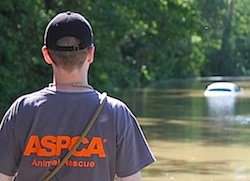 Do
you live in an area that is prone to natural catastrophes, such
as tornadoes, earthquakes or floods?
Do
you live in an area that is prone to natural catastrophes, such
as tornadoes, earthquakes or floods?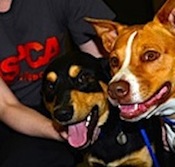 • The
ASPCA
recommends microchipping your pet as a more permanent form
of identification. A microchip is implanted in the animal's shoulder
area, and can be read by scanners at most animal shelters.
• The
ASPCA
recommends microchipping your pet as a more permanent form
of identification. A microchip is implanted in the animal's shoulder
area, and can be read by scanners at most animal shelters.
 strung
even when not running for $1,000 in prize money.
strung
even when not running for $1,000 in prize money. some,
Chihuahuas bounded across the grass as if being chased. The overall
winner was one named Chico, who took home a trophy far bigger than
he was. Like all the other competitors, he had out-size ears and
a rather large cabeza, the Spanish word for head. But one learns
at a gathering like this how individual Chihuahuas are, coming in
varying hues and ranging from tiny to even smaller than that.
some,
Chihuahuas bounded across the grass as if being chased. The overall
winner was one named Chico, who took home a trophy far bigger than
he was. Like all the other competitors, he had out-size ears and
a rather large cabeza, the Spanish word for head. But one learns
at a gathering like this how individual Chihuahuas are, coming in
varying hues and ranging from tiny to even smaller than that.



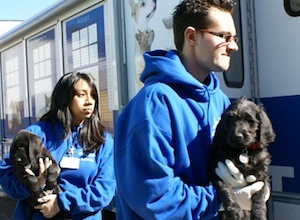 shelter
partners in the state of Alabama. With the recent
events of devastating tornadoes, not only have hundreds of animals
been abandoned or lost, but sadly many displaced families were left
no choice but to relinquish their pets. This has resulted in the
local shelters being inundated with animals with nowhere to go.
shelter
partners in the state of Alabama. With the recent
events of devastating tornadoes, not only have hundreds of animals
been abandoned or lost, but sadly many displaced families were left
no choice but to relinquish their pets. This has resulted in the
local shelters being inundated with animals with nowhere to go.
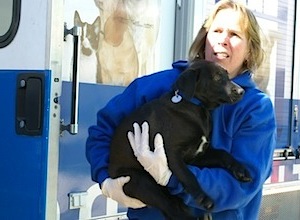 Birmingham
Humane Society with this crisis, the Animal League Rescue
Teams will not only transport animals on its Mobile Rescue Unit
to its Port Washington Headquarters, but they are also assisting
by transporting animals to surrounding shelters, where they will
be housed until reunions or adoptions have been made. Animals that
are found on the streets, or have been abandoned
Birmingham
Humane Society with this crisis, the Animal League Rescue
Teams will not only transport animals on its Mobile Rescue Unit
to its Port Washington Headquarters, but they are also assisting
by transporting animals to surrounding shelters, where they will
be housed until reunions or adoptions have been made. Animals that
are found on the streets, or have been abandoned 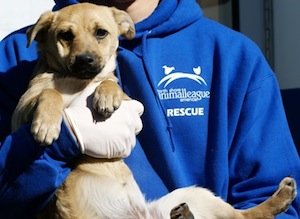 will
remain in Alabama shelters with the hope of reconnecting with their
owners.
will
remain in Alabama shelters with the hope of reconnecting with their
owners.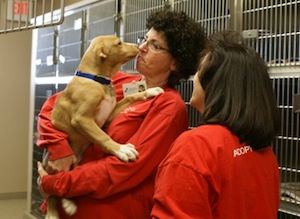 providing.
With their expertise and ability to relocate and transport
animals’, it is undeniable that pets’ lives will ultimately
be saved.”
providing.
With their expertise and ability to relocate and transport
animals’, it is undeniable that pets’ lives will ultimately
be saved.” immediately,
“After seeing the devastation and long term affects that Hurricane
Katrina had on so many communities, we knew the sooner we can help
the more lives we can save.” She added, “It is so heartbreaking
to know that just a few weeks earlier the Animal League stopped
in Tuscaloosa for our annual national adoption event, Tour
For Life. We will do everything we can to find safe havens
for these priceless pets.”
immediately,
“After seeing the devastation and long term affects that Hurricane
Katrina had on so many communities, we knew the sooner we can help
the more lives we can save.” She added, “It is so heartbreaking
to know that just a few weeks earlier the Animal League stopped
in Tuscaloosa for our annual national adoption event, Tour
For Life. We will do everything we can to find safe havens
for these priceless pets.”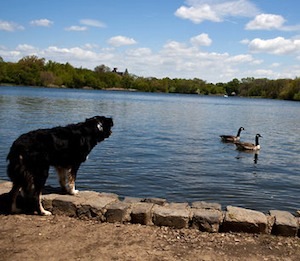 collie,
is paid to do it. Her job is to save the geese by tormenting them.
collie,
is paid to do it. Her job is to save the geese by tormenting them.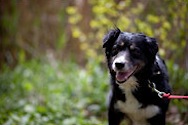 “It’s all about persistence,” said Cleo’s
handler, Philip Graziano, a veteran goose fighter who began
working in the park this week. “We can’t let them win.”
“It’s all about persistence,” said Cleo’s
handler, Philip Graziano, a veteran goose fighter who began
working in the park this week. “We can’t let them win.” “We
would really like to keep the number down low enough so this is
not a target area,” said Emily Lloyd (right),
president of the Prospect Park Alliance, the nonprofit
group that helps run the park. Her organization hired Cleo’s
owners, Goose Busters, a company based in Virginia
that has worked extensively in the New York region, at $725 a week
for about eight weeks, or until molting season begins.
“We
would really like to keep the number down low enough so this is
not a target area,” said Emily Lloyd (right),
president of the Prospect Park Alliance, the nonprofit
group that helps run the park. Her organization hired Cleo’s
owners, Goose Busters, a company based in Virginia
that has worked extensively in the New York region, at $725 a week
for about eight weeks, or until molting season begins.
 The
goose killing was prompted by the ditching of US Airways
Flight 1549, which was forced to land in the Hudson River in 2009
after geese flew into the engines.
The
goose killing was prompted by the ditching of US Airways
Flight 1549, which was forced to land in the Hudson River in 2009
after geese flew into the engines. 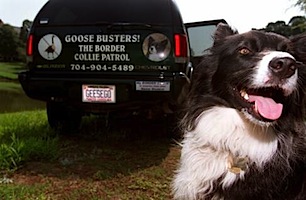 Samantha,
patrolled the lakeshore. Cleo, who is younger and lighter
than Samantha, will take over in the coming days, Mr. Graziano said.
Samantha,
patrolled the lakeshore. Cleo, who is younger and lighter
than Samantha, will take over in the coming days, Mr. Graziano said.

 But Prospect Park officials are not putting all their hopes on the
collies’ shaggy coats. They have also covered 13 gosling
eggs with oil to prevent them from hatching, and officials
intend to cover more, said Anne Wong, director of landscape
management. They will plant shrubbery that geese do not
like and crack down on people feeding the birds.
But Prospect Park officials are not putting all their hopes on the
collies’ shaggy coats. They have also covered 13 gosling
eggs with oil to prevent them from hatching, and officials
intend to cover more, said Anne Wong, director of landscape
management. They will plant shrubbery that geese do not
like and crack down on people feeding the birds.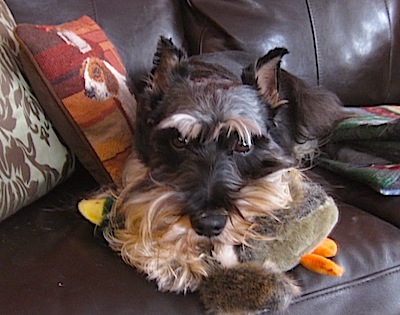

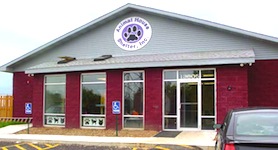



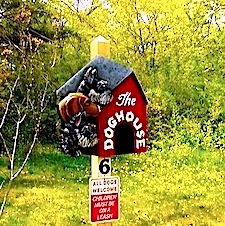
 The
identities of all 80 members of the American commando team who thundered
into Abbottabad,
Pakistan, and killed Osama bin Laden are the subject of intense speculation,
but perhaps none more so
than the only member with 4
legs.
The
identities of all 80 members of the American commando team who thundered
into Abbottabad,
Pakistan, and killed Osama bin Laden are the subject of intense speculation,
but perhaps none more so
than the only member with 4
legs. more
dogs. “The capability they bring to the fight cannot be replicated
by man or machine,” he said.
more
dogs. “The capability they bring to the fight cannot be replicated
by man or machine,” he said.
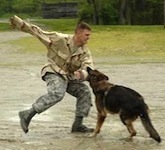 someone
who is running away without having to shoot them. “When the
dogs go after a suspect, they’re trained to bite and hold them,”
Sergeant Mylott said.
someone
who is running away without having to shoot them. “When the
dogs go after a suspect, they’re trained to bite and hold them,”
Sergeant Mylott said.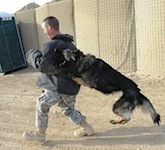 Some
dogs are big enough that, when they leap on a suspect, the person
tends to drop to the ground, Sergeant Mylott said. Others bite arms
or legs. “Different dogs do different things,” she said.
“But whatever they do, it’s very difficult for that person
to go any further.”
Some
dogs are big enough that, when they leap on a suspect, the person
tends to drop to the ground, Sergeant Mylott said. Others bite arms
or legs. “Different dogs do different things,” she said.
“But whatever they do, it’s very difficult for that person
to go any further.” Sergeant
Mylott (right) said that dogs got people’s attention in ways
that weapons sometimes did not. “Dogs can be an amazing psychological
deterrent,” she said.
Sergeant
Mylott (right) said that dogs got people’s attention in ways
that weapons sometimes did not. “Dogs can be an amazing psychological
deterrent,” she said.
 A
Silver Star, one of the Navy’s highest awards, was awarded posthumously
in 2009 to a dog named Remco after he charged an
insurgent’s hide-out in Afghanistan.
A
Silver Star, one of the Navy’s highest awards, was awarded posthumously
in 2009 to a dog named Remco after he charged an
insurgent’s hide-out in Afghanistan.
 Last
year, the Seals bought four waterproof tactical vests for
their dogs that featured infrared and night-vision cameras so that
handlers — holding a three-inch monitor from as far as 1,000
yards away — could immediately see what the dogs were seeing.
The vests, which come in coyote tan and camouflage, let handlers communicate
with the dogs with a speaker, and the four together cost
more than $86,000. Navy Seal teams have trained to parachute
from great heights and deploy out of helicopters with dogs.
Last
year, the Seals bought four waterproof tactical vests for
their dogs that featured infrared and night-vision cameras so that
handlers — holding a three-inch monitor from as far as 1,000
yards away — could immediately see what the dogs were seeing.
The vests, which come in coyote tan and camouflage, let handlers communicate
with the dogs with a speaker, and the four together cost
more than $86,000. Navy Seal teams have trained to parachute
from great heights and deploy out of helicopters with dogs.
 courage,
intelligence and adaptability to almost any climatic condition,”
according to a fact sheet from the military working dog unit.
courage,
intelligence and adaptability to almost any climatic condition,”
according to a fact sheet from the military working dog unit.



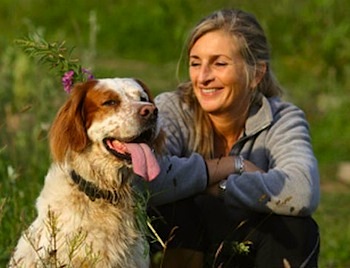 part
in the fun. After all, pet parents are some of the best, most
loving, giving, and deserving moms around.
part
in the fun. After all, pet parents are some of the best, most
loving, giving, and deserving moms around.
 OUTRAGE
IN MISSOURI:
OUTRAGE
IN MISSOURI: coast
to coast with hundreds of thousands of dogs annually, and is notorious
for its lax animal-care standards and proliferation of unlicensed
breeders. Unless it is vetoed by Governor
Jay Nixon, the bill the House just passed (SB 113) will not
only supersede the PMCPA—which includes such humane provisions
as increased cage size, prohibition on the use of wire flooring and
restrictions on breeding frequency—it will make parts of the
state’s commercial breeding law even weaker than they are now.
coast
to coast with hundreds of thousands of dogs annually, and is notorious
for its lax animal-care standards and proliferation of unlicensed
breeders. Unless it is vetoed by Governor
Jay Nixon, the bill the House just passed (SB 113) will not
only supersede the PMCPA—which includes such humane provisions
as increased cage size, prohibition on the use of wire flooring and
restrictions on breeding frequency—it will make parts of the
state’s commercial breeding law even weaker than they are now. “In
spite of decades of urging by the animal welfare community, the Missouri
General Assembly remained silent on the issue of puppy mills until
after the voters spoke. The failure of the General Assembly to address
the problem is why we finally took this straight to the people,”
says Cori Menkin,
ASPCA Senior Director of Legislative
Initiatives. “And as evidenced
by the passage of Proposition B, Missourians care deeply about puppy
mill reform. That state legislators are discarding Prop B and ignoring
the will of the people they are supposed to represent is appalling,
insulting and disrespectful.”
“In
spite of decades of urging by the animal welfare community, the Missouri
General Assembly remained silent on the issue of puppy mills until
after the voters spoke. The failure of the General Assembly to address
the problem is why we finally took this straight to the people,”
says Cori Menkin,
ASPCA Senior Director of Legislative
Initiatives. “And as evidenced
by the passage of Proposition B, Missourians care deeply about puppy
mill reform. That state legislators are discarding Prop B and ignoring
the will of the people they are supposed to represent is appalling,
insulting and disrespectful.”

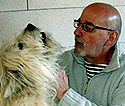
 large-scale,
commercial dog breeders in Missouri, the Puppy Mill Capital of America.
On Election Day 2010, the state’s citizens approved Proposition
B, the Puppy Mill Cruelty Prevention Act—and animal lovers around
the country rejoiced!
large-scale,
commercial dog breeders in Missouri, the Puppy Mill Capital of America.
On Election Day 2010, the state’s citizens approved Proposition
B, the Puppy Mill Cruelty Prevention Act—and animal lovers around
the country rejoiced! Unfortunately, Prop B’s victory was just the
beginning of what has become a long, drawn-out saga of might against
right. In a startling development last Monday, April 18, the
Missouri Department of Agriculture, representatives from the dog breeding
industry, and a few agriculture special-interest groups and local
animal welfare groups announced a so-called “compromise”
agreement on puppy mill reform. Legislators tacked the language onto
an unrelated agriculture tax bill as a last-minute amendment, and
both chambers passed it on Wednesday, April 27. Governor Nixon (right),
who played a part in arranging the compromise agreement, is expected
to sign it into law.
Unfortunately, Prop B’s victory was just the
beginning of what has become a long, drawn-out saga of might against
right. In a startling development last Monday, April 18, the
Missouri Department of Agriculture, representatives from the dog breeding
industry, and a few agriculture special-interest groups and local
animal welfare groups announced a so-called “compromise”
agreement on puppy mill reform. Legislators tacked the language onto
an unrelated agriculture tax bill as a last-minute amendment, and
both chambers passed it on Wednesday, April 27. Governor Nixon (right),
who played a part in arranging the compromise agreement, is expected
to sign it into law. “The
ASPCA was not part of the negotiations and does not support the agreement,”
says Cori
Menkin (right), ASPCA
Senior Director of Legislative Initiatives. “The language crafted
by the participating groups is far from an actual compromise—instead,
it guts many of the core provisions to protect dogs in commercial
breeding facilities passed by voters last November.”
“The
ASPCA was not part of the negotiations and does not support the agreement,”
says Cori
Menkin (right), ASPCA
Senior Director of Legislative Initiatives. “The language crafted
by the participating groups is far from an actual compromise—instead,
it guts many of the core provisions to protect dogs in commercial
breeding facilities passed by voters last November.” reason,
and every right, to wonder how they were produced.
The answer, in industrial agriculture, is “behind
closed doors,” and that’s how the industry wants
to keep it. In at least three states — Iowa,
Florida, and Minnesota — legislation is moving
ahead that would make undercover investigations in factory
farms, especially filming and photography, a crime. The legislation
has only one purpose: to hide factory-farming conditions from
a public that is beginning to think seriously about animal
rights and the way food is produced.
reason,
and every right, to wonder how they were produced.
The answer, in industrial agriculture, is “behind
closed doors,” and that’s how the industry wants
to keep it. In at least three states — Iowa,
Florida, and Minnesota — legislation is moving
ahead that would make undercover investigations in factory
farms, especially filming and photography, a crime. The legislation
has only one purpose: to hide factory-farming conditions from
a public that is beginning to think seriously about animal
rights and the way food is produced. improvement
in the welfare of agricultural animals, as well as some notable
improvements in food safety, has come about because someone
exposed the conditions in which they live and die. Factory
farming confines animals in highly crowded, unnatural and
often unsanitary conditions.
improvement
in the welfare of agricultural animals, as well as some notable
improvements in food safety, has come about because someone
exposed the conditions in which they live and die. Factory
farming confines animals in highly crowded, unnatural and
often unsanitary conditions. Opinionator
Opinionator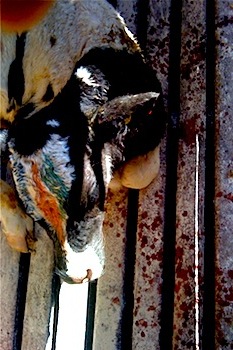
 Just
ask Kirt Espenson (right), whose employees at E6
Cattle Company in Southwest Texas were videotaped
bashing cows’ heads in with pickaxes and hammers and performing
other acts of unspeakably sickening cruelty.
Just
ask Kirt Espenson (right), whose employees at E6
Cattle Company in Southwest Texas were videotaped
bashing cows’ heads in with pickaxes and hammers and performing
other acts of unspeakably sickening cruelty.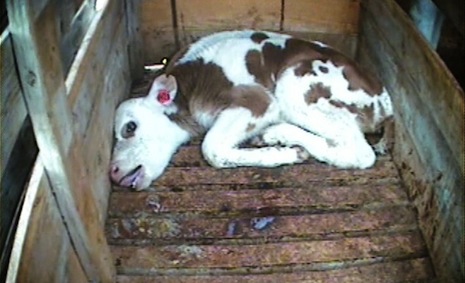 The
offending employees have been terminated. Nothing like this has ever
happened before. Nothing like this will ever happen again.
The
offending employees have been terminated. Nothing like this has ever
happened before. Nothing like this will ever happen again.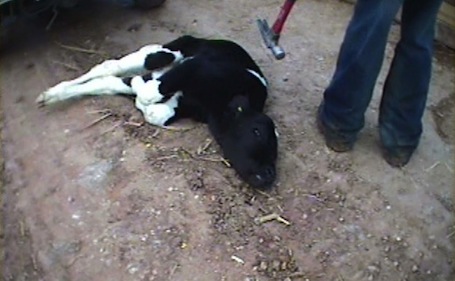 And
these may be moving in the wrong direction. In their infinite
wisdom the legislatures of Iowa, Minnesota, Florida and others are
considering measures that would punish heroic videographers like the
one who spent two weeks as an E6 employee, who was clearly traumatized
by the experience. (I spoke to him on the phone Saturday,
with a guarantee of anonymity.)
And
these may be moving in the wrong direction. In their infinite
wisdom the legislatures of Iowa, Minnesota, Florida and others are
considering measures that would punish heroic videographers like the
one who spent two weeks as an E6 employee, who was clearly traumatized
by the experience. (I spoke to him on the phone Saturday,
with a guarantee of anonymity.)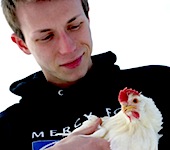 sweeping,”
says Nathan Runkle (right), the executive director of Mercy for Animals,
“that if you took a picture of a dog at a pet shop and texted
it to someone, that could be a crime.” Unconstitutional?
Probably, but there it is.
sweeping,”
says Nathan Runkle (right), the executive director of Mercy for Animals,
“that if you took a picture of a dog at a pet shop and texted
it to someone, that could be a crime.” Unconstitutional?
Probably, but there it is.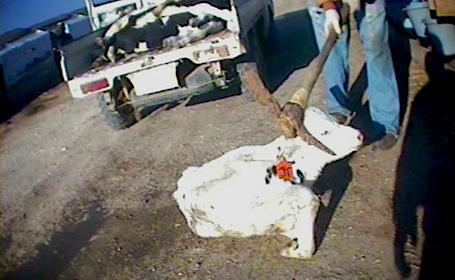 That
is not the norm on factory farms. Espenson insists that it
was a coincidence that the investigator for Mercy for Animals showed
up just when his workers were hammering cows’ heads; the videographer
believes it was routine. And, while the farmer claims
that extreme weather had hurt the cows, Weather Underground recorded
that the weather was far from extreme during the period in question.
The investigator theorizes that weaker, less desirable animals
were sickened by living in their own feces.
That
is not the norm on factory farms. Espenson insists that it
was a coincidence that the investigator for Mercy for Animals showed
up just when his workers were hammering cows’ heads; the videographer
believes it was routine. And, while the farmer claims
that extreme weather had hurt the cows, Weather Underground recorded
that the weather was far from extreme during the period in question.
The investigator theorizes that weaker, less desirable animals
were sickened by living in their own feces. killing
10 billion animals every year, some abuse is pretty much guaranteed.
killing
10 billion animals every year, some abuse is pretty much guaranteed.





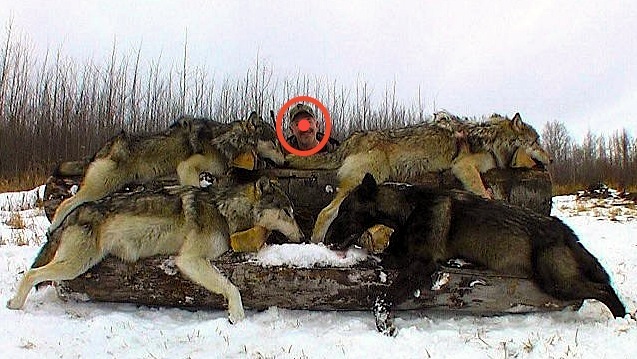
 first
acts as secretary was to de-list the animal in Idaho and Montana,
arguing that populations had recovered and that the states could
now manage them. A federal judge [Donald W. Molloy (left)]
overturned his ruling, as well as a compromise plan that Mr. Salazar
worked out with environmental groups.
first
acts as secretary was to de-list the animal in Idaho and Montana,
arguing that populations had recovered and that the states could
now manage them. A federal judge [Donald W. Molloy (left)]
overturned his ruling, as well as a compromise plan that Mr. Salazar
worked out with environmental groups. but
the Interior Department must hold the states to the terms of a
five-year review process required by their management plans.
but
the Interior Department must hold the states to the terms of a
five-year review process required by their management plans.


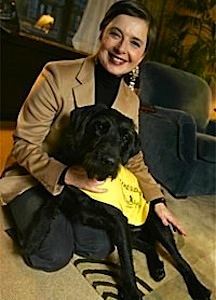
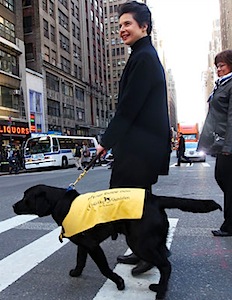 lamppost.
Especially when your human has a money face. When she is, say, Isabella
Rossellini.
lamppost.
Especially when your human has a money face. When she is, say, Isabella
Rossellini.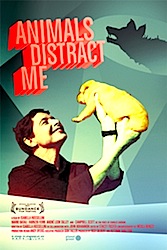 Ms.
Rossellini also walks a four-legged trainee around town in Animals
Distract Me, an hourlong documentary she made for the cable
channel Planet Green that is having its premiere on Saturday. In the
film, that dog, Sweety, drops in on some of Ms. Rossellini’s
famous friends, like the chef Mario Batali, and Ms. Rossellini gets
a chance to expound not just on guide dog training but also on her
broader concern for
Ms.
Rossellini also walks a four-legged trainee around town in Animals
Distract Me, an hourlong documentary she made for the cable
channel Planet Green that is having its premiere on Saturday. In the
film, that dog, Sweety, drops in on some of Ms. Rossellini’s
famous friends, like the chef Mario Batali, and Ms. Rossellini gets
a chance to expound not just on guide dog training but also on her
broader concern for  animals,
cruelty-free menu choices and other subjects.
animals,
cruelty-free menu choices and other subjects. Two series of very short films that Ms. Rossellini made for the Sundance
Channel, “Green Porno” and “Seduce Me,” about
the sex lives of spiders, dolphins and assorted other creatures, border
on the bizarre. They are droll and informational at the same
time and, like some vignettes in “Animals Distract Me,”
feature Ms. Rossellini in an array of outlandish costumes.
For instance, the whale suit she dons to show the male half of that
species in midreproduction leaves nothing to the imagination in terms
of the animal’s appendages. Ms. Rossellini may have a highbrow
pedigree — her father was the director Roberto Rossellini,
her mother Ingrid Bergman — but she has a wicked, winking
sense of humor.
Two series of very short films that Ms. Rossellini made for the Sundance
Channel, “Green Porno” and “Seduce Me,” about
the sex lives of spiders, dolphins and assorted other creatures, border
on the bizarre. They are droll and informational at the same
time and, like some vignettes in “Animals Distract Me,”
feature Ms. Rossellini in an array of outlandish costumes.
For instance, the whale suit she dons to show the male half of that
species in midreproduction leaves nothing to the imagination in terms
of the animal’s appendages. Ms. Rossellini may have a highbrow
pedigree — her father was the director Roberto Rossellini,
her mother Ingrid Bergman — but she has a wicked, winking
sense of humor. Planet
Green, part of Discovery’s group of channels.
Planet
Green, part of Discovery’s group of channels.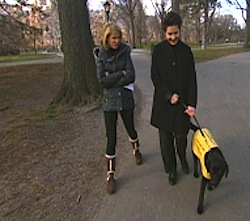 sometimes
needed.
sometimes
needed.


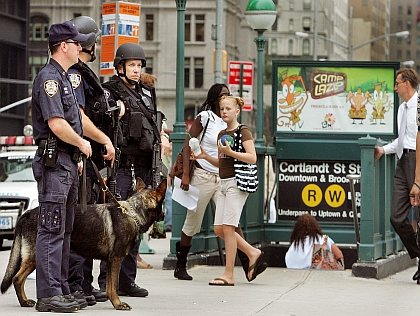
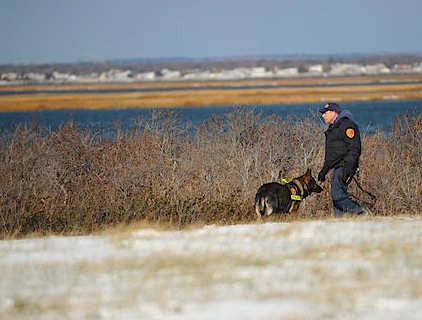 Island
since December. All of them have been discovered by the police.
Five of them were found by the same officer and his partner.
Island
since December. All of them have been discovered by the police.
Five of them were found by the same officer and his partner.

 prison.
prison.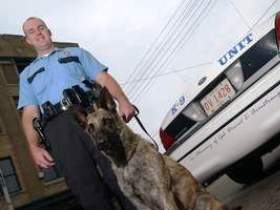 briefly
held six family members at gunpoint before leaving for Canton.
briefly
held six family members at gunpoint before leaving for Canton. U.S. K-9 MEMORIAL MONUMENTS
U.S. K-9 MEMORIAL MONUMENTS 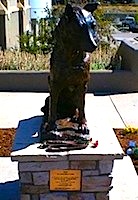

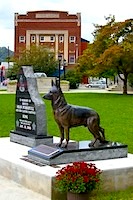
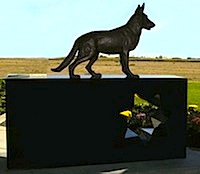
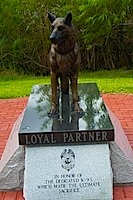
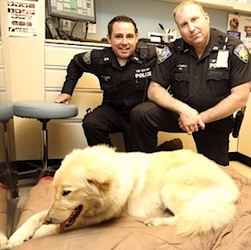
 year-old
Labrador retriever mix, was flown to the United States to
unite with a new owner, Hong Kong actress Joan Chen (right).
But he got separated from his handlers at Kennedy
Airport and wandered near the tarmac for three days
before he was found, authorities said yesterday.
year-old
Labrador retriever mix, was flown to the United States to
unite with a new owner, Hong Kong actress Joan Chen (right).
But he got separated from his handlers at Kennedy
Airport and wandered near the tarmac for three days
before he was found, authorities said yesterday.
 A
few months ago Newschannel 3 introduced you to the
group when they had to raise nearly $600,000 to put an offer on the
house. Now thanks to donations and a loan the group is just weeks
away from closing and moving in.
A
few months ago Newschannel 3 introduced you to the
group when they had to raise nearly $600,000 to put an offer on the
house. Now thanks to donations and a loan the group is just weeks
away from closing and moving in.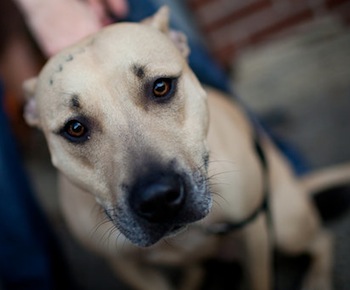 almost
as often as she takes them to the neighborhood dog run.
almost
as often as she takes them to the neighborhood dog run.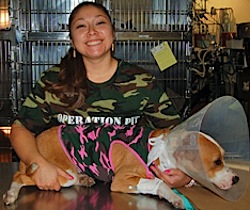 Local
shelters often offer free or low-cost spaying and neutering for dogs
and cats, said Dr. Louise Murray (right), vice president at
the American Society for the Prevention of Cruelty to Animal’s
Bergh Memorial Animal Hospital in New York and author
of “Vet Confidential.” To find a shelter near
you, check the ASPCA
website at
Local
shelters often offer free or low-cost spaying and neutering for dogs
and cats, said Dr. Louise Murray (right), vice president at
the American Society for the Prevention of Cruelty to Animal’s
Bergh Memorial Animal Hospital in New York and author
of “Vet Confidential.” To find a shelter near
you, check the ASPCA
website at 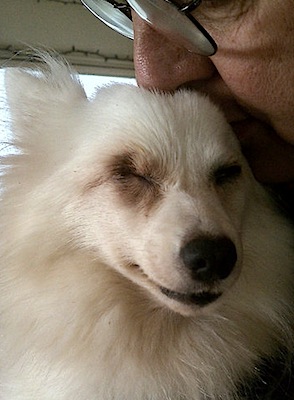 veggie
lasagna, Douglas Wilkins took a glob of cream cheese
from a container and fed it to Thisbe, a white fluffy Eskie
that he and his wife had just adopted. Thisbe wagged her tail, seeming
to enjoy a night on the town, but moments later regurgitated her meal.
veggie
lasagna, Douglas Wilkins took a glob of cream cheese
from a container and fed it to Thisbe, a white fluffy Eskie
that he and his wife had just adopted. Thisbe wagged her tail, seeming
to enjoy a night on the town, but moments later regurgitated her meal. San
Francisco is renowned as a haven for pets. Dogs outnumber
children, and instead of cages, animals at the local S.P.C.A. reside
in rooms that rival some nearby studio apartments. This
is, after all, a city named for St. Francis of Assisi, the patron
saint of animals.
San
Francisco is renowned as a haven for pets. Dogs outnumber
children, and instead of cages, animals at the local S.P.C.A. reside
in rooms that rival some nearby studio apartments. This
is, after all, a city named for St. Francis of Assisi, the patron
saint of animals. pet
can be adopted.
pet
can be adopted. Ms. Felicity retrieved the animals at the owners’ request. “It
looked like they were backyard breeders who wanted out of the business,”
she said of the owners. Eskie puppies sell for as much as
$1,400 each. The dogs had stopped reproducing and were instead
in a health tailspin. Their yard was full of
Ms. Felicity retrieved the animals at the owners’ request. “It
looked like they were backyard breeders who wanted out of the business,”
she said of the owners. Eskie puppies sell for as much as
$1,400 each. The dogs had stopped reproducing and were instead
in a health tailspin. Their yard was full of  Wilkins
said.
Wilkins
said. Scott James
is an Emmy-winning television journalist and novelist who lives in
San Francisco.
Scott James
is an Emmy-winning television journalist and novelist who lives in
San Francisco.


 with
multiple dog fighting operations in Halifax, Virginia.
Working closely with the Bureau of Alcohol, Tobacco, Firearms
and Explosives (ATF) and the United States Attorney’s
Office, the ASPCA
assisted in what is being dubbed one of the largest dog fighting
busts
with
multiple dog fighting operations in Halifax, Virginia.
Working closely with the Bureau of Alcohol, Tobacco, Firearms
and Explosives (ATF) and the United States Attorney’s
Office, the ASPCA
assisted in what is being dubbed one of the largest dog fighting
busts  the
area has ever seen.
the
area has ever seen.

 pull
the controversial Dog Wars virtual dogfighting game app from its phone
app marketplace.
pull
the controversial Dog Wars virtual dogfighting game app from its phone
app marketplace.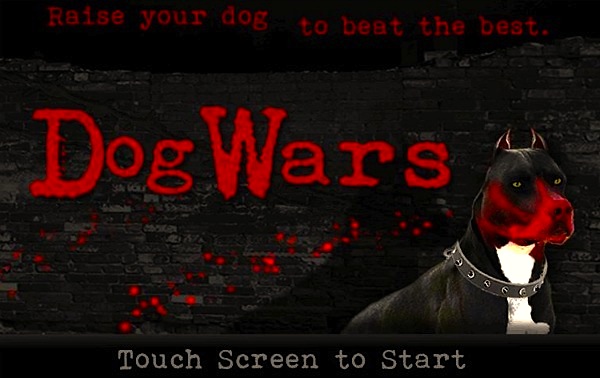
 Samantha
Ronson (right), the celebrity D.J. and former girlfriend of Lindsay
Lohan , was mortified last year when the news media learned
that her Bulldog, Cadillac, had attacked and killed
a tiny Maltese at her West Hollywood
apartment building.
Samantha
Ronson (right), the celebrity D.J. and former girlfriend of Lindsay
Lohan , was mortified last year when the news media learned
that her Bulldog, Cadillac, had attacked and killed
a tiny Maltese at her West Hollywood
apartment building. that
his tiny Yorkie, named Stevie Nicks, snapped at interns.
that
his tiny Yorkie, named Stevie Nicks, snapped at interns. Are these dogs getting an unleashed sense of entitlement from their
owners? Yes, said David Reinecker, a Beverly Hills dog trainer
whose clients include Maria Shriver, Kirk Douglas and
Are these dogs getting an unleashed sense of entitlement from their
owners? Yes, said David Reinecker, a Beverly Hills dog trainer
whose clients include Maria Shriver, Kirk Douglas and 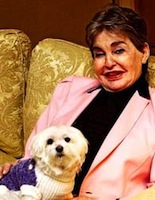 Teri
Garr. “The elite are extreme personalities,” he
said. “Some come home from a day at the office of controlling
armies of frightened people and then let their dogs rule their lives.
On top of that, the mega-rich and powerful can be very insecure.”
Teri
Garr. “The elite are extreme personalities,” he
said. “Some come home from a day at the office of controlling
armies of frightened people and then let their dogs rule their lives.
On top of that, the mega-rich and powerful can be very insecure.” Then
there are the women who use dogs as security blankets and take them
to red carpet events like arm candy. Paris Hilton’s
Tinkerbell was known to snap and bite. “Little dogs
sense their owners’ fear of strangers and paparazzi, so they
growl and snap at them,” said Mr. Reinecker, who as a trainer
has found that there’s a bull market in bad dogs right now
Then
there are the women who use dogs as security blankets and take them
to red carpet events like arm candy. Paris Hilton’s
Tinkerbell was known to snap and bite. “Little dogs
sense their owners’ fear of strangers and paparazzi, so they
growl and snap at them,” said Mr. Reinecker, who as a trainer
has found that there’s a bull market in bad dogs right now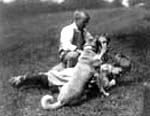 No
home, however stately, is immune. That includes the White
House. The Pit Bull of Theodore
Roosevelt (left) was known for ripping the pants off a French
ambassador. And although Bo, the Obamas’ Portuguese
Water Dog, is incident free for now, recent presidential
dogs in the dog house included Buddy, the Clintons’
cat-attacking Labrador Retriever, and Barney, the
Scottish terrier of George and Laura Bush, who bit a journalist.
No
home, however stately, is immune. That includes the White
House. The Pit Bull of Theodore
Roosevelt (left) was known for ripping the pants off a French
ambassador. And although Bo, the Obamas’ Portuguese
Water Dog, is incident free for now, recent presidential
dogs in the dog house included Buddy, the Clintons’
cat-attacking Labrador Retriever, and Barney, the
Scottish terrier of George and Laura Bush, who bit a journalist.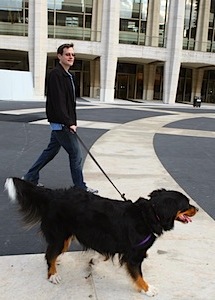
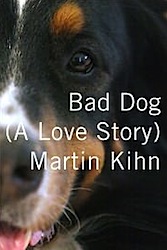
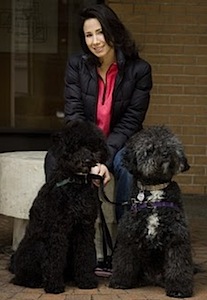 It’s
a Dog’s Life, an upmarket training service. She usually
requires six sessions (at about $175 a session) to
prep dogs for interviews.
It’s
a Dog’s Life, an upmarket training service. She usually
requires six sessions (at about $175 a session) to
prep dogs for interviews.

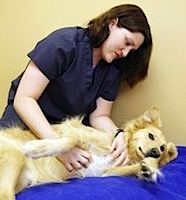 been
no thorough systematic examination of breed-related causes
of death.
been
no thorough systematic examination of breed-related causes
of death.
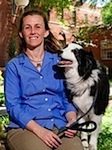 Diseases
of the nervous system were the most common cause of death in older
dogs, while gastrointestinal disease affected dogs of all ages equally.
Death from diseases of the musculoskeletal system was common in larger
breeds, but the big dogs suffered less from neurological and endocrine
ailments.
Diseases
of the nervous system were the most common cause of death in older
dogs, while gastrointestinal disease affected dogs of all ages equally.
Death from diseases of the musculoskeletal system was common in larger
breeds, but the big dogs suffered less from neurological and endocrine
ailments.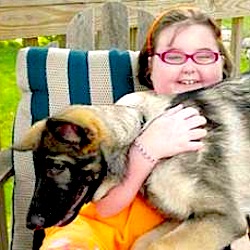
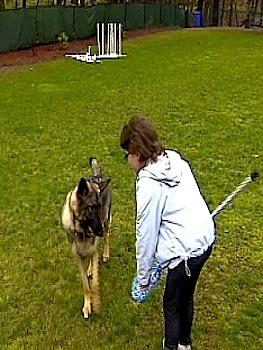 This
Dog attacks TWO kids from the same family? Any others? Has the Dog
attacked any children in the neighborhood OTHER than the Gernhardts’?
This
Dog attacks TWO kids from the same family? Any others? Has the Dog
attacked any children in the neighborhood OTHER than the Gernhardts’?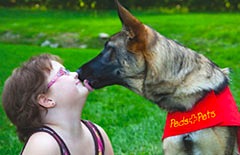
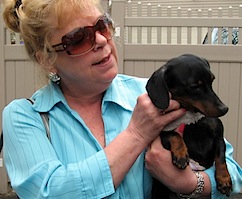


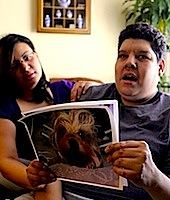

 will
join others, such as Pennsylvania and Massachussestts,
in adopting a state dog.
will
join others, such as Pennsylvania and Massachussestts,
in adopting a state dog.
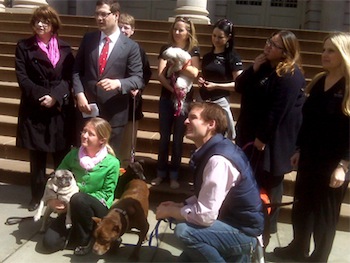 Assemblymembers
Micah Kellner and Linda Rosenthal propose that adopted
shelter and “rescue” dogs become the official state canine.
Assemblymembers
Micah Kellner and Linda Rosenthal propose that adopted
shelter and “rescue” dogs become the official state canine.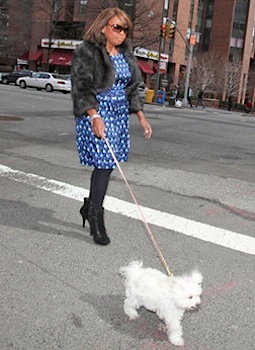 JUICE,
NO COFFEE
JUICE,
NO COFFEE spending
such a large part of my day chasing people with dogs away from plant
beds. As a dog owner myself, I find it almost impossible
to tell something as cute as a French bulldog puppy what to do. But
it is absolutely necessary if we want our greenery to thrive.
spending
such a large part of my day chasing people with dogs away from plant
beds. As a dog owner myself, I find it almost impossible
to tell something as cute as a French bulldog puppy what to do. But
it is absolutely necessary if we want our greenery to thrive.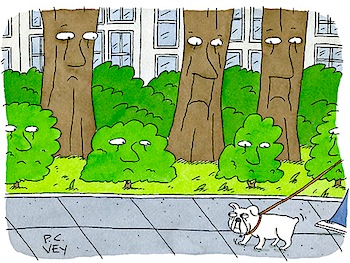 After a less than scientific survey of dog owners, it is clear that
a majority think their pets’ urine is good for plants. Owners
fantasize about their dogs in a forest, running free, bestowing lucky
trees with much needed fertilizer. Miffy, they say,
is doing the same thing here, for the less fortunate urban trees.
After a less than scientific survey of dog owners, it is clear that
a majority think their pets’ urine is good for plants. Owners
fantasize about their dogs in a forest, running free, bestowing lucky
trees with much needed fertilizer. Miffy, they say,
is doing the same thing here, for the less fortunate urban trees.

 found
on Tuesday.
found
on Tuesday. Station.
Station.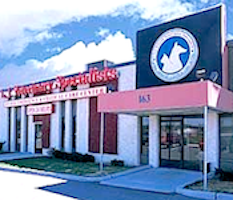 operators
found the canine stowaway in Farmingdale on
Tuesday.
operators
found the canine stowaway in Farmingdale on
Tuesday. Affectionate
Dog Found On LIRR Train Returns Home
Affectionate
Dog Found On LIRR Train Returns Home is
back at home on Long Island Friday.
is
back at home on Long Island Friday.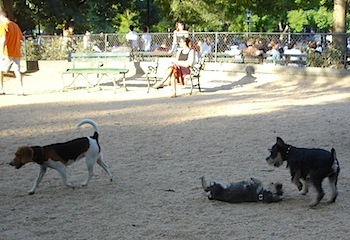 With
spring here and more dog owners and their animals getting out, the
Anti-Cruelty Society is offering some timely advice. Read and enjoy
– and have fun at dog park.
With
spring here and more dog owners and their animals getting out, the
Anti-Cruelty Society is offering some timely advice. Read and enjoy
– and have fun at dog park.
 discovered
the pups on his property on Van Holten Road in Basking Ridge.
discovered
the pups on his property on Van Holten Road in Basking Ridge.

 Game!
Game!
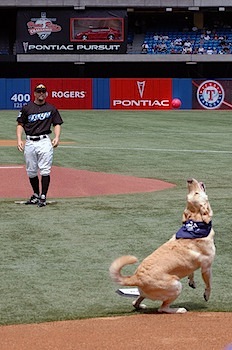 MLB
2010 Dog Days Games
MLB
2010 Dog Days Games Houston Astros - Dog Day: April 11 vs. Philadelphia
Houston Astros - Dog Day: April 11 vs. Philadelphia




 old
pit bull that was starved and dumped down an apartment trash
chute, an official with the New Jersey Society
for the Prevention of Cruelty to Animals said Sunday.
old
pit bull that was starved and dumped down an apartment trash
chute, an official with the New Jersey Society
for the Prevention of Cruelty to Animals said Sunday. according
to Saracino.
according
to Saracino. A
New Jersey woman accused of starving a dog that was found at the bottom
of a trash chute pleaded not guilty Thursday to animal abuse
charges, as letters and donations poured in from the around the world
in support of the 1-year-old pit bull nicknamed Patrick.
A
New Jersey woman accused of starving a dog that was found at the bottom
of a trash chute pleaded not guilty Thursday to animal abuse
charges, as letters and donations poured in from the around the world
in support of the 1-year-old pit bull nicknamed Patrick.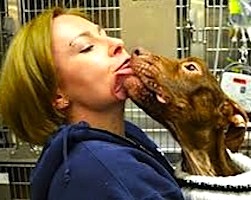 Patrick,
named because he was found the day before St. Patrick’s Day,
is being treated at Garden State Veterinary Specialists in
Tinton Falls. On its website, the center wrote that is has
received so many donations that it has discontinued accepting them
and is urging people to donate to local animal shelters.
Patrick,
named because he was found the day before St. Patrick’s Day,
is being treated at Garden State Veterinary Specialists in
Tinton Falls. On its website, the center wrote that is has
received so many donations that it has discontinued accepting them
and is urging people to donate to local animal shelters.
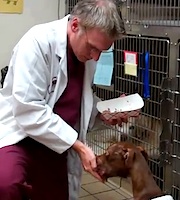
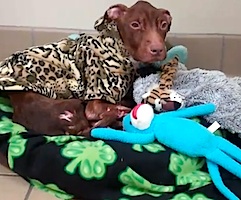
 Animal
From the Endangered Species List
Animal
From the Endangered Species List
 animal
from it, establishing a precedent for political influence over the
list that has outraged environmental groups.
animal
from it, establishing a precedent for political influence over the
list that has outraged environmental groups. off
arguments from environmental advocates that Congress had crossed a
crucial line.
off
arguments from environmental advocates that Congress had crossed a
crucial line.
 The
two sides had recently reached a proposed settlement of a federal
lawsuit brought by environmental groups against the Fish and Wildlife
Service and Idaho and Montana officials. But the judge, Donald
W. Molloy (left),
rejected the settlement.
The
two sides had recently reached a proposed settlement of a federal
lawsuit brought by environmental groups against the Fish and Wildlife
Service and Idaho and Montana officials. But the judge, Donald
W. Molloy (left),
rejected the settlement.
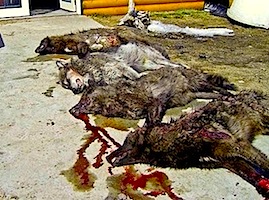 Conservation
programs at the Department of Agriculture will be reduced by $800
million, while the agency’s Environmental Quality Incentives
Program will be cut by $350 million,
essentially ending its financing for the rest of the fiscal year,
officials said.
Conservation
programs at the Department of Agriculture will be reduced by $800
million, while the agency’s Environmental Quality Incentives
Program will be cut by $350 million,
essentially ending its financing for the rest of the fiscal year,
officials said.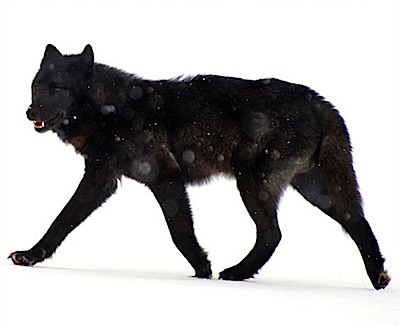 pick
up a copy of an unconventional new field guide: the 2010 Annual
Report of the Alaska Department of Law.
pick
up a copy of an unconventional new field guide: the 2010 Annual
Report of the Alaska Department of Law. attorney
general, John J. Burns, made clear in an accompanying letter
to Gov. Sean Parnell (left) and
state lawmakers, the fate of Arctic wildlife is just one front
in the fight to free Alaska from the federal environmental restrictions
that limit its ability to drill for oil, build roads, mine precious
metals and otherwise make a living developing the state and
its abundant natural resources.
attorney
general, John J. Burns, made clear in an accompanying letter
to Gov. Sean Parnell (left) and
state lawmakers, the fate of Arctic wildlife is just one front
in the fight to free Alaska from the federal environmental restrictions
that limit its ability to drill for oil, build roads, mine precious
metals and otherwise make a living developing the state and
its abundant natural resources. “The
Department of Law, in conjunction with other state agencies and with
the assistance of the administration and the Legislature, must and
will remain vigilant in protecting against the federal regulatory
overreach that threatens our socioeconomic well-being,” Mr.
Burns (right) wrote.
“The
Department of Law, in conjunction with other state agencies and with
the assistance of the administration and the Legislature, must and
will remain vigilant in protecting against the federal regulatory
overreach that threatens our socioeconomic well-being,” Mr.
Burns (right) wrote.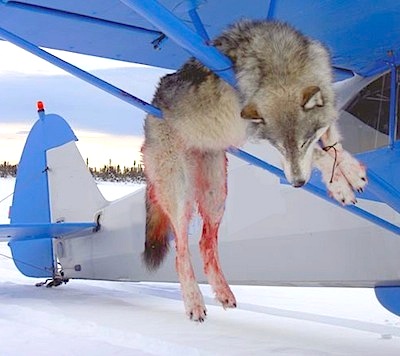

 earthquake
and subsequent tsunami, animal welfare groups are working around the
clock to find food, shelter and medicine for the country's animals.
earthquake
and subsequent tsunami, animal welfare groups are working around the
clock to find food, shelter and medicine for the country's animals.


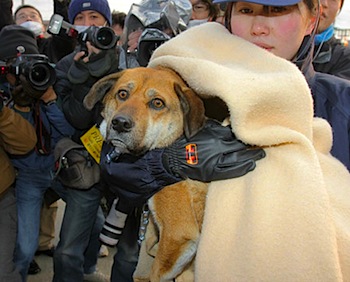 dog
wagged its tail and jumped up to a woman described by local media
as a relative of the owner as she collected her to deliver back to
her family for what promises to be a warm reunion.
dog
wagged its tail and jumped up to a woman described by local media
as a relative of the owner as she collected her to deliver back to
her family for what promises to be a warm reunion.



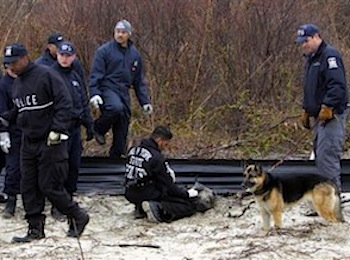
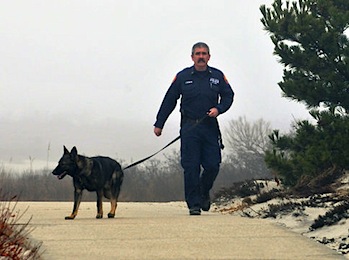
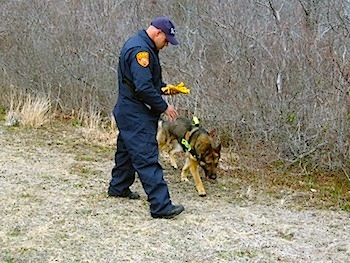
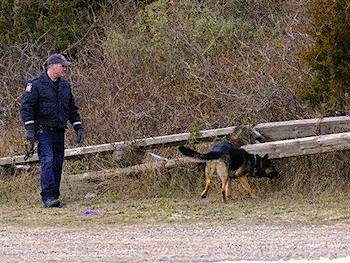
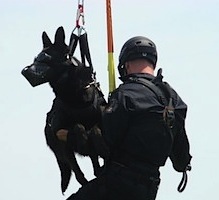


 who
generally gives commands in German, and another 200 hours of training
to detect narcotics.
who
generally gives commands in German, and another 200 hours of training
to detect narcotics.
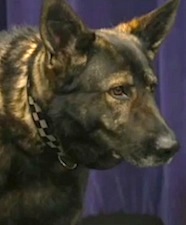
 Tuesday.
Grandberg s retiring after 34 years of police service. He's
taking along his canine partner, Lexo,
who has spent the past five years with him.
Tuesday.
Grandberg s retiring after 34 years of police service. He's
taking along his canine partner, Lexo,
who has spent the past five years with him.
 thank
Mike for many years of dedicated service your contributions to the
narcotic unit," said narcotics commander James O'Grady (right).
"I don't think I have ever met or worked with someone so dedicated
and willing to come to work in a great mood."
thank
Mike for many years of dedicated service your contributions to the
narcotic unit," said narcotics commander James O'Grady (right).
"I don't think I have ever met or worked with someone so dedicated
and willing to come to work in a great mood."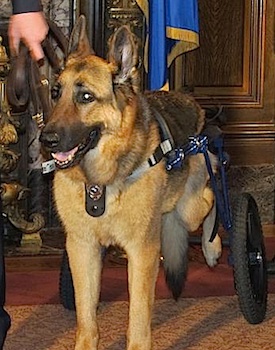
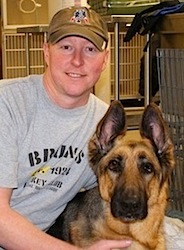


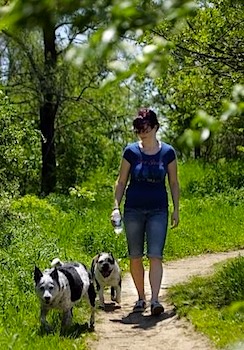 that
would require off-leash park users to buy a permit — and to
wear a lanyard proving they have done so. "They took offense
and thought we were kind of making the owners wear a leash, which
is not the case at all," said Laurie Metanchuk, community
affairs director for the forest preserve.
that
would require off-leash park users to buy a permit — and to
wear a lanyard proving they have done so. "They took offense
and thought we were kind of making the owners wear a leash, which
is not the case at all," said Laurie Metanchuk, community
affairs director for the forest preserve.




 “Scritch-Scratch,”
too, is illustrated with a great deal of humor, in this case by an
editorial cartoonist, Mike Lester (left, “A
Is for Salad,”). Marcus’s story, her debut, is written
in playful rhyming couplets with a this-leads-to-that storyline recalling
“Because a Little Bug Went Ka-Choo!,” by Dr. Seuss (writing
as Rosetta Stone) and Michael Frith.
“Scritch-Scratch,”
too, is illustrated with a great deal of humor, in this case by an
editorial cartoonist, Mike Lester (left, “A
Is for Salad,”). Marcus’s story, her debut, is written
in playful rhyming couplets with a this-leads-to-that storyline recalling
“Because a Little Bug Went Ka-Choo!,” by Dr. Seuss (writing
as Rosetta Stone) and Michael Frith.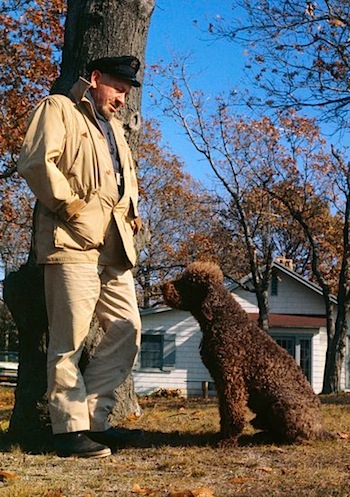 problem
was he had lost touch with America. He outfitted a three-quarter-ton
pickup truck as a sort of land yacht and set off from his home in
Sag Harbor, N.Y., with his French poodle,
Charley,
to drive cross-country. The idea was that he would travel alone, stay
at campgrounds and reconnect himself with the country by talking to
the locals he met along the way.
problem
was he had lost touch with America. He outfitted a three-quarter-ton
pickup truck as a sort of land yacht and set off from his home in
Sag Harbor, N.Y., with his French poodle,
Charley,
to drive cross-country. The idea was that he would travel alone, stay
at campgrounds and reconnect himself with the country by talking to
the locals he met along the way.
 wasn’t
anywhere near Alice. He was in Beach, N.D., more than 300 miles to
the west, staying not in the camper but in a motel.
wasn’t
anywhere near Alice. He was in Beach, N.D., more than 300 miles to
the west, staying not in the camper but in a motel. Susan
Shillinglaw (left), who teaches English at San Jose
State University and is a scholar in residence at the National
Steinbeck Center in Salinas, Calif., said in a phone interview:
“Any writer has the right to shape materials, and undoubtedly
Steinbeck left things out. That doesn’t make the book a lie.”
Susan
Shillinglaw (left), who teaches English at San Jose
State University and is a scholar in residence at the National
Steinbeck Center in Salinas, Calif., said in a phone interview:
“Any writer has the right to shape materials, and undoubtedly
Steinbeck left things out. That doesn’t make the book a lie.” With
Charley,” said he was surprised to learn that Elaine Steinbeck
had accompanied her husband on so much of the trip. “I spent
several hours with Elaine, and she never mentioned that,” he
added. “She made a big deal about how painful it was for them
to be separated and how she insisted that he take the dog along for
company.”
With
Charley,” said he was surprised to learn that Elaine Steinbeck
had accompanied her husband on so much of the trip. “I spent
several hours with Elaine, and she never mentioned that,” he
added. “She made a big deal about how painful it was for them
to be separated and how she insisted that he take the dog along for
company.”
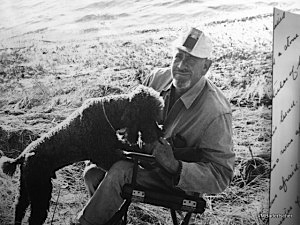 Steigerwald-like
journey, in which he came to some more upbeat conclusions than Steinbeck
had. “I’m fairly certain that Steinbeck made up
most of the book,” he said recently. “The dialogue is
so wooden.”
Steigerwald-like
journey, in which he came to some more upbeat conclusions than Steinbeck
had. “I’m fairly certain that Steinbeck made up
most of the book,” he said recently. “The dialogue is
so wooden.”
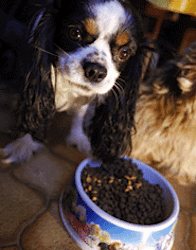
 adult
dogs and pups, experts say that brands can vary widely in their ingredients
and there are no requirements for what goes in foods for older
canines.
adult
dogs and pups, experts say that brands can vary widely in their ingredients
and there are no requirements for what goes in foods for older
canines.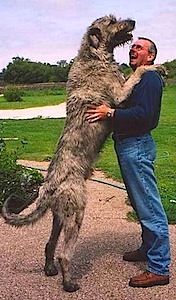 Also,
the term "old" is extremely relative in the canine world.
The average lifespan for an Irish Wolfhound is only
about six years but "a toy Poodle at 7 is very
young still,"
Also,
the term "old" is extremely relative in the canine world.
The average lifespan for an Irish Wolfhound is only
about six years but "a toy Poodle at 7 is very
young still,"  Freeman
explained. Some "old" dogs may be the picture of perfect
health, while others might have a medical condition that warrants
less sodium, for example, she said.
Freeman
explained. Some "old" dogs may be the picture of perfect
health, while others might have a medical condition that warrants
less sodium, for example, she said.
 distinct
needs," said Kurt Gallagher, a spokesman for
the Pet Food Institute (left), a trade group. "Attaining
senior status depends on several factors, including the breed and
weight of the dog. The differing nutritional needs of dogs are exemplified
by the variance in the amount of protein senior dogs should consume."
distinct
needs," said Kurt Gallagher, a spokesman for
the Pet Food Institute (left), a trade group. "Attaining
senior status depends on several factors, including the breed and
weight of the dog. The differing nutritional needs of dogs are exemplified
by the variance in the amount of protein senior dogs should consume."
 euthanized
at a veterinary hospital shortly after their rescue, Richard
Gentles, a spokesman for Animal Care and Control of New York City
(right), said this week.
euthanized
at a veterinary hospital shortly after their rescue, Richard
Gentles, a spokesman for Animal Care and Control of New York City
(right), said this week.

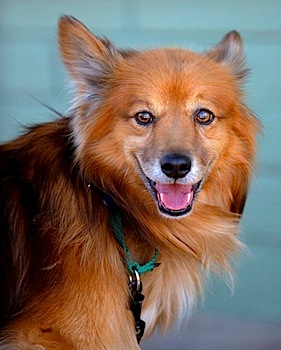 Redd
the dog, however, had the entire city of Oak Brook,
Illinois, rooting for him. He spent four years living on
their streets, where the citizens tried hard to keep him safe. They
considered him one of their own.
Redd
the dog, however, had the entire city of Oak Brook,
Illinois, rooting for him. He spent four years living on
their streets, where the citizens tried hard to keep him safe. They
considered him one of their own.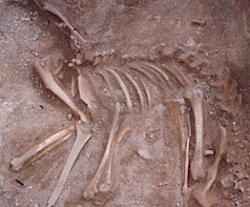 research.
These poodle-sized dogs raise a lot of questions about the earliest
domestication of dogs, due to their impressive age and the fact that
most other prehistoric pooches were much larger.
research.
These poodle-sized dogs raise a lot of questions about the earliest
domestication of dogs, due to their impressive age and the fact that
most other prehistoric pooches were much larger.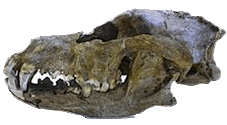


 Pionnier-Capitan
believes these dogs had a height below about 17 inches. "Such
sizes are found nowadays in breeds like the standard Poodle, Beagle
or Cocker," she said.
Pionnier-Capitan
believes these dogs had a height below about 17 inches. "Such
sizes are found nowadays in breeds like the standard Poodle, Beagle
or Cocker," she said. dinner
menu either. "Some of the remains we studied also present some
cut marks that imply the animals had been eaten and their fur may
have been used," Pionnier-Capitan explained.
dinner
menu either. "Some of the remains we studied also present some
cut marks that imply the animals had been eaten and their fur may
have been used," Pionnier-Capitan explained. her
team identified what they believe is the world's first known dog.
Found in
her
team identified what they believe is the world's first known dog.
Found in  a
Belgian cave, the remains for this possible dog suggest that it lived
around 32,000 years ago and resembled a Siberian Husky. But it was
about the size of a large shepherd dog.
a
Belgian cave, the remains for this possible dog suggest that it lived
around 32,000 years ago and resembled a Siberian Husky. But it was
about the size of a large shepherd dog.
 But there’s good news. Born out of the crisis, are two local
organizations that are providing pet food to New Yorkers in need.
But there’s good news. Born out of the crisis, are two local
organizations that are providing pet food to New Yorkers in need. The
Animal Relief Fund, founded by Susan Kaufman
(right), has teamed up with both the Food Bank for New York
City and Long Island Cares to make pet food
available at 160 human food pantries in the five boroughs,
Nassau and Suffolk Counties.
The
Animal Relief Fund, founded by Susan Kaufman
(right), has teamed up with both the Food Bank for New York
City and Long Island Cares to make pet food
available at 160 human food pantries in the five boroughs,
Nassau and Suffolk Counties.
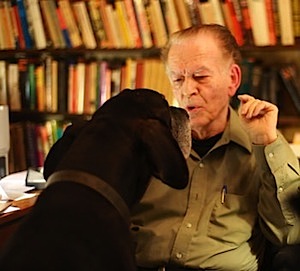 anointed
by the Daily Beast as “the 83-year-old
who toppled Egypt.” For decades, Sharp — through
his manuals and books, including From Dictatorship to Democracy,
The Politics of Nonviolent Action and 198 Methods
of Nonviolent Action— has argued that nonviolent action
is the best way to overcome repressive regimes.
anointed
by the Daily Beast as “the 83-year-old
who toppled Egypt.” For decades, Sharp — through
his manuals and books, including From Dictatorship to Democracy,
The Politics of Nonviolent Action and 198 Methods
of Nonviolent Action— has argued that nonviolent action
is the best way to overcome repressive regimes. “Many
animals and pets do all these things. Haven’t you had dogs or
cats act this way? They want to go with you in the car somewhere—when
they know they are not supposed to—they go and jump right in.
It’s a ‘sit-in.’ Or, they know very well what you’re
saying to them and pretend they don’t, just like you’ve
done yourself. Or you say ‘move,’ and they lie down, whimpering,
and look up at you with the saddest possible look—like some
demonstrators do to police. Sometimes they’re being ignored,
particularly if there’s company coming and there’s a big
fuss in the house and nobody’s paying attention to them when
they’re trying to say, ‘Come and play with me.’
The dog then goes into the middle of the living room rug and does
a ‘nonviolent intervention’—not biting anybody,
not growling at anybody but getting attention! So we don’t have
to change human nature—or even animal nature—in order
to be nonviolent.”
“Many
animals and pets do all these things. Haven’t you had dogs or
cats act this way? They want to go with you in the car somewhere—when
they know they are not supposed to—they go and jump right in.
It’s a ‘sit-in.’ Or, they know very well what you’re
saying to them and pretend they don’t, just like you’ve
done yourself. Or you say ‘move,’ and they lie down, whimpering,
and look up at you with the saddest possible look—like some
demonstrators do to police. Sometimes they’re being ignored,
particularly if there’s company coming and there’s a big
fuss in the house and nobody’s paying attention to them when
they’re trying to say, ‘Come and play with me.’
The dog then goes into the middle of the living room rug and does
a ‘nonviolent intervention’—not biting anybody,
not growling at anybody but getting attention! So we don’t have
to change human nature—or even animal nature—in order
to be nonviolent.”


 calmness
and overall emotional well-being,” Blair Kauffman, the
law librarian (left), wrote in an e-mail to students.
calmness
and overall emotional well-being,” Blair Kauffman, the
law librarian (left), wrote in an e-mail to students. A handful of other universities offer similar services, including
the University of Wisconsin at Oshkosh.
A handful of other universities offer similar services, including
the University of Wisconsin at Oshkosh.
 guards
up and police commissioner William Connors (right)
wants residents to be aware.
guards
up and police commissioner William Connors (right)
wants residents to be aware.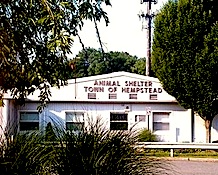
 alleged
that they witnessed shelter workers beating some of the homeless animals
and leaving others to die in their cages. Nassau County District
Attorney Kathleen Rice (left) launched a "criminal probe"
to investigate. Nothing has come of it, and the shelter banned all
volunteers from the premises for their trouble.
alleged
that they witnessed shelter workers beating some of the homeless animals
and leaving others to die in their cages. Nassau County District
Attorney Kathleen Rice (left) launched a "criminal probe"
to investigate. Nothing has come of it, and the shelter banned all
volunteers from the premises for their trouble.
 Something
is rotten in Hempstead, NY. And now, it's only getting worse.
Something
is rotten in Hempstead, NY. And now, it's only getting worse.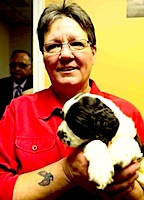
 funded
shelter, you draw the conclusion that the administration seems to
want to euthanize as many animals as possible? Well, you wouldn't
be the only one.
funded
shelter, you draw the conclusion that the administration seems to
want to euthanize as many animals as possible? Well, you wouldn't
be the only one.
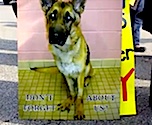




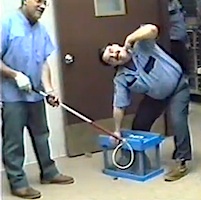
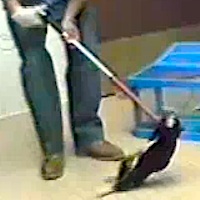

 The
protesters said they wanted to see reform at the shelter, where they
contend many animals were being euthanized and people were being prevented
from rescuing them.
The
protesters said they wanted to see reform at the shelter, where they
contend many animals were being euthanized and people were being prevented
from rescuing them.
 frequent
bouts of fever. Researchers now say that the same gene mutation
is responsible for both the wrinkles and the fever.
frequent
bouts of fever. Researchers now say that the same gene mutation
is responsible for both the wrinkles and the fever. Pit
bull chases patrol car; officer radios for help
Pit
bull chases patrol car; officer radios for help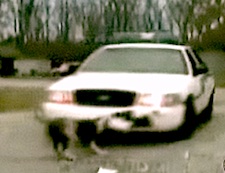
 weapon
at random, several times a day.
weapon
at random, several times a day. iPhone)
or let you leverage your pup to strengthen your own social network.
iPhone)
or let you leverage your pup to strengthen your own social network. is
where PupTox and, to a greater extent, Pet
First Aid come in handy. The apps can save you from a frantic
trip to the veterinarian’s office.
is
where PupTox and, to a greater extent, Pet
First Aid come in handy. The apps can save you from a frantic
trip to the veterinarian’s office.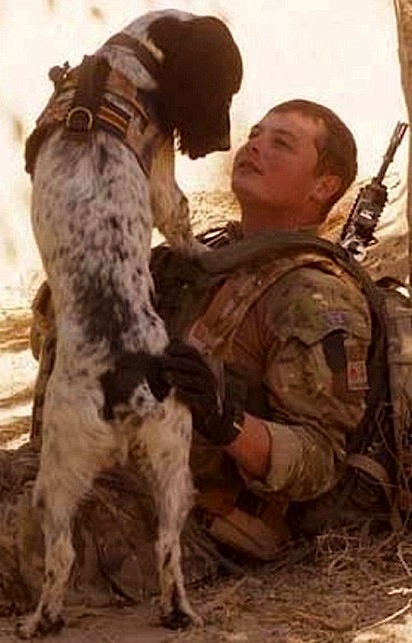 Shortly
after, his devoted 22-month-old bomb-sniffing dog, Theo,
who was with him when he died, suffered a seizure and also died.
Shortly
after, his devoted 22-month-old bomb-sniffing dog, Theo,
who was with him when he died, suffered a seizure and also died. Retired
escapologist Karl Bartoni is thought to be the first
person in the country to be allowed to be laid to rest with his dogs.
Retired
escapologist Karl Bartoni is thought to be the first
person in the country to be allowed to be laid to rest with his dogs.
 Barney,
a short-haired Border Collie, died in 1994 and Karl's vet
recommended Rossendale Pet Crematorium.
Barney,
a short-haired Border Collie, died in 1994 and Karl's vet
recommended Rossendale Pet Crematorium. But
by the time his Yorkshire Terrier Charlie died last
year Karl was working on convincing crematorium bosses to change their
minds.
But
by the time his Yorkshire Terrier Charlie died last
year Karl was working on convincing crematorium bosses to change their
minds.
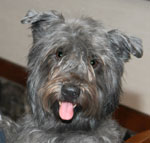 Glen
of Imaal, which is a valley in the Wicklow mountains, is the region
in Ireland after which this hardy breed is named. Longer than tall
and sporting a double coat of medium length, the "Glen"
possesses great strength and conveys the impression of a dog of good
substance. This is a working terrier, who must have the agility, freedom
of movement and endurance to do the work for which it was developed.
Like its Irish counterparts, the Glen is also courageous, and always
ready to give chase. When working, it is active, agile, silent and
intent upon its game. Otherwise, the Glen can be a docile companion
for families with older children.
Glen
of Imaal, which is a valley in the Wicklow mountains, is the region
in Ireland after which this hardy breed is named. Longer than tall
and sporting a double coat of medium length, the "Glen"
possesses great strength and conveys the impression of a dog of good
substance. This is a working terrier, who must have the agility, freedom
of movement and endurance to do the work for which it was developed.
Like its Irish counterparts, the Glen is also courageous, and always
ready to give chase. When working, it is active, agile, silent and
intent upon its game. Otherwise, the Glen can be a docile companion
for families with older children.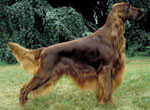 Green
may be the color of the Irish, but deep mahogany is the color of this
four-legged beauty. The Irish Setter was among the original breeds
recognized by AKC at its inception in 1884 and is part of the Sporting
Group. Irish Setters have rollicking personalities and require a good
amount of exercise to satisfy their breed instincts; they are tough
and tireless field retrievers. They are also loving companion dogs
who enjoy the company of children. It takes about three years for
this breed to fully mature into adulthood, so if you’re considering
bringing an Irish Setter into your home, you should be prepared for
an active, fun-loving dog.
Green
may be the color of the Irish, but deep mahogany is the color of this
four-legged beauty. The Irish Setter was among the original breeds
recognized by AKC at its inception in 1884 and is part of the Sporting
Group. Irish Setters have rollicking personalities and require a good
amount of exercise to satisfy their breed instincts; they are tough
and tireless field retrievers. They are also loving companion dogs
who enjoy the company of children. It takes about three years for
this breed to fully mature into adulthood, so if you’re considering
bringing an Irish Setter into your home, you should be prepared for
an active, fun-loving dog.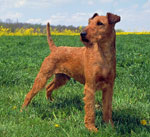 This
breed was featured in the 2007 movie "Firehouse Dog," where
it was cast as a canine hero. Not surprising, considering that Irish
Terriers were used to transport messages between troops on the front
lines in World War I. Their bravery and spirit make them incomparable
pals, and they possess great tenacity. Loyal and friendly, Irish Terriers
hardily adapt to any situation, and they are deeply committed to their
owners. Irish Terriers served as longtime mascots for the Notre Dame
Football team, providing halftime entertainment for adoring crowds.
The Irish Terrier was first recognized by the AKC in 1885.
This
breed was featured in the 2007 movie "Firehouse Dog," where
it was cast as a canine hero. Not surprising, considering that Irish
Terriers were used to transport messages between troops on the front
lines in World War I. Their bravery and spirit make them incomparable
pals, and they possess great tenacity. Loyal and friendly, Irish Terriers
hardily adapt to any situation, and they are deeply committed to their
owners. Irish Terriers served as longtime mascots for the Notre Dame
Football team, providing halftime entertainment for adoring crowds.
The Irish Terrier was first recognized by the AKC in 1885.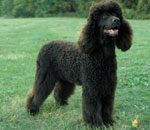 This
breed was among the original 9 breeds recognized by AKC in 1884. It
has been referred to as the "Shannon Spaniel," the "Whip-Tail
Spaniel," and the "Rat-Tail Spaniel." Distinguishing
characteristics are a topknot of long, loose curls and a body covered
with a dense, crisply curled liver colored coat, contrasted by a smooth
face and a smooth "rat" tail. This ancient breed is a natural
water dog. Irish Water Spaniels are devoted to their family and cautious
around strangers. They are impressive dogs and possess an endurance
quality which makes them equally agile in the water and in the field.
This
breed was among the original 9 breeds recognized by AKC in 1884. It
has been referred to as the "Shannon Spaniel," the "Whip-Tail
Spaniel," and the "Rat-Tail Spaniel." Distinguishing
characteristics are a topknot of long, loose curls and a body covered
with a dense, crisply curled liver colored coat, contrasted by a smooth
face and a smooth "rat" tail. This ancient breed is a natural
water dog. Irish Water Spaniels are devoted to their family and cautious
around strangers. They are impressive dogs and possess an endurance
quality which makes them equally agile in the water and in the field.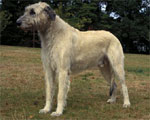 While
Irish literature refers to this ancient breed in many ways, including
"Big Dogs of Ireland," Irish Wolfhounds were documented
in Rome in the year 391 A.D., where they were presented to the Roman
Counsel as gifts, which "all Rome viewed with wonder." No
wonder-- they are the largest and tallest of the galloping hounds.
Males should be a minimum of 32" tall and weigh 120 pounds; females
should be a minimum of 30" tall and weigh 105 pounds. This is
a swift breed which hunts by sight, and needs an ample, fenced yard
to accommodate its full gallop. As in early times, Irish Wolfhounds
possess an extraordinary social temperament, as well as the intelligence
to separate friend, family and foe.
While
Irish literature refers to this ancient breed in many ways, including
"Big Dogs of Ireland," Irish Wolfhounds were documented
in Rome in the year 391 A.D., where they were presented to the Roman
Counsel as gifts, which "all Rome viewed with wonder." No
wonder-- they are the largest and tallest of the galloping hounds.
Males should be a minimum of 32" tall and weigh 120 pounds; females
should be a minimum of 30" tall and weigh 105 pounds. This is
a swift breed which hunts by sight, and needs an ample, fenced yard
to accommodate its full gallop. As in early times, Irish Wolfhounds
possess an extraordinary social temperament, as well as the intelligence
to separate friend, family and foe. The
"Kerry Blue" hails from the Irish county of the same name;
he had been purebred in that section of Ireland for more than a hundred
years. Known for his superior working and hunting skills, the Kerry
Blue is used for hunting small game and birds, and for retrieving
from land as well as water. Size doesn’t matter, for he is an
unsurpassed watch dog and herder of flock. In some instances in England,
he has even been used for police work. The breed was first recognized
by the AKC in 1922, and came into the national spotlight when CH.
Torums Scarf Michael won best in show at the 2002 AKC/Eukanuba National
Championship.
The
"Kerry Blue" hails from the Irish county of the same name;
he had been purebred in that section of Ireland for more than a hundred
years. Known for his superior working and hunting skills, the Kerry
Blue is used for hunting small game and birds, and for retrieving
from land as well as water. Size doesn’t matter, for he is an
unsurpassed watch dog and herder of flock. In some instances in England,
he has even been used for police work. The breed was first recognized
by the AKC in 1922, and came into the national spotlight when CH.
Torums Scarf Michael won best in show at the 2002 AKC/Eukanuba National
Championship.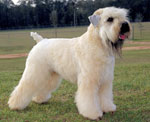 A
truly Irish breed, the "Wheaten" has a special connection
to St. Patrick’s Day, having first appeared in the show ring
at the Irish Kennel Club Championship on March 17, 1937. The name
of this breed describes the characteristics of the coat–soft,
silky, with a gentle wave, and of warm wheaten color. Underneath is
a formidable dog that enjoys plenty of exercise every day. Most Wheatens
are natural greeters towards people, and extremely alert in their
surroundings. They are quick learners and love to travel with their
owners. The Soft Coated Wheaten Terrier was first recognized by the
AKC in 1973.
A
truly Irish breed, the "Wheaten" has a special connection
to St. Patrick’s Day, having first appeared in the show ring
at the Irish Kennel Club Championship on March 17, 1937. The name
of this breed describes the characteristics of the coat–soft,
silky, with a gentle wave, and of warm wheaten color. Underneath is
a formidable dog that enjoys plenty of exercise every day. Most Wheatens
are natural greeters towards people, and extremely alert in their
surroundings. They are quick learners and love to travel with their
owners. The Soft Coated Wheaten Terrier was first recognized by the
AKC in 1973.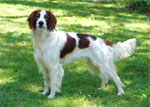 The
Irish Red & White Setter became an official AKC breed in 2009.
This breed is thought to have emerged at the end of the 17th Century
in Ireland, and is red and white in color, as opposed to the solid
red Irish Setter. The history of the breed is as mysterious as the
myths and legends of the country of origin. Its original purpose was
as a versatile hunting companion, providing food for the table, both
fur and feather. As companions, they are loving, loyal and best suited
for a very active family.
The
Irish Red & White Setter became an official AKC breed in 2009.
This breed is thought to have emerged at the end of the 17th Century
in Ireland, and is red and white in color, as opposed to the solid
red Irish Setter. The history of the breed is as mysterious as the
myths and legends of the country of origin. Its original purpose was
as a versatile hunting companion, providing food for the table, both
fur and feather. As companions, they are loving, loyal and best suited
for a very active family.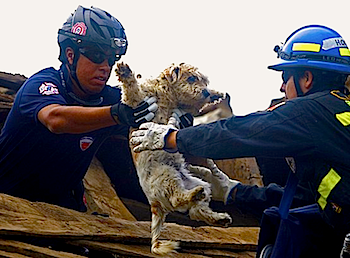



 family
unity. James, a chocolate-brown pointer mix, turned from adorable
pet to problem child in a matter of weeks.
family
unity. James, a chocolate-brown pointer mix, turned from adorable
pet to problem child in a matter of weeks. researchers
is now “companion animal,” she
said, which is closer to the childlike role they so often play. “And
in the way that children get caught up in the family system as peacekeepers,
as go-betweens, as sources of disagreement, the same happens with
pets.”
researchers
is now “companion animal,” she
said, which is closer to the childlike role they so often play. “And
in the way that children get caught up in the family system as peacekeepers,
as go-betweens, as sources of disagreement, the same happens with
pets.” “She’s
my first child,” said Adrienne Woods (right), a cellist
in Los Angeles, of Bella, the Husky puppy that she and her
fiancé just got. “The biggest upside is this sense of
inner peace. I feel like a grandma, like I have a companion I’ve
been wanting for 30 years.”
“She’s
my first child,” said Adrienne Woods (right), a cellist
in Los Angeles, of Bella, the Husky puppy that she and her
fiancé just got. “The biggest upside is this sense of
inner peace. I feel like a grandma, like I have a companion I’ve
been wanting for 30 years.” In
a study of dog ownership, Elizabeth Terrien, a sociologist
at the University of Chicago (left), conducted 90 in-depth
interviews with families in Los Angeles, including Ms. Woods. One
clear trend that has emerged is that people from rural backgrounds
tend to see their dogs as guardians to be kept outside, whereas middle-class
couples typically treat their hounds as children, often having them
sleep in the master bedroom, or a special bed.
In
a study of dog ownership, Elizabeth Terrien, a sociologist
at the University of Chicago (left), conducted 90 in-depth
interviews with families in Los Angeles, including Ms. Woods. One
clear trend that has emerged is that people from rural backgrounds
tend to see their dogs as guardians to be kept outside, whereas middle-class
couples typically treat their hounds as children, often having them
sleep in the master bedroom, or a special bed. extensive
interviews with 35 dog owners around the state, chosen to represent
a diverse mix of city, country and suburban dwellers.
extensive
interviews with 35 dog owners around the state, chosen to represent
a diverse mix of city, country and suburban dwellers.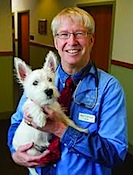 2002),
tells of a golden retriever named Dakota,
who was able to warn his master, Mike Lingenfelter,
that a heart attack was imminent and alert Mr. Lingenfelter to the
need to leave a stressful situation and take preventive medication.
“This dog is leading me through life,” Mr. Lingenfelter
told Dr. Becker. “All I’m doing is following the dog.”
2002),
tells of a golden retriever named Dakota,
who was able to warn his master, Mike Lingenfelter,
that a heart attack was imminent and alert Mr. Lingenfelter to the
need to leave a stressful situation and take preventive medication.
“This dog is leading me through life,” Mr. Lingenfelter
told Dr. Becker. “All I’m doing is following the dog.”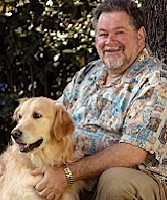 University
in Pomona, whose extensive successful use of therapy animals
in treating children is documented in “The Handbook
on Animal Assisted Therapy” (Elsevier/Academic Press, 2010).
University
in Pomona, whose extensive successful use of therapy animals
in treating children is documented in “The Handbook
on Animal Assisted Therapy” (Elsevier/Academic Press, 2010).
 misshapen
therapy animal he was playing with had been rescued from an abusive
home where it had been seriously injured.
misshapen
therapy animal he was playing with had been rescued from an abusive
home where it had been seriously injured. 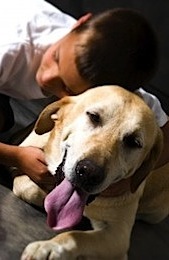 can’t
be a blind study — you know if the patient has a therapy dog.”
But he described one recent study in which the patient, a young boy
with autism, served as his own control. When he was with the therapy
dog, levels of the stress hormone cortisol in the child dropped; the
levels rose when the dog was taken away, and dropped again when the
dog was returned. The next step would be to coordinate biochemical
changes with behavioral effects — is the child calmer and easier
to handle when with a therapy animal?
can’t
be a blind study — you know if the patient has a therapy dog.”
But he described one recent study in which the patient, a young boy
with autism, served as his own control. When he was with the therapy
dog, levels of the stress hormone cortisol in the child dropped; the
levels rose when the dog was taken away, and dropped again when the
dog was returned. The next step would be to coordinate biochemical
changes with behavioral effects — is the child calmer and easier
to handle when with a therapy animal?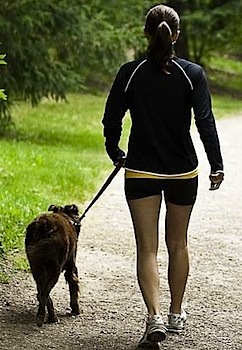 wagging
tail.
wagging
tail.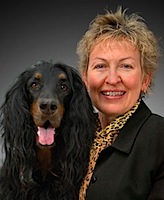 “You
need to walk, and so does your dog,” said Rebecca A.
Johnson, director of the human-animal interaction research center
at the University of Missouri College of Veterinary Medicine
(right). “It’s good for both ends of the leash.”
“You
need to walk, and so does your dog,” said Rebecca A.
Johnson, director of the human-animal interaction research center
at the University of Missouri College of Veterinary Medicine
(right). “It’s good for both ends of the leash.” about
two-thirds of dog owners took their pets for regular walks, defined
as lasting at least 10 minutes. Unlike other studies of dog ownership
and walking, this one also tracked other forms of exercise, seeking
to answer what the lead author, Dr. Mathew Reeves,
called an obvious question: whether dog walking “adds significantly
to the amount of exercise you do, or is it simply that it replaces
exercise you would have done otherwise?”
about
two-thirds of dog owners took their pets for regular walks, defined
as lasting at least 10 minutes. Unlike other studies of dog ownership
and walking, this one also tracked other forms of exercise, seeking
to answer what the lead author, Dr. Mathew Reeves,
called an obvious question: whether dog walking “adds significantly
to the amount of exercise you do, or is it simply that it replaces
exercise you would have done otherwise?” And
the question remains whether owning a dog encourages regular activity
or whether active, healthy people are simply more likely to acquire
dogs as walking companions. A 2008 study in Western Australia addressed
the question when it followed 773 adults who didn’t have dogs.
After a year, 92 people, or 12 percent of the group, had acquired
a dog. Getting a dog increased average walking by about 30 minutes
a week, compared with those who didn’t own dogs. But on closer
analysis, the new dog owners had been laggards before getting a dog,
walking about 24 percent less than other people without dogs.
And
the question remains whether owning a dog encourages regular activity
or whether active, healthy people are simply more likely to acquire
dogs as walking companions. A 2008 study in Western Australia addressed
the question when it followed 773 adults who didn’t have dogs.
After a year, 92 people, or 12 percent of the group, had acquired
a dog. Getting a dog increased average walking by about 30 minutes
a week, compared with those who didn’t own dogs. But on closer
analysis, the new dog owners had been laggards before getting a dog,
walking about 24 percent less than other people without dogs.
 convinced
there is no human problem so big she can’t lick it. Lost your
job, or bedridden for days? Lick.
Feeling depressed, incompetent, in an existential malaise? Lick.
convinced
there is no human problem so big she can’t lick it. Lost your
job, or bedridden for days? Lick.
Feeling depressed, incompetent, in an existential malaise? Lick.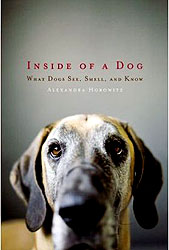



 demanding
work schedule has a way of keeping people from having pets.
demanding
work schedule has a way of keeping people from having pets. an
animal sidekick: Even if you're gone all day, you still can have a
furry friend.
an
animal sidekick: Even if you're gone all day, you still can have a
furry friend. "When it comes to the fast-track life, perhaps no other pet is
better suited to the urban lifestyle than a cat," says Ward,
who's the resident vet for the "Rachael Ray Show."
"When it comes to the fast-track life, perhaps no other pet is
better suited to the urban lifestyle than a cat," says Ward,
who's the resident vet for the "Rachael Ray Show."


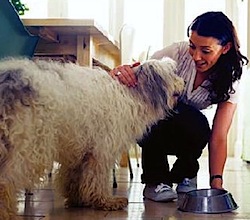 Some
important things pet parents should look for in a pet sitter:
Some
important things pet parents should look for in a pet sitter: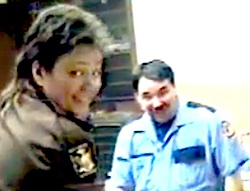
 after
developing cataracts.
after
developing cataracts.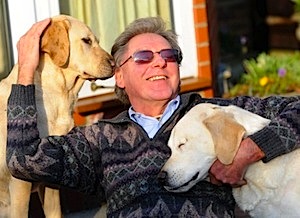
 boy
in the world.
boy
in the world.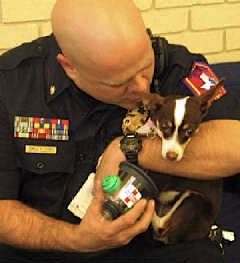 shopping
center, and for Temple Thomas (left with Zoe), district commander
of the Austin-Travis County Emergency Medical Service. Thomas,
an EMS supervisor, happened to drive right past after the accident.
He didn’t see the cars hit the dogs, but he noticed a crowd
gathered in the parking lot. He went to see the reason and discovered
a little brown pile crumpled on the ground.
shopping
center, and for Temple Thomas (left with Zoe), district commander
of the Austin-Travis County Emergency Medical Service. Thomas,
an EMS supervisor, happened to drive right past after the accident.
He didn’t see the cars hit the dogs, but he noticed a crowd
gathered in the parking lot. He went to see the reason and discovered
a little brown pile crumpled on the ground.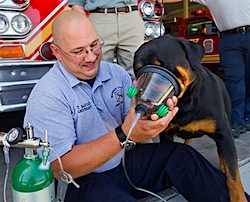 Massachusetts
Veterinary Medical Association and the Wellpet Foundation,
MacDonald said. The Boston firefighters haven’t used the masks
in the field yet, he said, but the devices are expected to improve
animals’ chance to survive a fire or an accident.
Massachusetts
Veterinary Medical Association and the Wellpet Foundation,
MacDonald said. The Boston firefighters haven’t used the masks
in the field yet, he said, but the devices are expected to improve
animals’ chance to survive a fire or an accident.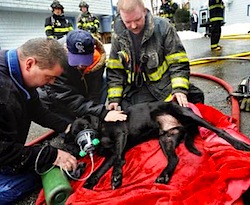 Association,
believes only about four or five state associations (Rhode
Island, Connecticut and Pennsylvania, besides Massachusetts)
are working to equip rescue workers with pet oxygen masks.
Association,
believes only about four or five state associations (Rhode
Island, Connecticut and Pennsylvania, besides Massachusetts)
are working to equip rescue workers with pet oxygen masks. their
yacht, they searched for a surefooted and able-bodied addition. With
four legs.
their
yacht, they searched for a surefooted and able-bodied addition. With
four legs.
 flesh,
animal experts say.
flesh,
animal experts say. festering
wound.
festering
wound. said.
said.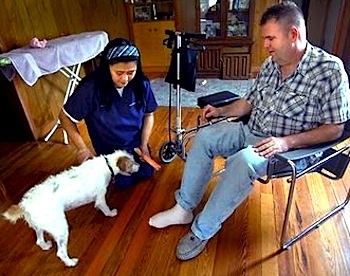 A
Michigan man says he has his dog to thank for saving his life by chewing
off his infected big toe as he lay in a drunken stupor.
A
Michigan man says he has his dog to thank for saving his life by chewing
off his infected big toe as he lay in a drunken stupor.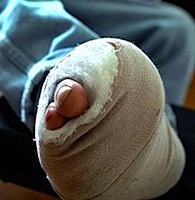 said.
said.
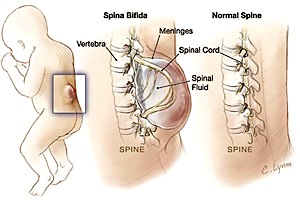
 The girl’s father told police nothing was out of the ordinary
and the girl’s foot was intact when she went to bed around 9
p.m. the night before. The family’s 2-year-old black
Labrador Retriever has always slept at the foot of the girl’s
bed.
The girl’s father told police nothing was out of the ordinary
and the girl’s foot was intact when she went to bed around 9
p.m. the night before. The family’s 2-year-old black
Labrador Retriever has always slept at the foot of the girl’s
bed.

 available
for adoption at Sniffany
& Company, a former puppy store that now holds events to
adopt out shelter dogs and puppies.
available
for adoption at Sniffany
& Company, a former puppy store that now holds events to
adopt out shelter dogs and puppies.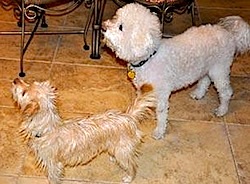 Caesar
(right), who’s the senior dog in the household at 10 years old,
has taken on the role as big brother to his new companion.
Caesar
(right), who’s the senior dog in the household at 10 years old,
has taken on the role as big brother to his new companion.
 stores.
stores.
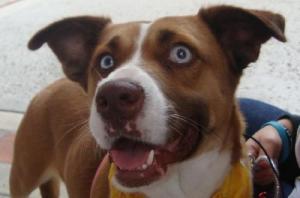

 adversaries
are facing off: animal lovers against, well, more animal lovers. Proposed
rules could ban dogs or require them on leashes in the national recreation
area, a bounty of land controlled by the National Park Service
that includes the Marin Headlands; Crissy Field, Ocean Beach
and Fort Funston in San Francisco; and Milagra Ridge and Mori Point
on the peninsula.
adversaries
are facing off: animal lovers against, well, more animal lovers. Proposed
rules could ban dogs or require them on leashes in the national recreation
area, a bounty of land controlled by the National Park Service
that includes the Marin Headlands; Crissy Field, Ocean Beach
and Fort Funston in San Francisco; and Milagra Ridge and Mori Point
on the peninsula. irrevocably,”
said Brent Plater (right), executive director
of the Wild Equity Institute, a nonprofit conservation organization
that wants dogs to be restricted. “This is really the last space
we’ve set aside,” he said of the parks. In fact, Mr. Plater
said that the current proposals did not go far enough and that dogs
should be limited to fenced-in areas in the parks.
irrevocably,”
said Brent Plater (right), executive director
of the Wild Equity Institute, a nonprofit conservation organization
that wants dogs to be restricted. “This is really the last space
we’ve set aside,” he said of the parks. In fact, Mr. Plater
said that the current proposals did not go far enough and that dogs
should be limited to fenced-in areas in the parks. reports
were almost always adopted, regardless of public opinion.
reports
were almost always adopted, regardless of public opinion. month.
month. 5-year-old
Pomeranian, named Foxy, into a nightstand
and punching it in the head.
5-year-old
Pomeranian, named Foxy, into a nightstand
and punching it in the head. to
euthanize it.
to
euthanize it. A
girl from Sulphur named the puppy Wall-e, after a Disney movie
character, and Machtiger posted Wall-e's story on her
Facebook page. She and Kloski are sorting through hundreds
of e-mails and phone calls from people wanting to adopt the lucky
dog.
A
girl from Sulphur named the puppy Wall-e, after a Disney movie
character, and Machtiger posted Wall-e's story on her
Facebook page. She and Kloski are sorting through hundreds
of e-mails and phone calls from people wanting to adopt the lucky
dog.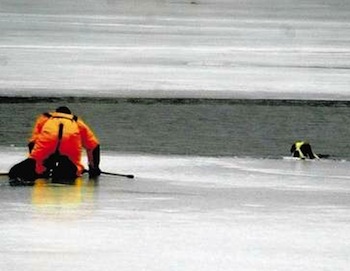 the
lake's icy waters. One dog, however, didn't make it.
the
lake's icy waters. One dog, however, didn't make it.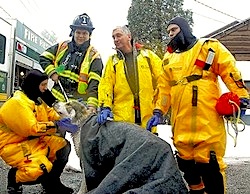 dogs.
While the larger dog survived the plunge into the frozen lake,
the smaller dog perished.
dogs.
While the larger dog survived the plunge into the frozen lake,
the smaller dog perished.
 February
21, some furious splashing drew his attention. It was dolphins.
February
21, some furious splashing drew his attention. It was dolphins. Minutes
later, Turbo was reunited with his human mom, Cindy Burnett,
who had spent many frantic hours searching for Turbo.
Minutes
later, Turbo was reunited with his human mom, Cindy Burnett,
who had spent many frantic hours searching for Turbo. “I searched and searched and called his name,” Burnett
told the TV station. “I drove through this street at least five
or six times.”
“I searched and searched and called his name,” Burnett
told the TV station. “I drove through this street at least five
or six times.”
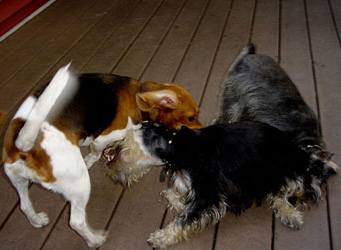 "Parker just makes everything better,"
said my pal Mere, about her Yorkie.
"Parker just makes everything better,"
said my pal Mere, about her Yorkie. most
significant legislative victory for America’s dogs—are
in serious peril. Several state-level senators and representatives
have made good on their promises to attempt to water down Prop B or
repeal it entirely.
most
significant legislative victory for America’s dogs—are
in serious peril. Several state-level senators and representatives
have made good on their promises to attempt to water down Prop B or
repeal it entirely. Yes
— Jack, Bobby and Teddy. Unnaturally handsome
for politicians, they had a look in their eyes that said, “Let’s
save the world from nuclear annihilation ... right after this game
of touch football.” From a young age I decided that if the Red
Sox wouldn’t take me, surely the Kennedys would.
Yes
— Jack, Bobby and Teddy. Unnaturally handsome
for politicians, they had a look in their eyes that said, “Let’s
save the world from nuclear annihilation ... right after this game
of touch football.” From a young age I decided that if the Red
Sox wouldn’t take me, surely the Kennedys would. and
Me.” The book depicts a day in his life from Splash’s
perspective. Someone — I’m not sure who — suggested
including an e-mail address where curious young readers could reach
the supposedly computer-savvy Splash.
and
Me.” The book depicts a day in his life from Splash’s
perspective. Someone — I’m not sure who — suggested
including an e-mail address where curious young readers could reach
the supposedly computer-savvy Splash.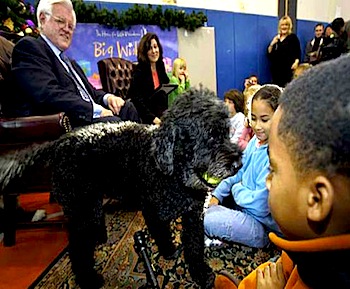 grants
for college scholarships and to ensure all children were covered by
health insurance, and fought to lower the voting age to 18.
grants
for college scholarships and to ensure all children were covered by
health insurance, and fought to lower the voting age to 18.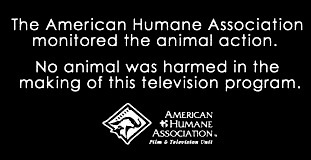
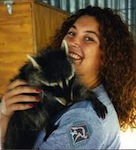 The
nonprofit's Film & TV Unit started the award
three years ago as an internal point of recognition. But the word
got out and the Pawscar took on a life of its own.
The
nonprofit's Film & TV Unit started the award
three years ago as an internal point of recognition. But the word
got out and the Pawscar took on a life of its own. Best
Villain -- "Cats & Dogs: Revenge of Kitty Galore"
Best
Villain -- "Cats & Dogs: Revenge of Kitty Galore" Best
Human-Animal Bond -- "Secretariat"
Best
Human-Animal Bond -- "Secretariat" Best
Effort to Protect an Animal -- "Shutter Island"
Best
Effort to Protect an Animal -- "Shutter Island" Best
Perception vs. Reality -- "True Grit"
Best
Perception vs. Reality -- "True Grit"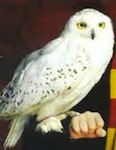 Best
Recurring Character -- "Harry Potter" Series
Best
Recurring Character -- "Harry Potter" Series

 size
pieces. Then again, not every customer has just won Best in
Show at the Westminster Kennel Club Dog Show.
size
pieces. Then again, not every customer has just won Best in
Show at the Westminster Kennel Club Dog Show. the
filet mignon, despite the ministrations of Klimavicius
(right) and her handler, Angela Lloyd.
the
filet mignon, despite the ministrations of Klimavicius
(right) and her handler, Angela Lloyd.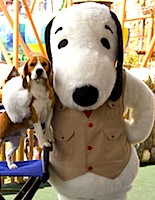 In
2008, Uno the Beagle (left) set a new standard for
Best in Show winners. He was feted at a White House Rose Garden
ceremony, fetched the first pitch at major league
baseball games and rode aboard the “Peanuts”
float in the Macy’s Thanksgiving Day Parade.
In
2008, Uno the Beagle (left) set a new standard for
Best in Show winners. He was feted at a White House Rose Garden
ceremony, fetched the first pitch at major league
baseball games and rode aboard the “Peanuts”
float in the Macy’s Thanksgiving Day Parade. More
recent Best in Show winners have not kept pace. Stump, the
10-year-old Sussex Spaniel (right) who won Best in
Show in 2009, continued his dotage at the
home of his handler in Houston. Sadie, the Scottish terrier who won
last year, made appearances at the Macy’s Flower Show and a
few other events before retiring to give birth to a litter of puppies,
said David Frei, the kennel club’s director of communications.
“It was time for her to go do something else,” he said.
More
recent Best in Show winners have not kept pace. Stump, the
10-year-old Sussex Spaniel (right) who won Best in
Show in 2009, continued his dotage at the
home of his handler in Houston. Sadie, the Scottish terrier who won
last year, made appearances at the Macy’s Flower Show and a
few other events before retiring to give birth to a litter of puppies,
said David Frei, the kennel club’s director of communications.
“It was time for her to go do something else,” he said. Frei
said the expectations for a Best in Show winner were highly dependent
upon the breed. “You want to see a dog that is enjoying itself
and exuberant, but that isn’t correct for every breed,”
he said. “This is what a Scottish deerhound is supposed to be
like — laid-back, intense when it comes to doing its job, coursing
down antlered game in this case.”
Frei
said the expectations for a Best in Show winner were highly dependent
upon the breed. “You want to see a dog that is enjoying itself
and exuberant, but that isn’t correct for every breed,”
he said. “This is what a Scottish deerhound is supposed to be
like — laid-back, intense when it comes to doing its job, coursing
down antlered game in this case.”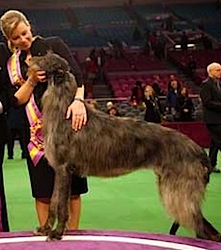 he
was pretty unique.”
he
was pretty unique.” three
full months. But recovering wasn’t just a physical challenge
for the then-65-year-old interior decorator. It was a psychological
one as well. “I was extremely fearful,” she recalls. “When
I went out on the street, it was very scary. I’d think, ‘I’m
going to get flattened again!’ ”
three
full months. But recovering wasn’t just a physical challenge
for the then-65-year-old interior decorator. It was a psychological
one as well. “I was extremely fearful,” she recalls. “When
I went out on the street, it was very scary. I’d think, ‘I’m
going to get flattened again!’ ” “People are realizing how helpful dogs can be,” says Stacy
Alldredge (right), who trained Izzy. Alldredge is the founder
and owner of Who’s Walking Who, the city’s
sole provider of training and certification for the growing group
of emotional support dogs.
“People are realizing how helpful dogs can be,” says Stacy
Alldredge (right), who trained Izzy. Alldredge is the founder
and owner of Who’s Walking Who, the city’s
sole provider of training and certification for the growing group
of emotional support dogs.
 and
cats to death in the presence of six young daughters in a home that
her son described as “a concentration camp for the animals.”
and
cats to death in the presence of six young daughters in a home that
her son described as “a concentration camp for the animals.” trial.
“She knows there’s no excuse,” Brocato said. “I
can’t imagine she’s not going to be a welcome sight in
the community when she gets out.”
trial.
“She knows there’s no excuse,” Brocato said. “I
can’t imagine she’s not going to be a welcome sight in
the community when she gets out.”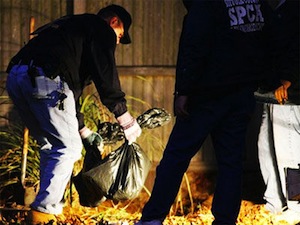 McDonough
killed numerous kittens and dogs, stashing the dead cats in the trash,
and burying 42 dead dogs in the backyard of her home in Selden, prosecutors
said. The dogs were buried because some had identifying microchips
implanted in them and McDonough feared being discovered if the carcasses
were found in the trash, they said.
McDonough
killed numerous kittens and dogs, stashing the dead cats in the trash,
and burying 42 dead dogs in the backyard of her home in Selden, prosecutors
said. The dogs were buried because some had identifying microchips
implanted in them and McDonough feared being discovered if the carcasses
were found in the trash, they said. one
point, he brought his sisters frozen TV dinners but later learned
that his mother had confiscated the food. He described the home as
“a concentration camp for the animals.”
one
point, he brought his sisters frozen TV dinners but later learned
that his mother had confiscated the food. He described the home as
“a concentration camp for the animals.”
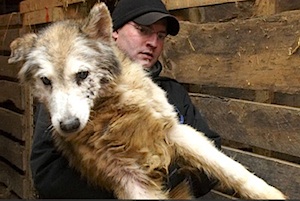
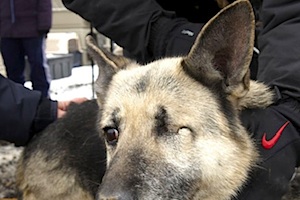
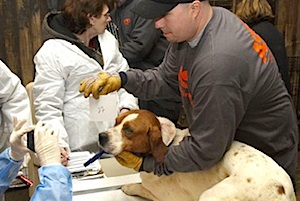
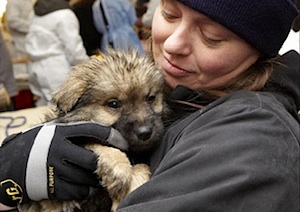

 draw
more human customers to a tourist town just begging for business.
draw
more human customers to a tourist town just begging for business. a
broader customer base. Atlantic City's casino industry has launched
an array of marketing programs — ranging from Pet Stay to food
festivals to gay-friendly events — to attract new business in
the sluggish economy.
a
broader customer base. Atlantic City's casino industry has launched
an array of marketing programs — ranging from Pet Stay to food
festivals to gay-friendly events — to attract new business in
the sluggish economy.
 exclusive
Paris establishment the difference is the guests: they have four legs,
and enthusiastically wagging tails.
exclusive
Paris establishment the difference is the guests: they have four legs,
and enthusiastically wagging tails.
 Clifford,
an English bulldog, Cocker Spaniel puppy Floyd, Golden Retriever Cleo
and miniature Schnauzer Belle (pictured above) bounded around
the hotel's games room, equipped with a treadmill for training.
Clifford,
an English bulldog, Cocker Spaniel puppy Floyd, Golden Retriever Cleo
and miniature Schnauzer Belle (pictured above) bounded around
the hotel's games room, equipped with a treadmill for training. word
out.”
word
out.”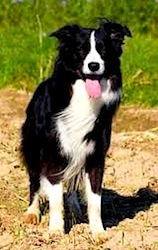 that
something was wrong. Her 10-year-old Border Collie, Twiggy,
wasn’t waiting to greet her like she always did. The Masem
family posted signs around the neighborhood and checked local shelters.
As a storm moved in that night, they started to despair.
that
something was wrong. Her 10-year-old Border Collie, Twiggy,
wasn’t waiting to greet her like she always did. The Masem
family posted signs around the neighborhood and checked local shelters.
As a storm moved in that night, they started to despair. “She’s terrified of thunderstorms,” says Masem.
“We were frantic!”
“She’s terrified of thunderstorms,” says Masem.
“We were frantic!” Eventually, a woman living on that street phoned, saying she had
seen Masem’s flier. Turns out that Twiggy had followed her
kids home and safely slept in her daughter’s bed overnight.
Eventually, a woman living on that street phoned, saying she had
seen Masem’s flier. Turns out that Twiggy had followed her
kids home and safely slept in her daughter’s bed overnight.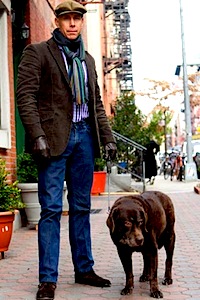
 Upper
West Side resident Sean Cassidy (left) didn’t
bother yelling his dog’s name in the streets when Sam,
a 14-year-old chocolate Lab, went missing during a Thanksgiving
weekend party in Sag Harbor this past fall. “Sam’s
a senior dog and is deaf, so calling him is not a big help,”
says Cassidy, who owns the Manhattan menswear boutique Sean. “I
freaked out.” He feared the deaf dog had been hit by a car.
Upper
West Side resident Sean Cassidy (left) didn’t
bother yelling his dog’s name in the streets when Sam,
a 14-year-old chocolate Lab, went missing during a Thanksgiving
weekend party in Sag Harbor this past fall. “Sam’s
a senior dog and is deaf, so calling him is not a big help,”
says Cassidy, who owns the Manhattan menswear boutique Sean. “I
freaked out.” He feared the deaf dog had been hit by a car. profile
was ready to go.
profile
was ready to go.
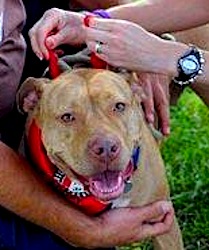 area.
area.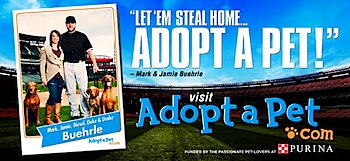 Because
of her sweet and goofy disposition, Dolly became a poster-dog for
the Court Case Dog program, appearing with Chicago White
Sox pitcher Mark Buerhle and his wife Jamie in a public
service announcement promoting the program. The PSA, in which Dolly
sits with the couple in the U.S. Cellular Field,
appeared during one of the White Sox games last
season.
Because
of her sweet and goofy disposition, Dolly became a poster-dog for
the Court Case Dog program, appearing with Chicago White
Sox pitcher Mark Buerhle and his wife Jamie in a public
service announcement promoting the program. The PSA, in which Dolly
sits with the couple in the U.S. Cellular Field,
appeared during one of the White Sox games last
season.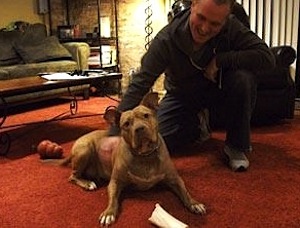 Dolly
and help her maintain her good behavior. Tim works in Chicago as
a project manager for a power company. Tim’s previous dog
had, just the month before, passed away, and he wasn’t planning
on adopting anytime soon.
Dolly
and help her maintain her good behavior. Tim works in Chicago as
a project manager for a power company. Tim’s previous dog
had, just the month before, passed away, and he wasn’t planning
on adopting anytime soon.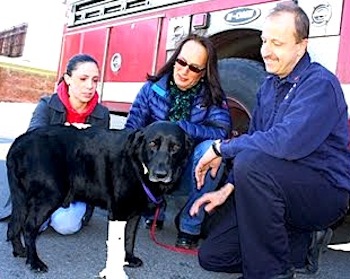 to
chase birds and fell through ice, according to Brian Adams,
spokesman for Boston’s MSPCA-Angell.
to
chase birds and fell through ice, according to Brian Adams,
spokesman for Boston’s MSPCA-Angell. performer.
“But unlike our Shpilkes, who is anxious and standoffish,
this one was incredibly friendly. When we came to visit the apartment,
he’d invite us in and practically show us around.”
performer.
“But unlike our Shpilkes, who is anxious and standoffish,
this one was incredibly friendly. When we came to visit the apartment,
he’d invite us in and practically show us around.”
 Yet
some brokers insist that the presence of a winsome pet can actually
help seal the deal. This is one reason Barry Silverman,
a Halstead broker, frequently includes his own
Jack Russell Terrier, Sammy, in
photographs of pet-friendly apartments that accompany his listings.
“People remember the place better in putting their lists together,”
Mr. Silverman said. “They’ll ask for ‘the one
with the Jack Russell on the stairs.’ ”
Yet
some brokers insist that the presence of a winsome pet can actually
help seal the deal. This is one reason Barry Silverman,
a Halstead broker, frequently includes his own
Jack Russell Terrier, Sammy, in
photographs of pet-friendly apartments that accompany his listings.
“People remember the place better in putting their lists together,”
Mr. Silverman said. “They’ll ask for ‘the one
with the Jack Russell on the stairs.’ ” being
offered for $749,000, that went on the market this month. Karen
Heller, the Halstead broker handling the
sale, arranged for the owner’s 11-month-old Miniature
Schnauzer, Mookie, to attend
being
offered for $749,000, that went on the market this month. Karen
Heller, the Halstead broker handling the
sale, arranged for the owner’s 11-month-old Miniature
Schnauzer, Mookie, to attend  the
first open house, held on Feb. 13. “She is friendly, well
behaved, cute and a puppy,” Ms. Heller said. “I’m
hoping she’ll be a wonderful sales associate.”
the
first open house, held on Feb. 13. “She is friendly, well
behaved, cute and a puppy,” Ms. Heller said. “I’m
hoping she’ll be a wonderful sales associate.” Venetian
plastered walls, crown molding and hand-stenciled wood floors. During
open houses and showings, the housekeeper took Wraggles on walks
through Central Park. But one day the housekeeper was late.
Venetian
plastered walls, crown molding and hand-stenciled wood floors. During
open houses and showings, the housekeeper took Wraggles on walks
through Central Park. But one day the housekeeper was late. magic
in a two-bedroom co-op in Tudor City. The apartment,
created by combining a studio and a one-bedroom, was in mint condition.
But that was not the only attraction. According to June
Iseman, the Stribling broker handling
the sale, every visitor fell in love with Elbow.
magic
in a two-bedroom co-op in Tudor City. The apartment,
created by combining a studio and a one-bedroom, was in mint condition.
But that was not the only attraction. According to June
Iseman, the Stribling broker handling
the sale, every visitor fell in love with Elbow.
 And
Ms. Muir was not surprised at the interest in Henry and his means
of egress. “New Yorkers are so cat-crazed,” she said.
And
Ms. Muir was not surprised at the interest in Henry and his means
of egress. “New Yorkers are so cat-crazed,” she said.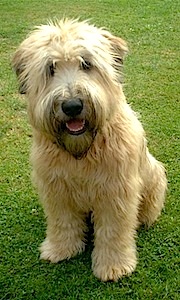 Annandale
have stood, waved and received polite applause at the annual meeting
in June. Everyone votes, eats ice cream, chats with neighbors and
goes home.
Annandale
have stood, waved and received polite applause at the annual meeting
in June. Everyone votes, eats ice cream, chats with neighbors and
goes home.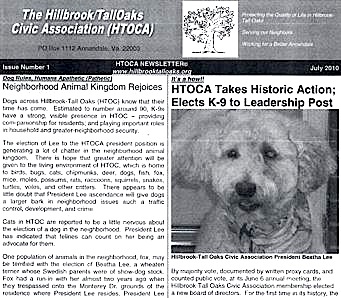 appeared
under the heading, "Dog Rules, Humans Apathetic (Pathetic)."
appeared
under the heading, "Dog Rules, Humans Apathetic (Pathetic)."





 Alison
and Hannah (pictured left and right) invited 1010
WINS’ John Montone (right) to join in on the meal
[an offer he politely refused].
Alison
and Hannah (pictured left and right) invited 1010
WINS’ John Montone (right) to join in on the meal
[an offer he politely refused]. antibiotic
and hormone-free meats and no by-products, fillers, corn, soy, wheat,
antibiotic
and hormone-free meats and no by-products, fillers, corn, soy, wheat,
 potatoes,
or salt.
potatoes,
or salt. County,
Ore., on Feb. 9 when he saw Sgt. John Terrel's
cruiser flashing its lights in his rear-view mirror.
County,
Ore., on Feb. 9 when he saw Sgt. John Terrel's
cruiser flashing its lights in his rear-view mirror.

 solid
and steady and even through all of the lights and cameras and the
noise and spotlights, she came right through it.”
solid
and steady and even through all of the lights and cameras and the
noise and spotlights, she came right through it.”
 Paolo
Dondina, the Best in Show judge (right), said the
competition was stiff, but ultimately he settled on Hickory.
Paolo
Dondina, the Best in Show judge (right), said the
competition was stiff, but ultimately he settled on Hickory.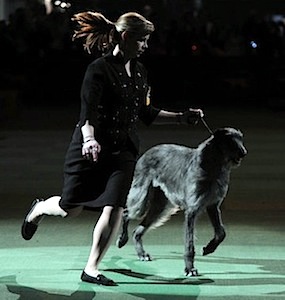 she
said. “You could be sitting watching TV and she’ll come
up and nudge you, and when I mean nudge you, I mean really throw
your arm up in the air. You better not be holding something to drink.”
she
said. “You could be sitting watching TV and she’ll come
up and nudge you, and when I mean nudge you, I mean really throw
your arm up in the air. You better not be holding something to drink.”




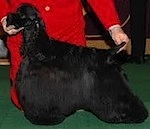

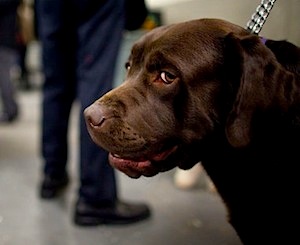 owners
and handlers furiously prepare their canine divas for the ring. Hair
is blown straight or teased into fanciful poufs. Snouts and paws are
daubed with talcum powder. Wayward hairs and whiskers are trimmed with
precision.
owners
and handlers furiously prepare their canine divas for the ring. Hair
is blown straight or teased into fanciful poufs. Snouts and paws are
daubed with talcum powder. Wayward hairs and whiskers are trimmed with
precision. statistics.
And yet, when set against a Westminster backdrop of elegant Afghans,
jaded Poodles, lumbering St. Bernards and
impertinent Pomeranians, the humble Labrador retriever can get lost
in the crowd. So perhaps it is not surprising that the Labrador retriever
has never won Best in Show in Westminster’s 135
years. Other breeds better known as pets have also been overlooked.
The Golden Retriever has never won, either, and the
German Shepherd and the Pug have only
won once apiece. In 2008, Uno the beagle became a household name after
he was the first of his breed to win the top prize.
statistics.
And yet, when set against a Westminster backdrop of elegant Afghans,
jaded Poodles, lumbering St. Bernards and
impertinent Pomeranians, the humble Labrador retriever can get lost
in the crowd. So perhaps it is not surprising that the Labrador retriever
has never won Best in Show in Westminster’s 135
years. Other breeds better known as pets have also been overlooked.
The Golden Retriever has never won, either, and the
German Shepherd and the Pug have only
won once apiece. In 2008, Uno the beagle became a household name after
he was the first of his breed to win the top prize. The
Aztecs ate them. Frida Kahlo enshrined them in her art. So did Diego
Rivera, who in a celebrated mural in Mexico City painted
one baring its teeth at the invading Spaniards (?)
as they landed at Veracruz. Dolores Olmedo,
a Mexican businesswoman and Kahlo’s rival for Rivera’s affections
(and never a woman to be outdone) ditched the boring Cocker
Spaniels she once favored in order to trump Kahlo by breeding
so many of the strange native dogs called Xoloitzcuintli
(SHOW-low-eats-QUEENT-lee) that she eventually assembled a
mighty pack.
The
Aztecs ate them. Frida Kahlo enshrined them in her art. So did Diego
Rivera, who in a celebrated mural in Mexico City painted
one baring its teeth at the invading Spaniards (?)
as they landed at Veracruz. Dolores Olmedo,
a Mexican businesswoman and Kahlo’s rival for Rivera’s affections
(and never a woman to be outdone) ditched the boring Cocker
Spaniels she once favored in order to trump Kahlo by breeding
so many of the strange native dogs called Xoloitzcuintli
(SHOW-low-eats-QUEENT-lee) that she eventually assembled a
mighty pack. Even
the most ardent admirers of the Xolo concede that the dog is plug-ugly.
One description of this hairless canine of ancient lineage, a national
treasure in its native Mexico, characterizes the Xolo as a hot water
bottle with pig eyes, bat ears and a rat tail.
Even
the most ardent admirers of the Xolo concede that the dog is plug-ugly.
One description of this hairless canine of ancient lineage, a national
treasure in its native Mexico, characterizes the Xolo as a hot water
bottle with pig eyes, bat ears and a rat tail. That
is being polite.
That
is being polite. What
makes the Xolo’s official recognition noteworthy is the breed’s
unexpected redemption. The A.K.C. erased
the breed from its stud book 50 years ago when interest in this once-popular
dog faded and the Xoloitzcuintli,
also known as the Mexican hairless, all but disappeared.
What
makes the Xolo’s official recognition noteworthy is the breed’s
unexpected redemption. The A.K.C. erased
the breed from its stud book 50 years ago when interest in this once-popular
dog faded and the Xoloitzcuintli,
also known as the Mexican hairless, all but disappeared.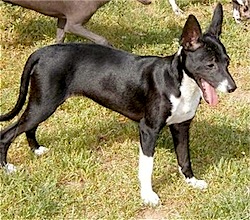 later
interest in the Xoloitzcuintli was so scant that the A.K.C. was forced
to drop the dog from its stud book, seemingly forever. Yet they’re
back now, with a worldwide population of approximately 30,000 and newly
formed fan and breed clubs in France, Germany, Sweden, Finland, Slovakia,
Ukraine and Peru.
later
interest in the Xoloitzcuintli was so scant that the A.K.C. was forced
to drop the dog from its stud book, seemingly forever. Yet they’re
back now, with a worldwide population of approximately 30,000 and newly
formed fan and breed clubs in France, Germany, Sweden, Finland, Slovakia,
Ukraine and Peru. Mottled,
livid, freckly, baggy and with an eternally suspicious squint, Xolos
don’t just look different from most other purebred dogs; they
are inherently
Mottled,
livid, freckly, baggy and with an eternally suspicious squint, Xolos
don’t just look different from most other purebred dogs; they
are inherently  different,
their owners say. Unlike many pets bred to favor docility and anthropomorphic
attributes — squashed, childlike faces; pendant ears that resemble
human locks — the Xolo is an authentic rarity, a spontaneous genetic
mutation evolved according to the laws of natural selection, mainly
in the wild.
different,
their owners say. Unlike many pets bred to favor docility and anthropomorphic
attributes — squashed, childlike faces; pendant ears that resemble
human locks — the Xolo is an authentic rarity, a spontaneous genetic
mutation evolved according to the laws of natural selection, mainly
in the wild. Historians
citing depictions of the dogs in art have variously traced the origins
of the breed — which can range in size considerably, from 10 to
50 pounds — to the Aztec, Maya and Toltec civilizations.
“There are still breeders in Mexico who make the journey into
the Colima jungle (See Colima carving, left) to get
dogs from the Indians to add to their breed lines,” Ms. Lawson
said.
Historians
citing depictions of the dogs in art have variously traced the origins
of the breed — which can range in size considerably, from 10 to
50 pounds — to the Aztec, Maya and Toltec civilizations.
“There are still breeders in Mexico who make the journey into
the Colima jungle (See Colima carving, left) to get
dogs from the Indians to add to their breed lines,” Ms. Lawson
said. “It’s
a primitive breed,” Ms. Fernandez (right with
Chinese Cresteds) said. “I had always had Chinese Cresteds,”
she added, referring to another bald canine of uncertain origin. “And,
aside from the fact that both are hairless, they have absolutely nothing
in common.” Where the Chinese Crested is typically meek and dependent,
the Xolo is strong-willed, she said, predatory and governed by instinctive
drives. “People may think they’re getting a little toy-type
pet, but what they don’t consider is that a Xolo will chase and
it will catch,” she said. “If a Xolo thinks its owner is
being threatened, it will bite. When you decide you don’t want
it anymore, you can’t just hand it off to a neighbor who wants
a poodle or a Lab.”
“It’s
a primitive breed,” Ms. Fernandez (right with
Chinese Cresteds) said. “I had always had Chinese Cresteds,”
she added, referring to another bald canine of uncertain origin. “And,
aside from the fact that both are hairless, they have absolutely nothing
in common.” Where the Chinese Crested is typically meek and dependent,
the Xolo is strong-willed, she said, predatory and governed by instinctive
drives. “People may think they’re getting a little toy-type
pet, but what they don’t consider is that a Xolo will chase and
it will catch,” she said. “If a Xolo thinks its owner is
being threatened, it will bite. When you decide you don’t want
it anymore, you can’t just hand it off to a neighbor who wants
a poodle or a Lab.”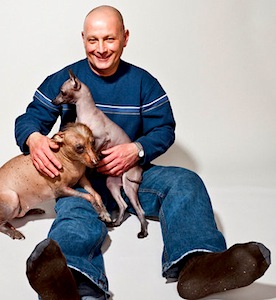 shows
Xolos and bald felines and who himself happens to have little in the
way of hair. “I showed Afghan hounds, too,” before Xolos,
Mr. Patalano added, referring to the notoriously high-maintenance silken-haired
dogs. “I wanted something that was a little more easy-care.”
shows
Xolos and bald felines and who himself happens to have little in the
way of hair. “I showed Afghan hounds, too,” before Xolos,
Mr. Patalano added, referring to the notoriously high-maintenance silken-haired
dogs. “I wanted something that was a little more easy-care.”


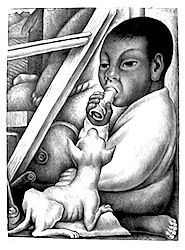
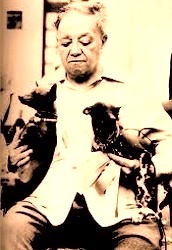







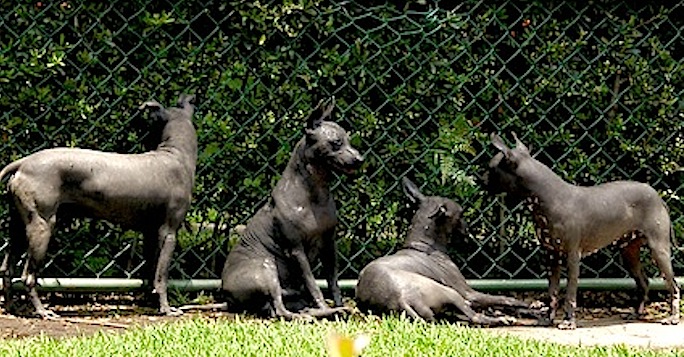 XOLOITZCUINTLIS
AT THE DOLORES OLMEDO PATIÑO MUSEUM IN MEXICO CITY
XOLOITZCUINTLIS
AT THE DOLORES OLMEDO PATIÑO MUSEUM IN MEXICO CITY
 Anubis
Anubis it
big at the 135-year-old competition.
it
big at the 135-year-old competition.
 Terrier,
Australian Shepherd and Bloodhound made the
cut.
Terrier,
Australian Shepherd and Bloodhound made the
cut.


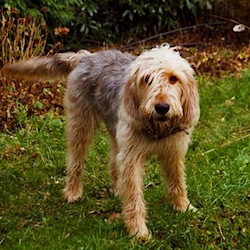 owner,
Cathy Glenn, felt sure he would win best in breed —
and not just because he had won the prize three years running. The crowd
was equally certain of his chances for victory: although five dogs had
been entered in the show, Baxter was the only one who showed up.
owner,
Cathy Glenn, felt sure he would win best in breed —
and not just because he had won the prize three years running. The crowd
was equally certain of his chances for victory: although five dogs had
been entered in the show, Baxter was the only one who showed up.
 If
these heirloom breeds have a hero, it is Stump, the 10-year-old
Sussex Spaniel who won Best in Show at Westminster in 2009 (left).
The Sussex spaniel was one of nine breeds originally recognized by the
American Kennel Club in 1884, but they are an unusual sight
today, ranking 155th in annual registrations out of the kennel club’s
167 ranked breeds.
If
these heirloom breeds have a hero, it is Stump, the 10-year-old
Sussex Spaniel who won Best in Show at Westminster in 2009 (left).
The Sussex spaniel was one of nine breeds originally recognized by the
American Kennel Club in 1884, but they are an unusual sight
today, ranking 155th in annual registrations out of the kennel club’s
167 ranked breeds. Last
fall, the British clothing designer Jeremy Hackett
warned in a newspaper article that his beloved Sussex Spaniels —
which are featured in many of his clothing advertisements — have
a popularity that is “on a par with whalebone corsets and powdered
eggs.”
Last
fall, the British clothing designer Jeremy Hackett
warned in a newspaper article that his beloved Sussex Spaniels —
which are featured in many of his clothing advertisements — have
a popularity that is “on a par with whalebone corsets and powdered
eggs.” breeder
from Boston, said people often stop her on the street when
she is with her dogs, which are often confused for Cocker or Springer
Spaniels. “They say, ‘I had one of those when I was little,’
” Dooley said. “I’m like, no, you didn’t.”
breeder
from Boston, said people often stop her on the street when
she is with her dogs, which are often confused for Cocker or Springer
Spaniels. “They say, ‘I had one of those when I was little,’
” Dooley said. “I’m like, no, you didn’t.”
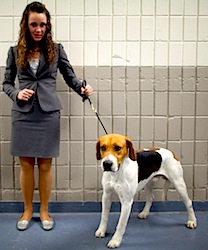 The Harriers’ métier — chasing hares
— was also outlawed several years ago, leading to concerns that
they will eventually disappear in England, where the dogs are kept exclusively
in hunting packs. Harriers in the United States are third-to-last in
the A.K.C.’s popularity list and are mostly kept as pets. Less
than 100 are believed to be living in the United States.
The Harriers’ métier — chasing hares
— was also outlawed several years ago, leading to concerns that
they will eventually disappear in England, where the dogs are kept exclusively
in hunting packs. Harriers in the United States are third-to-last in
the A.K.C.’s popularity list and are mostly kept as pets. Less
than 100 are believed to be living in the United States.
 A
trio of dogs -- a Brittany Spaniel, an Irish
Red and White Setter and a Gordon Setter --
all owned by war hero Brig. Gen. Rhonda Cornum will
be on the march at Westminster today.
A
trio of dogs -- a Brittany Spaniel, an Irish
Red and White Setter and a Gordon Setter --
all owned by war hero Brig. Gen. Rhonda Cornum will
be on the march at Westminster today.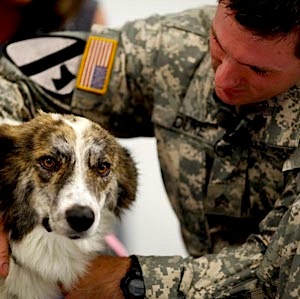 down,
by himself, and deliberately and quietly contemplated the moment, exactly
one year ago, when he almost died.
down,
by himself, and deliberately and quietly contemplated the moment, exactly
one year ago, when he almost died. Jay
Kopelman, 51, who served in two tours in Iraq and recently
retired as a lieutenant colonel in the Marine Corps. "I wouldn't
call my dog a hero, though," said Kopelman, who is averse to sentimentality.
"I'd call him a pain in the ass." Today they are happily living
together in Southern California, with Kopelman's wife and family.
Jay
Kopelman, 51, who served in two tours in Iraq and recently
retired as a lieutenant colonel in the Marine Corps. "I wouldn't
call my dog a hero, though," said Kopelman, who is averse to sentimentality.
"I'd call him a pain in the ass." Today they are happily living
together in Southern California, with Kopelman's wife and family.
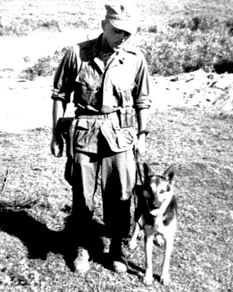 "I
was a Marine scout dog handler in Vietnam,"
said Ron Aiello, who runs the
Web site USWarDogs.org. He served with Stormy, a German
Shepherd, in 1966-67. Aiello grew so attached that he tried to extend
his tour of duty -- as did many other handlers -- instead of going home.
He was denied, and spent years trying to learn what happened to
Stormy.
"I
was a Marine scout dog handler in Vietnam,"
said Ron Aiello, who runs the
Web site USWarDogs.org. He served with Stormy, a German
Shepherd, in 1966-67. Aiello grew so attached that he tried to extend
his tour of duty -- as did many other handlers -- instead of going home.
He was denied, and spent years trying to learn what happened to
Stormy.

 shelter.
shelter.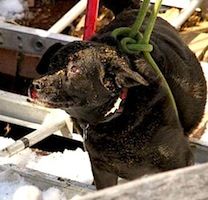 named
Hopie out of a collapsed cesspool in the backyard
of a house on North Seventh Street.|
named
Hopie out of a collapsed cesspool in the backyard
of a house on North Seventh Street.|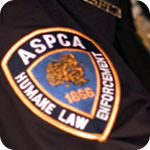 control
officers.
control
officers. The
law in San Francisco is clear: you must clean up after your dog.
But now the city has punished a woman for not picking up the waste
of a stranger’s dog — a pet she had never met.
The
law in San Francisco is clear: you must clean up after your dog.
But now the city has punished a woman for not picking up the waste
of a stranger’s dog — a pet she had never met. There
are no dogs in Diane Archer’s apartment building
at 18th and
There
are no dogs in Diane Archer’s apartment building
at 18th and 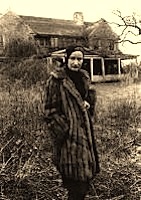 Guerrero
Streets, but several weeks ago dozens of piles of animal
waste were discovered on the property’s flat pebble and tar
roof.
Guerrero
Streets, but several weeks ago dozens of piles of animal
waste were discovered on the property’s flat pebble and tar
roof.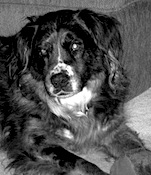 But
it took only a matter of minutes — by leaving a note at the
neighboring building — for The Bay Citizen
to find the responsible dog. Her name is Jane, a 50-pound,
shepherd mix with long black hair — a rescue dog sometimes
cared for by Howie Correa, a tenant of the neighboring
building.
But
it took only a matter of minutes — by leaving a note at the
neighboring building — for The Bay Citizen
to find the responsible dog. Her name is Jane, a 50-pound,
shepherd mix with long black hair — a rescue dog sometimes
cared for by Howie Correa, a tenant of the neighboring
building. “It
might not seem fair, but someone has to clean it up,” Ms. Shields
said. “They think the health department is going to come out
and clean dog poop?”
“It
might not seem fair, but someone has to clean it up,” Ms. Shields
said. “They think the health department is going to come out
and clean dog poop?”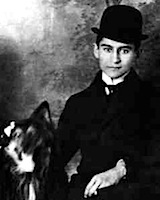 finding
a farm for the dog so she could get out of the city and have a better
life.
finding
a farm for the dog so she could get out of the city and have a better
life. because
they can no longer afford to feed them.
because
they can no longer afford to feed them. Submitted by Kathy and Chris Millich
Submitted by Kathy and Chris Millich

 pooches
are off the hook on bogus failure-to-vaccinate charges.
pooches
are off the hook on bogus failure-to-vaccinate charges.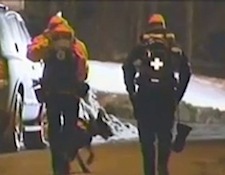
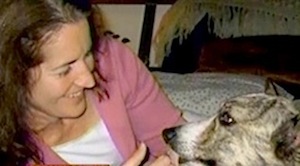 the
search ended Tuesday night and not the way anyone had hoped.
the
search ended Tuesday night and not the way anyone had hoped. “We
found her car not too far from where we’re standing. And we
started a search at that time for her,” Clarkstown Police
Capt. Robert Mahon (right) said. Choppers, all terrain vehicles,
and searchers with dogson foot trekked through the park and all its
trails.
“We
found her car not too far from where we’re standing. And we
started a search at that time for her,” Clarkstown Police
Capt. Robert Mahon (right) said. Choppers, all terrain vehicles,
and searchers with dogson foot trekked through the park and all its
trails. Avid
hikers told even the most experienced hikers should not take on Rockland
Lake State Park’s trails alone, especially under snow and ice
conditions. “There’s a mirage in a way where the rocks
can appear to be different,” hiker Jaymee Minner
(left) said. “You place a misstep you can fall and there’s
ditches
Avid
hikers told even the most experienced hikers should not take on Rockland
Lake State Park’s trails alone, especially under snow and ice
conditions. “There’s a mirage in a way where the rocks
can appear to be different,” hiker Jaymee Minner
(left) said. “You place a misstep you can fall and there’s
ditches  and
stuff up there that even for an avid hiker I wouldn’t try to
hike alone or do anything without a cell phone or backup or any sort
of guidance.”
and
stuff up there that even for an avid hiker I wouldn’t try to
hike alone or do anything without a cell phone or backup or any sort
of guidance.” By
DAVID K. LI
By
DAVID K. LI protest
the slaughter of 100 sled dogs by Outdoor Adventures Whistler.
protest
the slaughter of 100 sled dogs by Outdoor Adventures Whistler. for
what organizer Catherine Barr (left) called the
world's "first social media doggie tweet-up."
for
what organizer Catherine Barr (left) called the
world's "first social media doggie tweet-up." "What
happened in Whistler was a disgrace," said Cherilyne
Olson, of Bowen Island (right). "The laws are antiquated,
outdated and woefully inadequate when it comes to protecting animals.
And it's long past time for a change. I think what happened in Whistler
will be a tipping point and hopefully our governments will step up
and do the right thing."
"What
happened in Whistler was a disgrace," said Cherilyne
Olson, of Bowen Island (right). "The laws are antiquated,
outdated and woefully inadequate when it comes to protecting animals.
And it's long past time for a change. I think what happened in Whistler
will be a tipping point and hopefully our governments will step up
and do the right thing."



 and
nobody knew where she was for hours.
and
nobody knew where she was for hours. sank
in the Hudson River - taking the dog to a watery grave.
sank
in the Hudson River - taking the dog to a watery grave.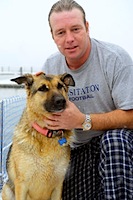
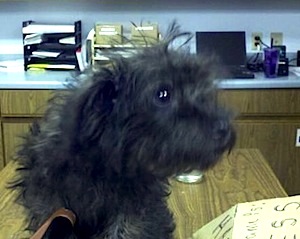 heavy
panting.
heavy
panting.
 The
woman, Stacey Champion (left), declined to tell police
why she decided to mail the puppy, Dodge said. Champion paid $22 to
send the black poodle-Schnauzer mix puppy named Guess
to Georgia via priority mail, said Thompson Ojoyeyi (right),
supervisor at the Loring Station post office. The worker who
accepted the package asked all the standard questions: Any perishables,
liquids, hazardous materials?
The
woman, Stacey Champion (left), declined to tell police
why she decided to mail the puppy, Dodge said. Champion paid $22 to
send the black poodle-Schnauzer mix puppy named Guess
to Georgia via priority mail, said Thompson Ojoyeyi (right),
supervisor at the Loring Station post office. The worker who
accepted the package asked all the standard questions: Any perishables,
liquids, hazardous materials?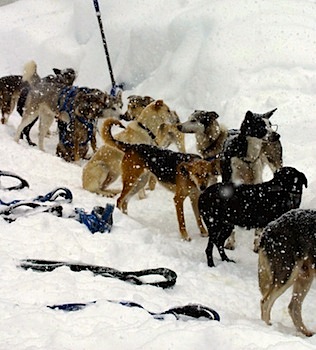 by
a tourism operator were slaughtered. The allegations are contained
in a filing to WorkSafeBC, the provincial workers'
compensation board.
by
a tourism operator were slaughtered. The allegations are contained
in a filing to WorkSafeBC, the provincial workers'
compensation board.
 company
had so many dogs when it couldn't keep them healthy. She said the
dogs appear to have died a horrible death.
company
had so many dogs when it couldn't keep them healthy. She said the
dogs appear to have died a horrible death.
 were
the skiing and sliding events. But tourists looking for something
different could also book dog sled rides pulled by teams of “energetic
and lovable Alaskan racing huskies.”
were
the skiing and sliding events. But tourists looking for something
different could also book dog sled rides pulled by teams of “energetic
and lovable Alaskan racing huskies.”
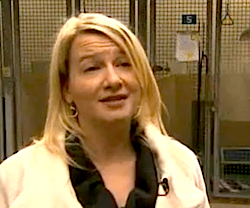 “I
see a lot of unpleasant things in my job,” said Marcie
Moriarty (left), the general manager of cruelty investigations
at the British Columbia Society for the Prevention
of Cruelty to Animals, which is leading the investigation.
“But I had to put this document down a few times before
I could get through the whole thing. It’s a horror story.”
“I
see a lot of unpleasant things in my job,” said Marcie
Moriarty (left), the general manager of cruelty investigations
at the British Columbia Society for the Prevention
of Cruelty to Animals, which is leading the investigation.
“But I had to put this document down a few times before
I could get through the whole thing. It’s a horror story.”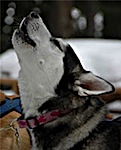 The report is a review of an earlier decision denying compensation
to the employee, who is not identified. The Workplace
Compensation Board of British Columbia,
citing privacy laws, would not give information about the worker or
his settlement.
The report is a review of an earlier decision denying compensation
to the employee, who is not identified. The Workplace
Compensation Board of British Columbia,
citing privacy laws, would not give information about the worker or
his settlement.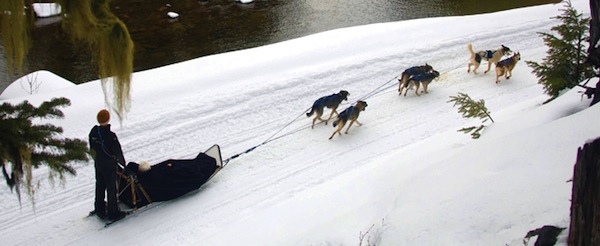
 Ms. Moriarty speculated that without the Olympic tourists, Howling
Dogs found that it could not afford to carry 300 animals. Graham
Aldcroft, (right) the director of operations
for Outdoor Adventures , denied
that was the case in an e-mail, but he did not offer another explanation.
Ms. Moriarty speculated that without the Olympic tourists, Howling
Dogs found that it could not afford to carry 300 animals. Graham
Aldcroft, (right) the director of operations
for Outdoor Adventures , denied
that was the case in an e-mail, but he did not offer another explanation. Attempts
to find them other homes were unsuccessful. Ms. Moriarty said that
because sled dogs usually spend their entire lives outdoors, primarily
in the company of other animals, they “are not highly adoptable.”
Attempts
to find them other homes were unsuccessful. Ms. Moriarty said that
because sled dogs usually spend their entire lives outdoors, primarily
in the company of other animals, they “are not highly adoptable.”
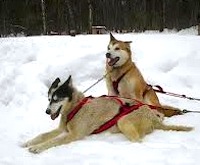







 took
their first steps on grass.
took
their first steps on grass. unknown
and it is possible that the dogs might develop cancer or some sort of
illnesses at a certain point in life. Potential adopters are all alerted
to this possibility, but that hasn't stopped people from reaching out
and wanting to take in another Beagle -- thought to be an ideal testing
dog because of the docile temperament and average size -- as Keith and
her animal advocacy friends and colleagues continue to rescue more dogs.
unknown
and it is possible that the dogs might develop cancer or some sort of
illnesses at a certain point in life. Potential adopters are all alerted
to this possibility, but that hasn't stopped people from reaching out
and wanting to take in another Beagle -- thought to be an ideal testing
dog because of the docile temperament and average size -- as Keith and
her animal advocacy friends and colleagues continue to rescue more dogs.






 parasite.
A canine cancer gained the ability to spread from one dog to the next,
creating new tumors along the way.
parasite.
A canine cancer gained the ability to spread from one dog to the next,
creating new tumors along the way.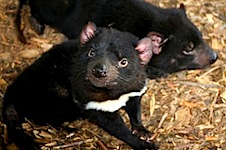 Scientists
have discovered only one other case of infectious cancer. Tasmanian
devils (right) can become infected by a facial tumor when they
bite each other. Researchers have proposed that the Tasmanian devils
are vulnerable to the cancers
Scientists
have discovered only one other case of infectious cancer. Tasmanian
devils (right) can become infected by a facial tumor when they
bite each other. Researchers have proposed that the Tasmanian devils
are vulnerable to the cancers  because
they have little genetic variability. Tumors may be too similar to a
devil’s own cells to be rejected.
because
they have little genetic variability. Tumors may be too similar to a
devil’s own cells to be rejected.
 source
of DNA in the tumors. Every animal cell contains structures called mitochondria
(below left) that produce the cell’s fuel. Mitochondria also contain
a small amount of their own DNA (below right).
source
of DNA in the tumors. Every animal cell contains structures called mitochondria
(below left) that produce the cell’s fuel. Mitochondria also contain
a small amount of their own DNA (below right). because
their own mitochondria would acquire mutations, making them worse at
generating fuel. Cells that upgraded their mitochondria could grow faster.
“This paper is very interesting and exciting,” said Elizabeth
Murchison, a geneticist at the Wellcome Trust Sanger
Institute in Britain. Dr. Murchison is currently sequencing
the entire C.T.V.T. genome and expects to finish the project later this
year.
because
their own mitochondria would acquire mutations, making them worse at
generating fuel. Cells that upgraded their mitochondria could grow faster.
“This paper is very interesting and exciting,” said Elizabeth
Murchison, a geneticist at the Wellcome Trust Sanger
Institute in Britain. Dr. Murchison is currently sequencing
the entire C.T.V.T. genome and expects to finish the project later this
year.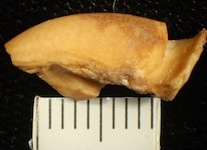
 confirmed
domesticated dog in the Americas. Samuel Belknap III,
a graduate student at the University of Maine, came
across the fragment while analyzing a dried-out sample of human waste
unearthed in southwest Texas in the 1970s. A carbon-dating test put
the age of the bone at 9,400 years, and a DNA analysis confirmed
it came from a dog — not a wolf, coyote or fox, Mr. Belknap
said. Because it was found deep inside a pile of human excrement and
was the characteristic orange-brown color that bone turns when it has
passed through the digestive tract, the fragment provides the earliest
direct evidence that dogs were eaten by humans and may even have been
bred as a food source, he said. “It just so happens this person
who lived 9,400 years ago was eating dog,” Mr. Belknap said.
confirmed
domesticated dog in the Americas. Samuel Belknap III,
a graduate student at the University of Maine, came
across the fragment while analyzing a dried-out sample of human waste
unearthed in southwest Texas in the 1970s. A carbon-dating test put
the age of the bone at 9,400 years, and a DNA analysis confirmed
it came from a dog — not a wolf, coyote or fox, Mr. Belknap
said. Because it was found deep inside a pile of human excrement and
was the characteristic orange-brown color that bone turns when it has
passed through the digestive tract, the fragment provides the earliest
direct evidence that dogs were eaten by humans and may even have been
bred as a food source, he said. “It just so happens this person
who lived 9,400 years ago was eating dog,” Mr. Belknap said.
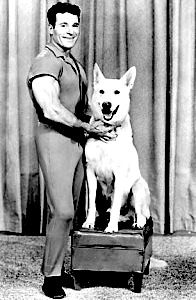 Jack
LaLanne was such a vital life force that it’s hard to believe
he’s gone. A
Jack
LaLanne was such a vital life force that it’s hard to believe
he’s gone. A  pioneer
of the take-control-of-your-health movement, his strong, muscular, age-defying
physique was his own greatest advertisement; he once joked, “I
can’t die – it would ruin my image.”
pioneer
of the take-control-of-your-health movement, his strong, muscular, age-defying
physique was his own greatest advertisement; he once joked, “I
can’t die – it would ruin my image.”



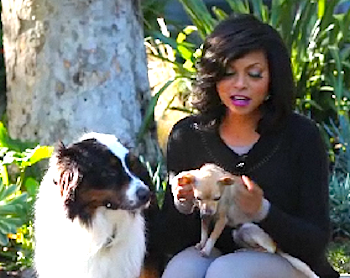
 dog's
special day with celebrations.
dog's
special day with celebrations. She
recently celebrated her pet's third birthday at a dog-friendly watering
She
recently celebrated her pet's third birthday at a dog-friendly watering
 hole,
"Drop Off Service," in Manhattan's
East Village. The birthday dog, along with eight guest, spent
a snowy, Sunday afternoon lapping up homemade "pup cakes"
made of oats, carrots and cream cheese, while beer and hors d'oeuvres
were served to their owners.
hole,
"Drop Off Service," in Manhattan's
East Village. The birthday dog, along with eight guest, spent
a snowy, Sunday afternoon lapping up homemade "pup cakes"
made of oats, carrots and cream cheese, while beer and hors d'oeuvres
were served to their owners.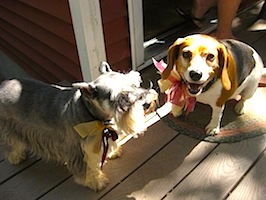 birthday
cake orders during the past few years, and the numbers are steadily
growing."
birthday
cake orders during the past few years, and the numbers are steadily
growing."
 owners.
"Not only do the dogs love the attention, but their owners also
seem to get a lot out of the parties," Moore said. "Some people
may appear shy at first, but something about the sheer joy of the event
brings them out of their shell."
owners.
"Not only do the dogs love the attention, but their owners also
seem to get a lot out of the parties," Moore said. "Some people
may appear shy at first, but something about the sheer joy of the event
brings them out of their shell."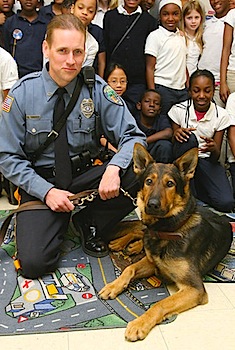 a
full recovery and return to work.
a
full recovery and return to work. crossed
that he keeps moving in that direction."
crossed
that he keeps moving in that direction." to
the search that began a month ago.
to
the search that began a month ago.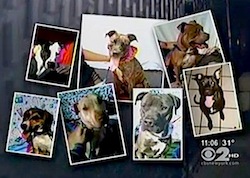 Roesser
credits teamwork by volunteers — specifically two woman from Long
Island — who volunteered their time and posted fliers.
Roesser
credits teamwork by volunteers — specifically two woman from Long
Island — who volunteered their time and posted fliers.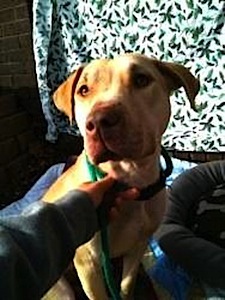 bull
terrier has been recovered and is staying with a foster family
until she is permanently adopted. Brooklyn, a one-year-old male pit
bull terrier, is still missing.
bull
terrier has been recovered and is staying with a foster family
until she is permanently adopted. Brooklyn, a one-year-old male pit
bull terrier, is still missing.
 Cattery
in Lower Halstow, near Sittingbourne, in Kent
- but brought the pooch back 48 hours later.
Cattery
in Lower Halstow, near Sittingbourne, in Kent
- but brought the pooch back 48 hours later.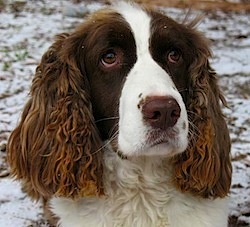 authorities
said they found her dog chained to a tree and covered in feces on
authorities
said they found her dog chained to a tree and covered in feces on  Friday,
January 21.
Friday,
January 21. three
tumors were discovered. One of the tumors was reportedly on Cocoa's
foot and was bleeding. Despite his ailments, Cocoa has a sunny disposition,
according to LaPlume.
three
tumors were discovered. One of the tumors was reportedly on Cocoa's
foot and was bleeding. Despite his ailments, Cocoa has a sunny disposition,
according to LaPlume.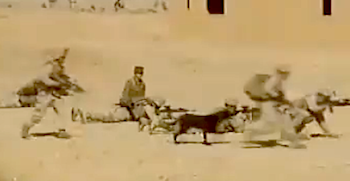 dedicated
members involved-- a black lab who inadvertently set off an explosive.
dedicated
members involved-- a black lab who inadvertently set off an explosive.

 straight
year.
straight
year. The German Shepherd
is ranked second, with the Yorkshire
Terrier
third, the Beagle
fourth and Golden
Retriever fifth.
The German Shepherd
is ranked second, with the Yorkshire
Terrier
third, the Beagle
fourth and Golden
Retriever fifth.





 people
during his sensitive period for socialization and beyond. From three
weeks to three months of age, puppies are primed to explore and form
bonds. Such that if they meet and greet all types of people in many
types of environments and good things happen to them simultaneously,
they generalize to understand that people overall are friendly. Then
if this socialization continues through their adolescence, the relaxed
demeanor around people becomes part of their overall personality. Those
dogs who didn't get the type and amount of experiences they needed given
their individual genetic make-up and early experience can end up being
fearful around some or all unfamiliar people
people
during his sensitive period for socialization and beyond. From three
weeks to three months of age, puppies are primed to explore and form
bonds. Such that if they meet and greet all types of people in many
types of environments and good things happen to them simultaneously,
they generalize to understand that people overall are friendly. Then
if this socialization continues through their adolescence, the relaxed
demeanor around people becomes part of their overall personality. Those
dogs who didn't get the type and amount of experiences they needed given
their individual genetic make-up and early experience can end up being
fearful around some or all unfamiliar people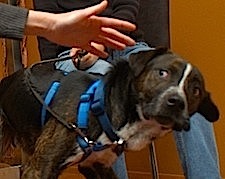 Of
course people inadvertently make the problem much worse. For one, they
forget the Golden Rule - ask to pet, first. Instead,
well-wishers approach too quickly, crowd too closely or loom over like
a thunderstorm ready to dump its load. Under this pressure some dogs
will freeze or shrink, pretending it's all a bad dream. Others take
action - usually a reflex bark or low-level growl. A few successes here,
and the message is loud and clear: when strangers approach, growl and
bark to keep them away. Pretty soon, your sweet, slightly insecure dog
has turned into a mass of defensive rumbling.
Of
course people inadvertently make the problem much worse. For one, they
forget the Golden Rule - ask to pet, first. Instead,
well-wishers approach too quickly, crowd too closely or loom over like
a thunderstorm ready to dump its load. Under this pressure some dogs
will freeze or shrink, pretending it's all a bad dream. Others take
action - usually a reflex bark or low-level growl. A few successes here,
and the message is loud and clear: when strangers approach, growl and
bark to keep them away. Pretty soon, your sweet, slightly insecure dog
has turned into a mass of defensive rumbling.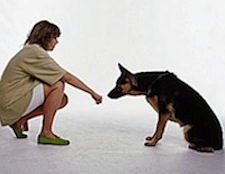 let
him sniff you hand or to pet him he may feel threatened or be unsure
of your intentions. To him, your hand might as well be a meat cleaver.
let
him sniff you hand or to pet him he may feel threatened or be unsure
of your intentions. To him, your hand might as well be a meat cleaver. Read
the Dog's Signals
Read
the Dog's Signals What
to Do if You See Signs of Fear
What
to Do if You See Signs of Fear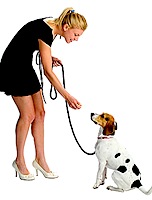
 What
Body Language Indicates the Dog is Safe?
What
Body Language Indicates the Dog is Safe?
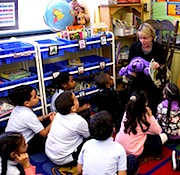 By
WENDY DIAMOND
By
WENDY DIAMOND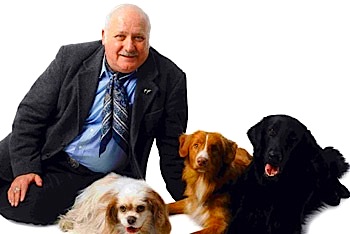 In
his book “The Modern Dog,” renowned psychologist
and dog expert Stanley Coren (left) states, “Pets
provide children the opportunity to
In
his book “The Modern Dog,” renowned psychologist
and dog expert Stanley Coren (left) states, “Pets
provide children the opportunity to 
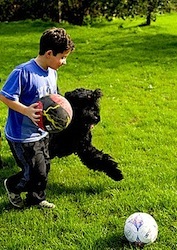 Perfect
playmate: There’s no better way to encourage your
athletic child to flex his muscles than with an equally athletic breed
such as Labrador retrievers.
They’ll want to be included in just about every
physical activity your child partakes in, from fetching to swimming.
Boxers are
also wildly athletic, and are known for having a strong bond with children
of all ages. For smaller-sized athletic dogs, Coren suggests
cocker spaniels.
Perfect
playmate: There’s no better way to encourage your
athletic child to flex his muscles than with an equally athletic breed
such as Labrador retrievers.
They’ll want to be included in just about every
physical activity your child partakes in, from fetching to swimming.
Boxers are
also wildly athletic, and are known for having a strong bond with children
of all ages. For smaller-sized athletic dogs, Coren suggests
cocker spaniels.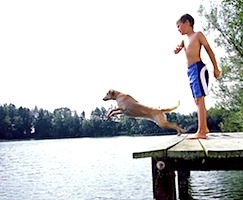
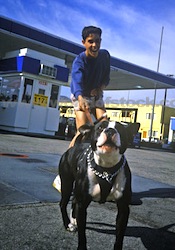 just
one “parent,” usually an adult.
just
one “parent,” usually an adult.
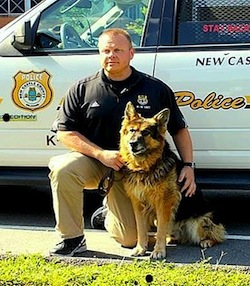 the
American Kennel Club’s (AKC) 2010 Award for Canine Excellence
(ACE) at the AKC/Eukanuba World Championship Show.
The show was held in Long Beach, California, on Dec. 4th and 5th and
nationally televised on Sunday, January 23rd on ABC.
the
American Kennel Club’s (AKC) 2010 Award for Canine Excellence
(ACE) at the AKC/Eukanuba World Championship Show.
The show was held in Long Beach, California, on Dec. 4th and 5th and
nationally televised on Sunday, January 23rd on ABC.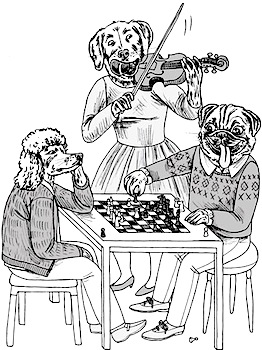 of
more than 1,000 objects and can retrieve them on command.
of
more than 1,000 objects and can retrieve them on command. Mother,”
a book that promotes fierce, relentless and demanding parenting, and
also talks about her love for her dogs.
Mother,”
a book that promotes fierce, relentless and demanding parenting, and
also talks about her love for her dogs. psychology
professor at Wofford College in Spartanburg, S.C., was working
four or five hours a day, year after year, in dedicated Chinese-mother
fashion to teach Chaser the names of 1,022 objects.
psychology
professor at Wofford College in Spartanburg, S.C., was working
four or five hours a day, year after year, in dedicated Chinese-mother
fashion to teach Chaser the names of 1,022 objects. do
better than anyone else’s, might be tempted to chant, “Nyah
nyah nyah, his dog’s smarter than yours.”
do
better than anyone else’s, might be tempted to chant, “Nyah
nyah nyah, his dog’s smarter than yours.” we've
talked about cold weather pet care, and suggested some ways to beat
the blizzard blues this season. But what if your pet just needs a comfy
bed or coat to stay warm indoors or out? If your furry friend could
use an extra layer, we've rounded up some of our favorite gear for keeping
your pet snuggly and safe through the winter.
we've
talked about cold weather pet care, and suggested some ways to beat
the blizzard blues this season. But what if your pet just needs a comfy
bed or coat to stay warm indoors or out? If your furry friend could
use an extra layer, we've rounded up some of our favorite gear for keeping
your pet snuggly and safe through the winter.
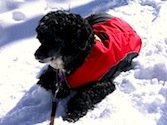

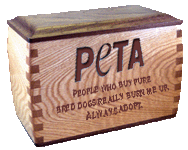 heisted
and snorted was not the drug, but a dead man's ashes.
heisted
and snorted was not the drug, but a dead man's ashes. 18
(pictured right), and Jose David Diaz Marrero, 19.
They each face multiple charges.
18
(pictured right), and Jose David Diaz Marrero, 19.
They each face multiple charges.
 outside
the villages of Native Americans. This full moon is also known as the
Old Moon or the Moon After Yule.
outside
the villages of Native Americans. This full moon is also known as the
Old Moon or the Moon After Yule. The
tribes kept track of the seasons by giving distinctive names to each
recurring full Moon. Their names were applied to the entire month in
which each occurred. There was some variation in the Moon names, but
in general, the same ones were current throughout the Algonquin
tribes from New England to Lake Superior.
European settlers followed that custom and created some of their own
names.
The
tribes kept track of the seasons by giving distinctive names to each
recurring full Moon. Their names were applied to the entire month in
which each occurred. There was some variation in the Moon names, but
in general, the same ones were current throughout the Algonquin
tribes from New England to Lake Superior.
European settlers followed that custom and created some of their own
names. 
 daughter's
"singing" dog violates the Bronx building's no-pets policy.
daughter's
"singing" dog violates the Bronx building's no-pets policy. But
the Hymans argued that the dog did not live with them and therefore
wasn't breaking the rules.
But
the Hymans argued that the dog did not live with them and therefore
wasn't breaking the rules. Eric
Kahan, the lawyer for Bonnie House (right, smug), said
the appeals court made the right decision. "We believe that the
argument that Julie owns the dog is the Hymans' transparent effort to
get around the building's rules," he told the Daily News.
Eric
Kahan, the lawyer for Bonnie House (right, smug), said
the appeals court made the right decision. "We believe that the
argument that Julie owns the dog is the Hymans' transparent effort to
get around the building's rules," he told the Daily News.


 hobbled
from years of exercise and competition.
hobbled
from years of exercise and competition. That
sentiment is familiar to Dr. Pamela Schwartz (right),
who specializes in soft tissue and orthopedic surgery at the Animal
Medical Center in Manhattan. “Many people treat their
dogs as if they were their own children,” she said. “So
when it comes to the health of their dogs, owners are more inclined
than ever before to seek out specialized care.”
That
sentiment is familiar to Dr. Pamela Schwartz (right),
who specializes in soft tissue and orthopedic surgery at the Animal
Medical Center in Manhattan. “Many people treat their
dogs as if they were their own children,” she said. “So
when it comes to the health of their dogs, owners are more inclined
than ever before to seek out specialized care.”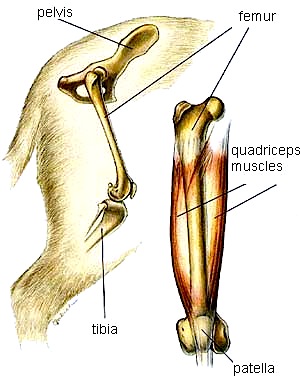
 “This
is a relatively new science,” said Dr. William D. Liska,
a veterinary orthopedic surgeon based in Houston who performed
the first micro-hip replacement there in April 2005 on a Shetland sheepdog
named Champ. Two months later, Liska made an international house call
in Helsinki, Finland, to perform the first knee replacement on a Karelian
bear dog named Jere, a national moose hunting champion, as part of clinical
trials for the prosthetics. Total knee replacements became available
for all dogs in 2007.
“This
is a relatively new science,” said Dr. William D. Liska,
a veterinary orthopedic surgeon based in Houston who performed
the first micro-hip replacement there in April 2005 on a Shetland sheepdog
named Champ. Two months later, Liska made an international house call
in Helsinki, Finland, to perform the first knee replacement on a Karelian
bear dog named Jere, a national moose hunting champion, as part of clinical
trials for the prosthetics. Total knee replacements became available
for all dogs in 2007.
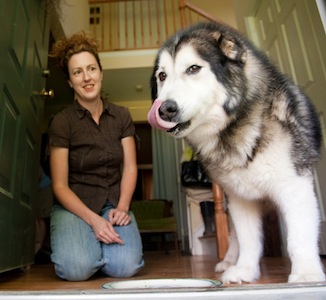 The
Alaskan malamute, a 12-year-old who bounced into the
kitchen like a puppy, followed that with a main course of ground raw
chicken necks and livers, red cabbage, cucumbers, carrots, berries,
garlic and parsley, formed into tidy patties. He licked it off a plate
embellished in blue and green flowers.
The
Alaskan malamute, a 12-year-old who bounced into the
kitchen like a puppy, followed that with a main course of ground raw
chicken necks and livers, red cabbage, cucumbers, carrots, berries,
garlic and parsley, formed into tidy patties. He licked it off a plate
embellished in blue and green flowers.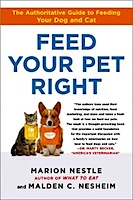
 Sales
of organic pet food were $84 million in 2009, and have grown more than
tenfold since 2002, according to the Organic Trade Association.
The group reported a sales increase of 48 percent in 2008, the year
after several brands of cat and dog food were recalled for melamine
contamination.
Sales
of organic pet food were $84 million in 2009, and have grown more than
tenfold since 2002, according to the Organic Trade Association.
The group reported a sales increase of 48 percent in 2008, the year
after several brands of cat and dog food were recalled for melamine
contamination.



 who
treats animals at the school’s teaching hospital, said she was
not against people cooking for their pets. In fact, she said she prescribes
such diets for some of the animals she treats. But she cautioned that
if it was not done correctly, the consequences could be harmful.
who
treats animals at the school’s teaching hospital, said she was
not against people cooking for their pets. In fact, she said she prescribes
such diets for some of the animals she treats. But she cautioned that
if it was not done correctly, the consequences could be harmful. Dr.
Wakshlag, who feeds his English mastiff, his Stabyhound,
his seven Alaskan sled dogs and his two domestic short hairs various
commercial foods, said that any diet must meet the caloric requirements
of the individual animal, which varies according to weight. And there
are differences in dietary requirements for cats and dogs.
Dr.
Wakshlag, who feeds his English mastiff, his Stabyhound,
his seven Alaskan sled dogs and his two domestic short hairs various
commercial foods, said that any diet must meet the caloric requirements
of the individual animal, which varies according to weight. And there
are differences in dietary requirements for cats and dogs.
 She feeds a mix of lentils, rice, kale, carrots, apples, oats, tofu,
vegetable oil, a textured vegetable protein (a soy-based dehydrated
product used as a meat substitute) and mineral and vitamin supplements.
The dogs, fed on this diet since 1999, appear to be thriving. “No
one would think they are as old as they are,” she said. “The
beagle — we call her the Tank because
she is so energetic.”
She feeds a mix of lentils, rice, kale, carrots, apples, oats, tofu,
vegetable oil, a textured vegetable protein (a soy-based dehydrated
product used as a meat substitute) and mineral and vitamin supplements.
The dogs, fed on this diet since 1999, appear to be thriving. “No
one would think they are as old as they are,” she said. “The
beagle — we call her the Tank because
she is so energetic.” knows
1,022 proper nouns, a record that displays unexpected
depths of the canine mind and may help explain how children acquire
language.
knows
1,022 proper nouns, a record that displays unexpected
depths of the canine mind and may help explain how children acquire
language.
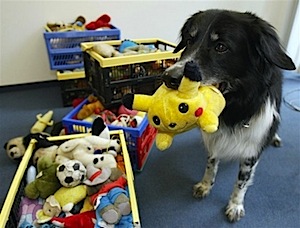 One
of Dr. Pilley’s goals was to see if he could teach Chaser a larger
vocabulary than Rico (right) acquired. But that vocabulary
is based on physical objects that must be given a name the dog can recognize.
Dr. Pilley found himself visiting Salvation Army stores and buying up
sackfuls of used children’s toys to serve as vocabulary items.
One
of Dr. Pilley’s goals was to see if he could teach Chaser a larger
vocabulary than Rico (right) acquired. But that vocabulary
is based on physical objects that must be given a name the dog can recognize.
Dr. Pilley found himself visiting Salvation Army stores and buying up
sackfuls of used children’s toys to serve as vocabulary items. Dr.
Pilley does not know how large a vocabulary Chaser could have mastered.
When she reached 1,000 items, he grew tired of teaching
words and moved to more interesting topics like grammar.
Dr.
Pilley does not know how large a vocabulary Chaser could have mastered.
When she reached 1,000 items, he grew tired of teaching
words and moved to more interesting topics like grammar.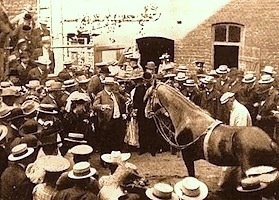 Haunting
almost every interaction between people and animals is the ghost of
Clever Hans, a German horse that in the early 1900s would tap
out answers to arithmetic problems with his hoof. The psychologist Oskar
Pfungst discovered that Hans would get the answer right only if the
questioner also knew the answer. He then showed that the horse could
detect minute movements of the questioner’s head and body. Since
viewers would tense as Hans approached the right number of taps, and
relax when he reached it, the horse knew exactly when to stop.
Haunting
almost every interaction between people and animals is the ghost of
Clever Hans, a German horse that in the early 1900s would tap
out answers to arithmetic problems with his hoof. The psychologist Oskar
Pfungst discovered that Hans would get the answer right only if the
questioner also knew the answer. He then showed that the horse could
detect minute movements of the questioner’s head and body. Since
viewers would tense as Hans approached the right number of taps, and
relax when he reached it, the horse knew exactly when to stop.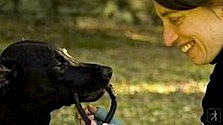 “Watch
a collie work with a sheepherder and you will come away amazed how small
a gesture the person can do to communicate with his dog,” said
Alexandra Horowitz, a dog behavior expert at Barnard College
and author of “Inside
of a Dog.”
“Watch
a collie work with a sheepherder and you will come away amazed how small
a gesture the person can do to communicate with his dog,” said
Alexandra Horowitz, a dog behavior expert at Barnard College
and author of “Inside
of a Dog.”
 As
with other animals for which prodigious feats of cognition have been
reported, like Alex the gray parrot (left) or Kanzi
the bonobo (right), it is hard to place Chaser’s and
Rico’s abilities in context. If their achievements are within
the general capacity of their species, why have many other instances
not been reported? If, on the other hand, their achievements are unique,
then either the researchers have lucked out in finding an Einstein
of the species, or there could be something wrong with the experiments
like a Clever Hans effect.
As
with other animals for which prodigious feats of cognition have been
reported, like Alex the gray parrot (left) or Kanzi
the bonobo (right), it is hard to place Chaser’s and
Rico’s abilities in context. If their achievements are within
the general capacity of their species, why have many other instances
not been reported? If, on the other hand, their achievements are unique,
then either the researchers have lucked out in finding an Einstein
of the species, or there could be something wrong with the experiments
like a Clever Hans effect.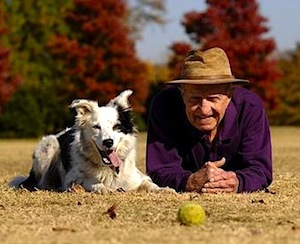
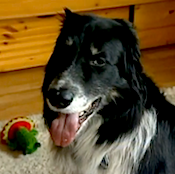
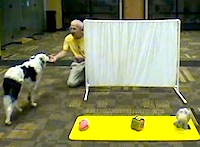 During
one part of the experiment, a barrier was placed between the researchers
and the objects, likely to help ensure that no visual cues were directing
Chaser to the requested toys. In another test, the toys were placed
in a different room to further demonstrate how the words alone were
directing the dog to the right toys. Reid says that out of 838 such
tests over the 3-year period, Chaser never got less than 18
out of 20 right. A related study was published in the November
issue of Behavioural Processes.
During
one part of the experiment, a barrier was placed between the researchers
and the objects, likely to help ensure that no visual cues were directing
Chaser to the requested toys. In another test, the toys were placed
in a different room to further demonstrate how the words alone were
directing the dog to the right toys. Reid says that out of 838 such
tests over the 3-year period, Chaser never got less than 18
out of 20 right. A related study was published in the November
issue of Behavioural Processes. Edita Nazaraite
Edita Nazaraite more
per year, but cats make up for it by living longer.) What does he get
for this investment?
more
per year, but cats make up for it by living longer.) What does he get
for this investment?
 Despite the importance of pets in our lives, researchers in the health
and behavioral sciences have, until recently, largely neglected the
study of human-animal relationships. But this is changing. In 2008,
the National Institutes of Health (in conjunction with Mars, the corporate
giant whose products include pet food) began a multimillion-dollar research
initiative that will eventually help separate fact from wishful thinking
on how pets influence human health and happiness.
Despite the importance of pets in our lives, researchers in the health
and behavioral sciences have, until recently, largely neglected the
study of human-animal relationships. But this is changing. In 2008,
the National Institutes of Health (in conjunction with Mars, the corporate
giant whose products include pet food) began a multimillion-dollar research
initiative that will eventually help separate fact from wishful thinking
on how pets influence human health and happiness.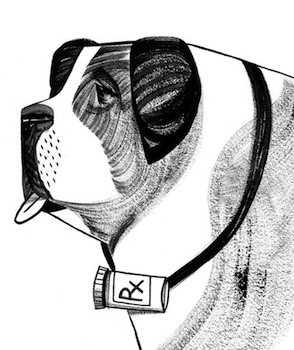 As
a science-based organization, the American Veterinary Medical
Association acknowledges the ambiguity of the science available
to analyze the contributions of pets to human health cited in the article.
As
a science-based organization, the American Veterinary Medical
Association acknowledges the ambiguity of the science available
to analyze the contributions of pets to human health cited in the article.
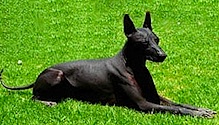 companion.
companion.


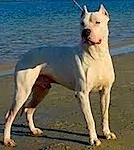

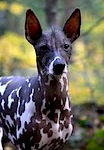



 the
annals of Third Reich history as consequential, but
it is has given people here a reason to laugh, not at the nation’s
sinister deeds but at those who were responsible.
the
annals of Third Reich history as consequential, but
it is has given people here a reason to laugh, not at the nation’s
sinister deeds but at those who were responsible.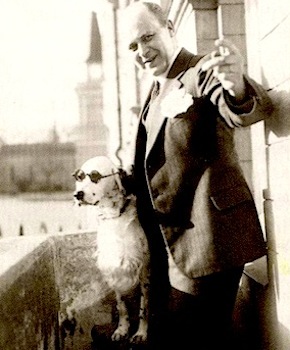 The
combined reports in national newspapers led last week to yet another
round of Nazi-related headlines, though the one about the dog offered
the unusual respite of a Nazi-era action that sounded like a punch line.
The
combined reports in national newspapers led last week to yet another
round of Nazi-related headlines, though the one about the dog offered
the unusual respite of a Nazi-era action that sounded like a punch line. the
German Foreign Ministry when a friend tipped him to their existence.
Mr. Hillenbrand said he decided to make the affair public as part of
his decades of work highlighting Nazi-era crimes in books and articles,
and that this was not intended to be flip.
the
German Foreign Ministry when a friend tipped him to their existence.
Mr. Hillenbrand said he decided to make the affair public as part of
his decades of work highlighting Nazi-era crimes in books and articles,
and that this was not intended to be flip. a
multitude of archival documents, in particular from archives of the
former Eastern bloc, came to light,” said Johannes Tuchel
(right), head of the German Resistance Memorial Center.
a
multitude of archival documents, in particular from archives of the
former Eastern bloc, came to light,” said Johannes Tuchel
(right), head of the German Resistance Memorial Center.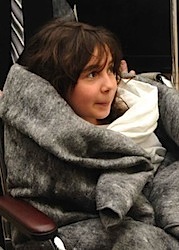 friend's
dog -- but was heroically rescued by emergency responders.
friend's
dog -- but was heroically rescued by emergency responders.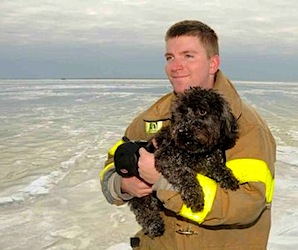 Firefighter
Chris Gonzalez threw them a rope and pulled them to safety.
Firefighter
Chris Gonzalez threw them a rope and pulled them to safety.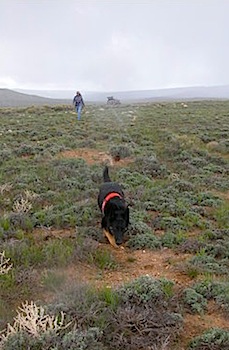 wildlife
area.
wildlife
area. The
landscape in Rye, New York is barren and bleak and covered in a blanket
of snow. For coyotes, it is the lean season and a time to endure
and survive, according to one wildlife expert.
The
landscape in Rye, New York is barren and bleak and covered in a blanket
of snow. For coyotes, it is the lean season and a time to endure
and survive, according to one wildlife expert.
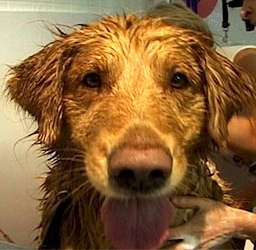
 We
need to get going because there’s no way I’m going to read
more than one a month. Let’s begin today with the newest entry
out of the chute: “Courage to Stand: An American Story,”
by Tim Pawlenty [former governor of Minnesota]
We
need to get going because there’s no way I’m going to read
more than one a month. Let’s begin today with the newest entry
out of the chute: “Courage to Stand: An American Story,”
by Tim Pawlenty [former governor of Minnesota]

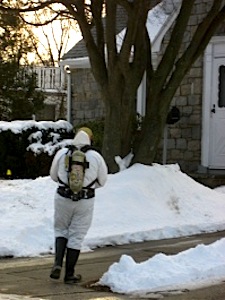 What
our officers saw was one of the most horrific, horrendous scenes we
have ever seen in the history of our animal shelter,” Murray said.
What
our officers saw was one of the most horrific, horrendous scenes we
have ever seen in the history of our animal shelter,” Murray said.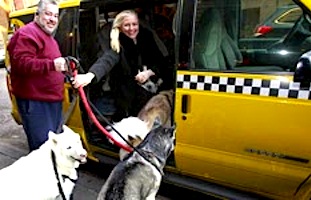
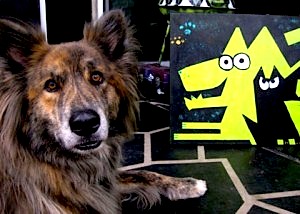 Loughner
volunteered at the facility in January and February last year as a dog
walker. In his application, Mr. Loughner wrote that he was interested
in volunteering at the center for “community service, fun, reference
and experience.”
Loughner
volunteered at the facility in January and February last year as a dog
walker. In his application, Mr. Loughner wrote that he was interested
in volunteering at the center for “community service, fun, reference
and experience.” our
rules.”
our
rules.”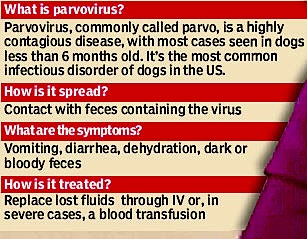
 the
shooting of Congresswoman Gabrielle Giffords.
the
shooting of Congresswoman Gabrielle Giffords.
 eats
home-cooked meals every night. He drinks filtered water and wears expensive
little sweaters. His baby picture was published in a national magazine.
eats
home-cooked meals every night. He drinks filtered water and wears expensive
little sweaters. His baby picture was published in a national magazine. Weird
but true
Weird
but true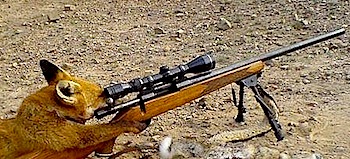 A
hunter in Belarus shot a fox, and the woodland creature shot back.
A
hunter in Belarus shot a fox, and the woodland creature shot back.
 You’re
not the only one. It seems Fido is getting a little flabby.
You’re
not the only one. It seems Fido is getting a little flabby.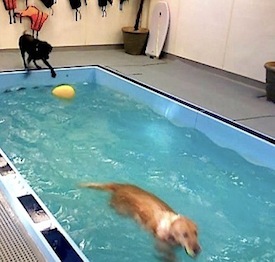 After getting limber with some downward-facing dog, it’s time
for that treadmill.
After getting limber with some downward-facing dog, it’s time
for that treadmill.
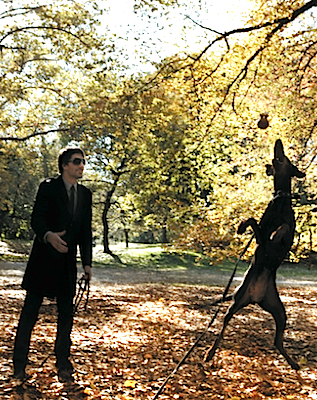 To
be Henrik
Lundqvist
is to suit up. When the Swedish-born goaltender
of the New York Rangers isn’t sporting
Blueshirt No. 30, he may wear a dapper three-piece number. On Sundays,
though, Mr. Lundqvist, 28 — who won a gold medal in the
2006 Winter Olympics blocking pucks for Sweden’s
national hockey team — dresses down, relaxing at the
movies or playing his guitar. He lives with his fiancée,
Therese Andersson, 28, and their 4-year-old Doberman,
Nova, in a two-bedroom duplex in the West 50s with a terrace
and a hot tub.
To
be Henrik
Lundqvist
is to suit up. When the Swedish-born goaltender
of the New York Rangers isn’t sporting
Blueshirt No. 30, he may wear a dapper three-piece number. On Sundays,
though, Mr. Lundqvist, 28 — who won a gold medal in the
2006 Winter Olympics blocking pucks for Sweden’s
national hockey team — dresses down, relaxing at the
movies or playing his guitar. He lives with his fiancée,
Therese Andersson, 28, and their 4-year-old Doberman,
Nova, in a two-bedroom duplex in the West 50s with a terrace
and a hot tub. 
 the
city, entering them in pageants, auditioning them for modeling gigs,
and dressing them up in tutus and designer duds for birthday parties
and charity events.
the
city, entering them in pageants, auditioning them for modeling gigs,
and dressing them up in tutus and designer duds for birthday parties
and charity events. competition
among the moms for whose dog won which contest or got into what paper
or got what TV or modeling gig," Lai and Jones told The
Post via e-mail .
competition
among the moms for whose dog won which contest or got into what paper
or got what TV or modeling gig," Lai and Jones told The
Post via e-mail . end
of the day, they are all friends."
end
of the day, they are all friends."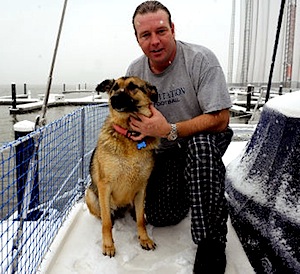
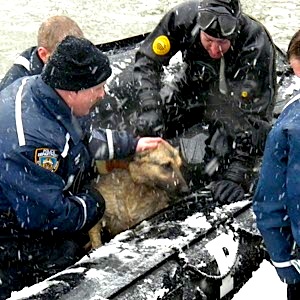 fallen
from the deck of his boat and swam toward the shore, Stoss said. "Her
head was just above the water," he said.
fallen
from the deck of his boat and swam toward the shore, Stoss said. "Her
head was just above the water," he said. where
Chloe was waiting under a piling. Detective Matthew Sherman
(left) pulled on gear and jumped into the 20-foot-deep water,
while Detectives Michael Cocchie and John Drzal
waited aboard the black zodiac with a line to toss. The dog
swam out from the pier and they were able to help her onto the zodiac.
where
Chloe was waiting under a piling. Detective Matthew Sherman
(left) pulled on gear and jumped into the 20-foot-deep water,
while Detectives Michael Cocchie and John Drzal
waited aboard the black zodiac with a line to toss. The dog
swam out from the pier and they were able to help her onto the zodiac.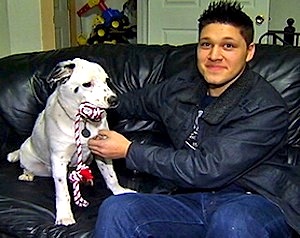 to
make tails wag.
to
make tails wag. plate
number and Elmhurst police later arrested Sergiu E. Muresan
(right), 26, of the 2400 block of Grenshaw Ave. in Chicago. Muresan
has been charged with cruel treatment of an animal, a misdemeanor punishable
by up to one year in jail and a $2,500 fine.
plate
number and Elmhurst police later arrested Sergiu E. Muresan
(right), 26, of the 2400 block of Grenshaw Ave. in Chicago. Muresan
has been charged with cruel treatment of an animal, a misdemeanor punishable
by up to one year in jail and a $2,500 fine.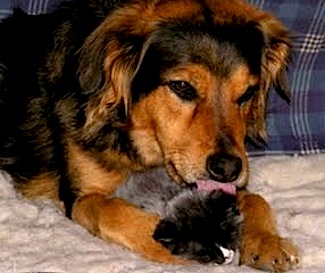 machines.
machines. socialized,"
Ouchida explains. "She has a very, very sweet gentle soul and is
very eager to please. When she gets tired of the kittens, they go after
her and chase her."
socialized,"
Ouchida explains. "She has a very, very sweet gentle soul and is
very eager to please. When she gets tired of the kittens, they go after
her and chase her." night.
night.
 in
the cover of darkness to the shelter, where there are no alarms and
no surveillance cameras.
in
the cover of darkness to the shelter, where there are no alarms and
no surveillance cameras.
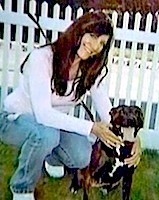 evaluation
and was rescued from a Bronx crack house five years ago. She
evaluation
and was rescued from a Bronx crack house five years ago. She 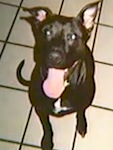 may
need to be rescued again. “This is my child, you know? Not knowing
where she is, now knowing what hands she’s in, not knowing what’s
being done to her is what’s killing me,” Dicey’s owner,
Lisa Connelly (left), told CBS 2's Lou Young.
may
need to be rescued again. “This is my child, you know? Not knowing
where she is, now knowing what hands she’s in, not knowing what’s
being done to her is what’s killing me,” Dicey’s owner,
Lisa Connelly (left), told CBS 2's Lou Young.
 Another
missing dog, named “Jack” (right) had just
been adopted and was about to be picked up. The Beagle
was going to work as a bed bug sniffer for a local company. The young
woman who walked him every day expressed worry about the dogs’
whereabouts.
Another
missing dog, named “Jack” (right) had just
been adopted and was about to be picked up. The Beagle
was going to work as a bed bug sniffer for a local company. The young
woman who walked him every day expressed worry about the dogs’
whereabouts.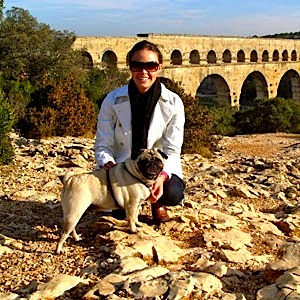 and
Weenie flew out of JFK, bound for San Francisco. They
treated themselves to a first-class ticket, guaranteeing them friendly
service — and netting Weenie a bowl of water and plate of chopped
tomatoes, his favorite.
and
Weenie flew out of JFK, bound for San Francisco. They
treated themselves to a first-class ticket, guaranteeing them friendly
service — and netting Weenie a bowl of water and plate of chopped
tomatoes, his favorite.
 with
feathers or scales), there will be a lot adjusting for the little guy...
and for you as well. So before you drop lots of money at the pet store
to "please" your pet upon setting eyes on your new and strange
home, check out these tips on creating pet-happy homes.
with
feathers or scales), there will be a lot adjusting for the little guy...
and for you as well. So before you drop lots of money at the pet store
to "please" your pet upon setting eyes on your new and strange
home, check out these tips on creating pet-happy homes.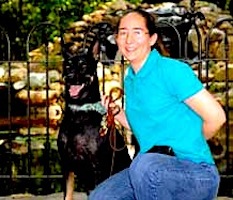 at
the Shelby Humane Society in Alabama.
at
the Shelby Humane Society in Alabama.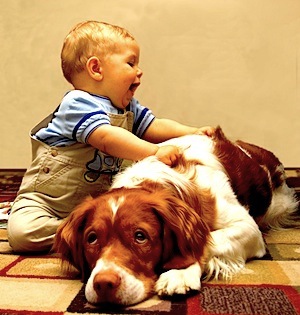 Chances
are, your child has been on pins and needles waiting for the day that
the new dog or kitten comes home.
Chances
are, your child has been on pins and needles waiting for the day that
the new dog or kitten comes home.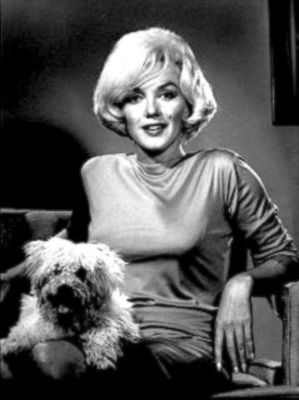 It’s
safe
to say that she struggled with the myth of the American dream. Some
of her family succeeded, some did not. “Everyone needs mazel,”
or luck, she’d say in Yiddish by way of explanation. “Even
the dog.”
It’s
safe
to say that she struggled with the myth of the American dream. Some
of her family succeeded, some did not. “Everyone needs mazel,”
or luck, she’d say in Yiddish by way of explanation. “Even
the dog.”
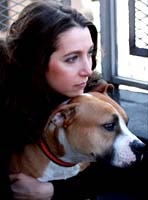 My
resolution for the New Year is to overcome this terrible tendency
I have of letting my dogs walk me. No longer will I allow
myself to be dragged down the street by rambunctious K9s, all
the while enduring the predictably cliche commentary of passing
pedestrians: “Who’s Walking Who?”
indeed. I resolve to be more like the gal in the photo at left:
calm, relaxed, with a brace of big beasts heeling perfectly.
My
resolution for the New Year is to overcome this terrible tendency
I have of letting my dogs walk me. No longer will I allow
myself to be dragged down the street by rambunctious K9s, all
the while enduring the predictably cliche commentary of passing
pedestrians: “Who’s Walking Who?”
indeed. I resolve to be more like the gal in the photo at left:
calm, relaxed, with a brace of big beasts heeling perfectly. Alecia
Evans, a professional dog trainer in Aspen, Colorado, believes
that the tools for dog training have not changed in the last 40
years – and she’s right. “I’ve been training
dogs for ten years, and I got to the point where I got tired of
having to choke dogs to train them. I knew there had to be a better
way.” Evans says that, as a result of the unsafe, inhumane
training tools out there on the market, ”98 percent of the
‘aggressive’ cases I’ve worked with had a spinal
or neck misalignment – so I sent those dogs to a veterinary
chiropractor for realignment before I started rehabilitation training.”
Alecia
Evans, a professional dog trainer in Aspen, Colorado, believes
that the tools for dog training have not changed in the last 40
years – and she’s right. “I’ve been training
dogs for ten years, and I got to the point where I got tired of
having to choke dogs to train them. I knew there had to be a better
way.” Evans says that, as a result of the unsafe, inhumane
training tools out there on the market, ”98 percent of the
‘aggressive’ cases I’ve worked with had a spinal
or neck misalignment – so I sent those dogs to a veterinary
chiropractor for realignment before I started rehabilitation training.”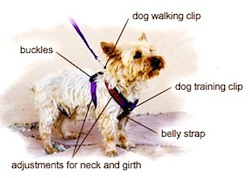
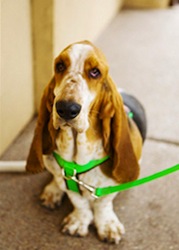 training
tool. There’s no need to choke dogs,” she adds. “The
way I’ve set up the leash, it puts you in the leadership
position with no stress at all, on you or the dog. And it works
with all dogs, from Dachshunds to Dobermans, eight-week-old puppies
to full-grown Bernese Mountain Dogs.”
training
tool. There’s no need to choke dogs,” she adds. “The
way I’ve set up the leash, it puts you in the leadership
position with no stress at all, on you or the dog. And it works
with all dogs, from Dachshunds to Dobermans, eight-week-old puppies
to full-grown Bernese Mountain Dogs.”

 on.
Many of us will resolve to stay away from the office treat table
(we have one here at dogster
for both two- and four-legged workers!). Some of us will vow to
quit smoking, procrastinating or nail biting. But how many of
us will try to be better dog owners? Here's your chance.
on.
Many of us will resolve to stay away from the office treat table
(we have one here at dogster
for both two- and four-legged workers!). Some of us will vow to
quit smoking, procrastinating or nail biting. But how many of
us will try to be better dog owners? Here's your chance.